Paul van Yperen's Blog, page 124
May 22, 2022
Written by Emile Zola
In our series 'Written by ...' today a post with postcards of stage and screen adaptations after the novels by French author Émile Zola (1940-1902). He is considered the most important representative of the literary school of naturalists and is one of the most popular French novelists ever. Zola's literary work was influenced by the works of authors Honoré de Balzac and Gustave Flaubert. In the late nineteenth century, he raised social awareness through his literature. The naturalistic style of his novels such as 'Thérèse Raquin' (1867) and 'Nana' (1880) translated very well to the screen.
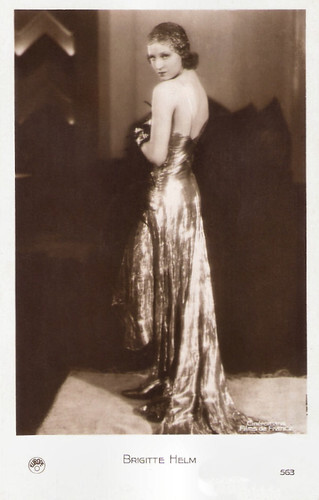
French postcard by Europe, no. 563. Photo: Cinéromans Films de France. Brigitte Helm in L'argent (Marcel L'Herbier, 1928), freely adapted from the novel by Emile Zola.
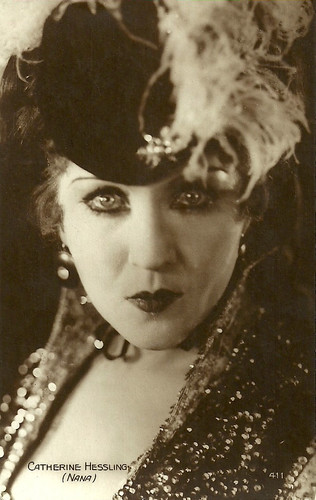
French postcard by Editions Cinémagazine, no. 411. Catherine Hessling as the title character in Nana (Jean Renoir, 1926), based on the homonymous novel (1880) by Emile Zola.
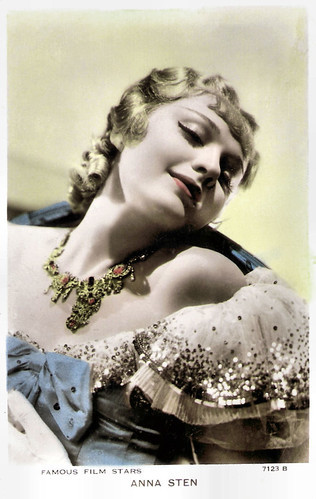
British postcard in the Famous Film Stars Series by Valentine's, no. 7123B. Photo: United Artists. Anna Sten in Nana (Dorothy Arzner, George Fitzmaurice, 1934).
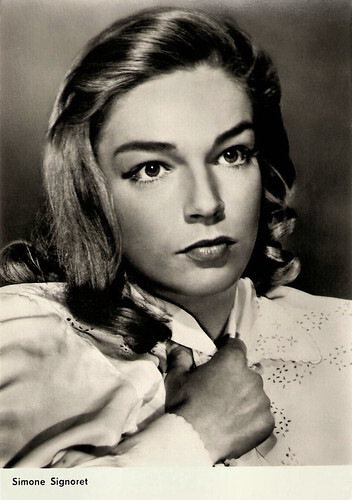
East-German postcard by VEB Progress Film-Vertrieb, nr. 1924. Photo: Simone Signoret in Therese Raquin Thérèse Raquin/The Adultress (Marcel Carné, 1953).
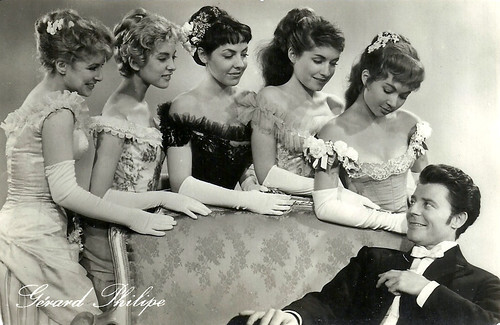
East-German postcard by VEB Progress Filmvertrieb GmbH., Starfoto no. 1288. Gérard Philipe and at right Dany Carel in the Zola adaptation Pot Bouille/Lovers of Paris (Julien Duvivier, 1957), released in Germany as Der schöne Octave.
Writing his true vocation
Émile Édouard Charles Antoine Zola was born in 1840 in Paris. He spent his childhood and school years in Aix-en-Provence, where his father Francesco Zola, of Italian origin, was an engineer. He was implementing a plan for a drinking water supply when he died unexpectedly. Poor years followed for Zola and his mother, Émilie Aubert. In 1858 they went to Paris.
From his earliest youth, Émile Zola was fascinated by literature. He read a great deal and very early on envisaged the idea of writing professionally. From an early age, he considered writing to be his true vocation. In the sixth grade, he already wrote a novel about the Crusades. He told his childhood friends several times in his letters that one day he would be a recognised writer.
Zola failed his baccalauréat (bachelopr of sciences) twice in 1859. These failures left a deep impression on the young man, who despaired of having disappointed his mother. He was also aware that, without a diploma, he would face serious material difficulties. In Paris, he became friends with Édouard Manet and other painters of the Impressionist movement. Manet depicted him several times in his paintings, and through Manet, he came into contact with the poet Stéphane Mallarmé.
In 1862, Zola found a job in the publicity department of the publishing house Hachette. There he met writers and became familiar with the practical side of being a writer. He learned all the techniques of books and their marketing. He also published as a journalist in various magazines. As a critic, he was particularly harsh on the official Salon jury when 'The Flute Player' by Manet was rejected. He would also become a fervent defender of impressionism.
Zola managed to get his first book published by Hetzel: 'Les Contes à Ninon' (1864). He became famous with novels such as 'Germinal', 'Nana' and the enormous success, 'L'Assommoir' (1877), which are part of the great cycle 'Les Rougon-Macquart'. 'Les Rougon-Macquart'is a twenty-volume novelistic fresco depicting French society under the Second Empire, which follows the trajectory of the Rougon-Macquart family through its different generations, each of whose representatives, from a particular period and generation, is the subject of a novel.
In 'l'Oeuvre' (1886), he depicts the tragic life of a painter, a character largely inspired by Paul Cézanne, a childhood friend of Zola's from Aix-en-Provence. Cézanne had introduced him to the graphic arts, and more particularly to painting. After receiving this novel, Cézanne abruptly ended their friendship, which had not been very intense for some time.
Zola's open letter to President Félix Faure in L'Aurore of 13 January 1898 under the title 'J'accuse...!' was also famous. In this letter about the Dreyfus affair, he sides with the Jewish captain Alfred Dreyfus, who was unjustly accused of espionage. Zola accused the French General Staff of producing evidence. Zola was sentenced for libel to one year in prison and a 3000 Francs fine, which was paid for him by Octave Mirbeau. On the advice of friends, Zola did not wait for the appeal and fled to Britain. After a year he was able to return and was received as a hero.
Zola married Alexandrine 'Gabrielle' Meley in 1870, a working-class woman who had been a model for Impressionist painters such as Manet. She introduced him to the people on the fringes of society in Paris. She also organised weekly literary dinners for Zola to further his career. Zola also had a mistress, Jeanne Rozerot, who was the family laundress. While his marriage remained childless, he and Jeanne had two children.
Émile Zola died unexpectedly in Paris in 1902 at his home on the Rue de Bruxelles due to carbon monoxide poisoning. According to Philipp Blom, a roofer confessed to placing a piece of wood on the chimney to kill the writer in revenge for his defense of the Jewish captain. In 1908, his body was transferred to the Panthéon.
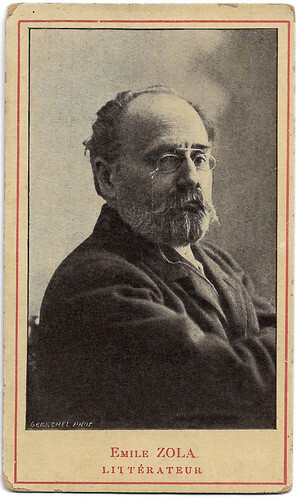
French card. Photo: Gerschel. Emile Zola.
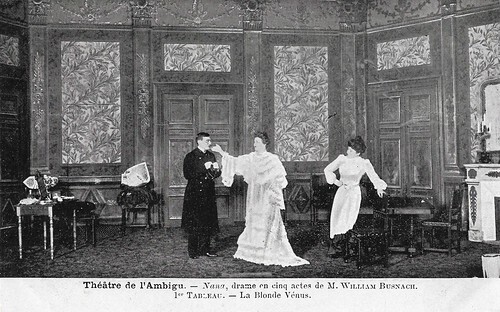
Vintage French postcard. Scene from the play 'Nanà' by William Busnach, a play in five acts adapted from the novel by Emile Zola. Théâtre de l'Ambigu, Paris. Tableau 1, The Blonde Venus. The play was first performed at the Théâtre de l'Ambigu on 6 February 1904. Nanâ was played by Armande Cassive.
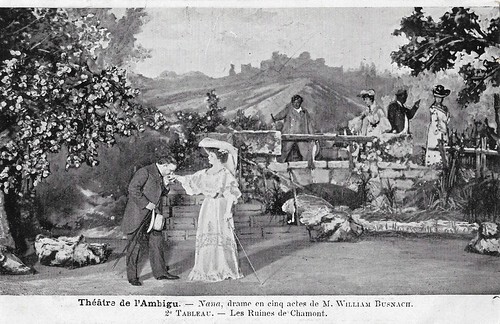
Vintage French postcard. Scene from the play 'Nanà' by William Busnach, a play in five acts adapted from the novel by Emile Zola. Théâtre de l'Ambigu. Tableau 2, The Ruins of Chamont. The play was first performed at the Théâtre de l'Ambigu on 6 February 1904. Nanâ was played by Armande Cassive. It was one of her most memorable roles.
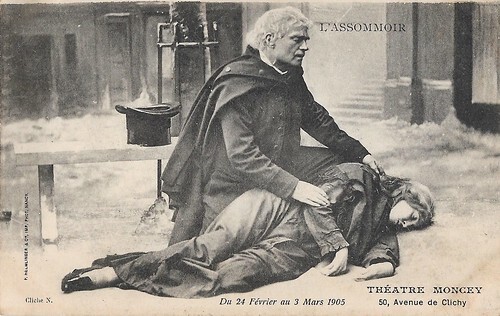
French postcard by P. Helmlinger & Co., Nancy. Cliché: N. (Nadar). Promotion for the Théâtre Moncey's production of Emile Zola's novel 'L'Assommoir' (24 February - 3 March 1905). Çaption: The death of Gervaise (Hélène Petit). This postcard shows a photo from the 1879 first stage adaptation, starring Hélène Petit as Gervaise, Gil Naza as Coupeau, and Angelo as Goujot. The original photos were by Nadar.
In 1879, two years after its publication, Emile Zola's novel 'L'Assommoir' was adapted for the stage by William Busnach and Octave Gastineau, with the help of Zola. The premiere took place on 18 January 1879 and was a great success. Afterward, the play was often re-staged, in and outside of France. From 24 February 1905, the play was staged at the Parisian Théâtre Moncey, 50, Avenue de Clichy. The journal La Presse of 26 February 1905 lauded the play and the performances, in the first place by M. Pouctal as Coupeau, Gabrielle Fleury as Gervaise, and M. Lemarchand as Lantier. Also praised were Mlle Delorme, Mme Gaudy, and M. Berthon as Lorilleux. Of course, there were tears, but also many laughs over the drunkards Mes-Bottes, Bec-Salé, and Bibi-la-Grillade, played by Mori, Prika, and Martin. The first night took place before a packed crowd.
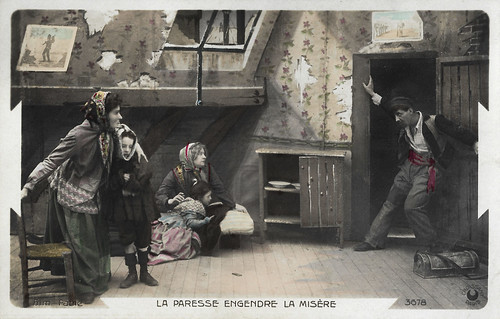
French postcard by Croissant, Paris, no. 3678. Photo: Film Pathé. Publicity still for Les victimes de l'alcoolisme/Alcohol and Its Victims (Ferdinand Zecca, 1902).
Les victimes de l'alcoolisme/Alcohol and Its Victims (Ferdinand, Zecca, 1902) is a four minutes short, directed, and written by Ferdinand Zecca. It was based on 'L'Assommoir', and the first Zola film adaptation ever. Les victimes de l'alcoolisme/Alcohol and Its Victims tells a moral story on what happens to a man if he starts to drink and gamble. Bob Lipton at IMDb : "this is a very advanced film for 1902, being offered in five scenes, on elaborately painted sets. It was probably not intended solely for movie programs, but for anti-booze lectures, Chautauquas, and conferences."
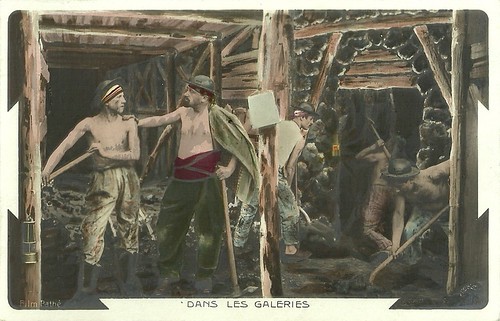
French postcard by Croissant, Paris. Photo: Film Pathé. Publicity still for Au pays noir/Tragedy in a Coal Mine (Ferdinand Zecca or Lucien Nonguet, 1905). Caption: In the mine galleries. This refers to the 5th scene of the film.
Au pays noir (1905) was partly inspired by Emile Zola's novel, the popular workman's drama 'Germinal' (1885). Au pays noir narrates about the life of the miner: his life at home, going to work, gathering at the pit and descending, having a break. But then an explosion takes place and water crushes the beams that uphold the galleries, killing the miners. A few manage to escape and withdraw to a higher gallery where the water can reach them only to their middle. They hear their liberators, who finally free them. Outside, gendarmes try to hold the crowd, who, frightened, see the rescuers bringing dead bodies one by one to the ground. When the foreman's dead son is brought to earth, his father explodes for grief and clenches his fist against the murderous mine. A year after the film, the worst mine disaster of Europe occurred in Courrières, France, when on 10 May 1906 a coal dust explosion killed almost 1100 mine workers. Zola's 'Germinal' was already filmed by Ferdinand Zecca in 1903. In 1912 Victorin Jasset filmed for the Eclair company another liberal adaptation, Au pays des ténèbres, while Albert Capellani filmed Germinal under its own title in 1913.
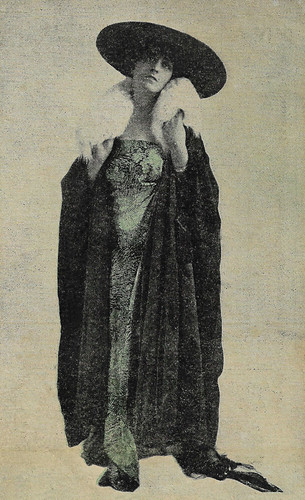
Spanish collectors card by Chocolat Imperial, no. 1 (in a series of 18 chromos). Photo: Caesar Film / J. Gurgui, Barcelona. Tilde Kassay in Una donna funesta/Nanà (Camillo De Riso, 1917-1919). Tilde Kassay (1887-1964), was an Italian silent film actress between 1915 and 1921.
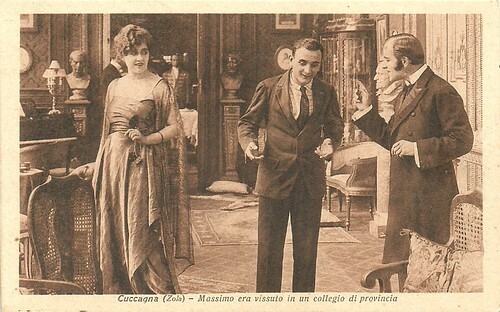
Italian postcard by IPA CT. V. Uff. Rev. St., Terni., no. 5076. Photo: Tiber Film. Hesperia in La Cuccagna (Baldassarre Negroni 1917). Caption: "Massimo had been raised in a provincial college." The film was an adaptation of Emile Zola's 'La curée'. Hesperia is Renata/Renée, second wife of the cunning and wealthy Saccard, who married young Renata for her money. She has an affair with Saccard's son Max (Massimo), played by Alberto Collo . In the end money triumphs instead of love, just as in Zola's novel.
In search of truth
Emile Zola paints the society of the Second Empire in all its diversity, highlighting its harshness towards the workers ('Germinal', 1885), its turpitude ('Nana', 1880), but also its successes (the advent of department stores in 'Au Bonheur des Dames', 1883).
In a search for truth that takes scientific methods as a model, Émile Zola accumulates direct observations and documentation on each subject. With his acute sense of detail "that rings true" and of effective metaphor, with the rhythm of his sentences and his narrative constructions, he creates a powerful fictional world, inhabited by anguished questions about the human and social body.
Émile Zola's work has been widely adapted to film, with more than 150 films and TV movies based on his works, in various languages. The first adaptations were of 'L'Assommoir', by Ferdinand Zecca, under the titles Le Rêve d'un buveur (1898) and Les Victimes de l'alcoolisme (1902).
In addition to L'Assommoir, more than half of the titles in the Rougon-Macquart series have been adapted for the screen. Some, such as 'Nana' and 'Germinal', have been adapted several times, with varying degrees of faithfulness to the original works.
Apart from the Rougon-Macquart cycle, the only work by Zola that has been widely adapted for the screen is 'Thérèse Raquin', but several of his short stories have also been adapted.
In 1937, the French novelist inspired the Hollywood production The Life of Emile Zola, directed by William Dieterle and starring Paul Muni , which won the 1938 Academy Award for Best Picture.
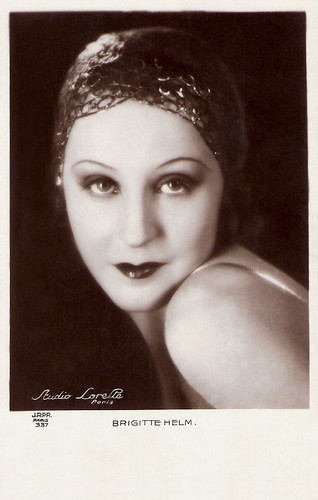
French postcard by J.R.P.R., Paris, no. 337. Photo: Studio Lorelle (Lucien Lorelle), Paris. Brigitte Helm in L'Argent/The Money (Marcel L'Herbier, 1928).
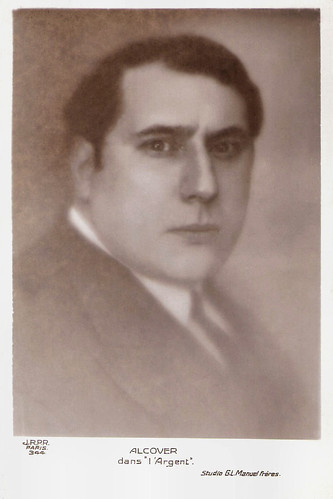
French postcard by J.R.P.R., Paris, no. 344. Photo: Studio G.L. Manuel Frères. Pierre Alcover in L'Argent/The Money (Marcel L'Herbier, 1928).
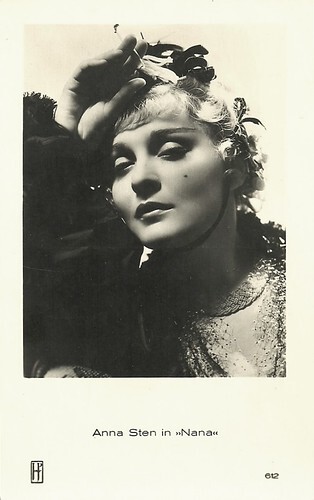
Dutch postcard by JosPe, Arnhem, no. 612. Anna Sten in Nana (Dorothy Arzner, George Fitzmaurice, 1934). Strikingly beautiful Anna Sten (1908-1993) was a Ukrainian-born actress, who became the most famous, or rather, the most notorious of the many ‘new Greta Garbos’ of the 1930s.
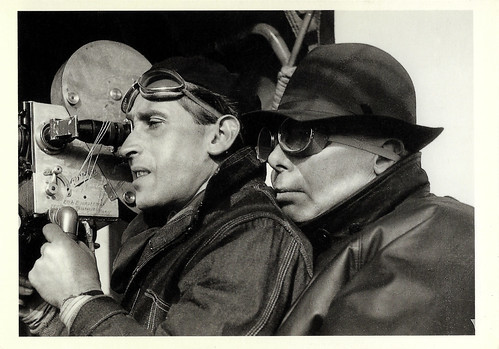
French postcard in the Collection Noire by Editions Hazan, Paris, no. 6011, 1988. Photo: Sam Levin. Director Jean Renoir at the set of La bête humaine/The Human Beast (1938).
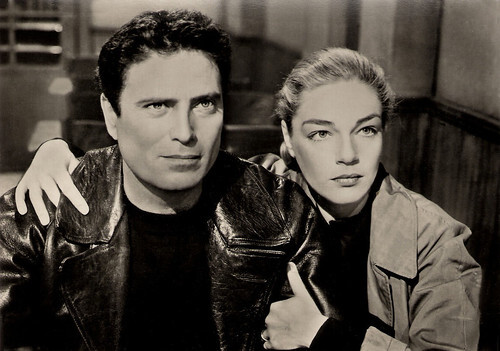
East-German postcard by VEB Progress Film-Vertrieb, Berlin, no. 1925. Retail price: 0,20 DM. Photo: Raf Vallone and Simone Signoret in Thérèse Raquin/The Adultress (Marcel Carné, 1953), after the novel by Emile Zola.
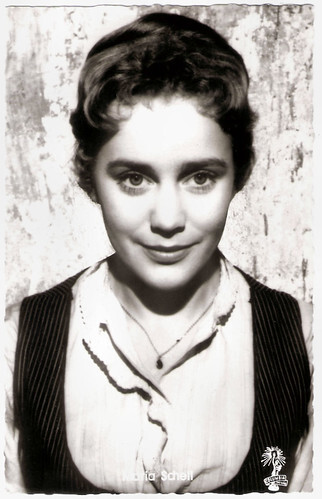
German postcard by Kolibri-Verlag, Minden/Westf., no. 2230. Photo: Columbia. Maria Schell in Gervaise (René Clément, 1956).
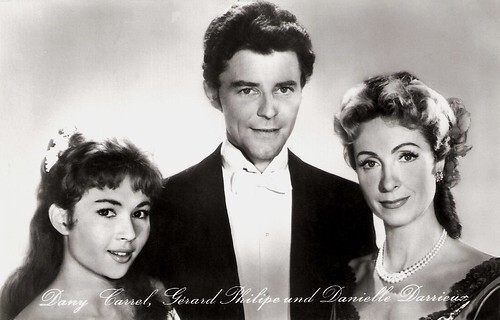
East-German postcard by VEB Progress Filmvertrieb, no. 1294, 1960. Photo: Dany Carrel , Gérard Philipe and Danièle Darrieux in Pot-Bouille/Lovers of Paris (Julien Duvivier, 1957), adapted from the novel by Zola.
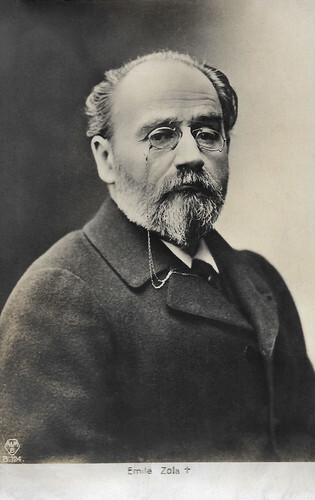
French postcard by A & M, B., no. B 124. Emile Zola.
Sources: Gallica (French), Bob Lipton (IMDb), Wikipedia (French and Dutch), and .

French postcard by Europe, no. 563. Photo: Cinéromans Films de France. Brigitte Helm in L'argent (Marcel L'Herbier, 1928), freely adapted from the novel by Emile Zola.

French postcard by Editions Cinémagazine, no. 411. Catherine Hessling as the title character in Nana (Jean Renoir, 1926), based on the homonymous novel (1880) by Emile Zola.

British postcard in the Famous Film Stars Series by Valentine's, no. 7123B. Photo: United Artists. Anna Sten in Nana (Dorothy Arzner, George Fitzmaurice, 1934).

East-German postcard by VEB Progress Film-Vertrieb, nr. 1924. Photo: Simone Signoret in Therese Raquin Thérèse Raquin/The Adultress (Marcel Carné, 1953).

East-German postcard by VEB Progress Filmvertrieb GmbH., Starfoto no. 1288. Gérard Philipe and at right Dany Carel in the Zola adaptation Pot Bouille/Lovers of Paris (Julien Duvivier, 1957), released in Germany as Der schöne Octave.
Writing his true vocation
Émile Édouard Charles Antoine Zola was born in 1840 in Paris. He spent his childhood and school years in Aix-en-Provence, where his father Francesco Zola, of Italian origin, was an engineer. He was implementing a plan for a drinking water supply when he died unexpectedly. Poor years followed for Zola and his mother, Émilie Aubert. In 1858 they went to Paris.
From his earliest youth, Émile Zola was fascinated by literature. He read a great deal and very early on envisaged the idea of writing professionally. From an early age, he considered writing to be his true vocation. In the sixth grade, he already wrote a novel about the Crusades. He told his childhood friends several times in his letters that one day he would be a recognised writer.
Zola failed his baccalauréat (bachelopr of sciences) twice in 1859. These failures left a deep impression on the young man, who despaired of having disappointed his mother. He was also aware that, without a diploma, he would face serious material difficulties. In Paris, he became friends with Édouard Manet and other painters of the Impressionist movement. Manet depicted him several times in his paintings, and through Manet, he came into contact with the poet Stéphane Mallarmé.
In 1862, Zola found a job in the publicity department of the publishing house Hachette. There he met writers and became familiar with the practical side of being a writer. He learned all the techniques of books and their marketing. He also published as a journalist in various magazines. As a critic, he was particularly harsh on the official Salon jury when 'The Flute Player' by Manet was rejected. He would also become a fervent defender of impressionism.
Zola managed to get his first book published by Hetzel: 'Les Contes à Ninon' (1864). He became famous with novels such as 'Germinal', 'Nana' and the enormous success, 'L'Assommoir' (1877), which are part of the great cycle 'Les Rougon-Macquart'. 'Les Rougon-Macquart'is a twenty-volume novelistic fresco depicting French society under the Second Empire, which follows the trajectory of the Rougon-Macquart family through its different generations, each of whose representatives, from a particular period and generation, is the subject of a novel.
In 'l'Oeuvre' (1886), he depicts the tragic life of a painter, a character largely inspired by Paul Cézanne, a childhood friend of Zola's from Aix-en-Provence. Cézanne had introduced him to the graphic arts, and more particularly to painting. After receiving this novel, Cézanne abruptly ended their friendship, which had not been very intense for some time.
Zola's open letter to President Félix Faure in L'Aurore of 13 January 1898 under the title 'J'accuse...!' was also famous. In this letter about the Dreyfus affair, he sides with the Jewish captain Alfred Dreyfus, who was unjustly accused of espionage. Zola accused the French General Staff of producing evidence. Zola was sentenced for libel to one year in prison and a 3000 Francs fine, which was paid for him by Octave Mirbeau. On the advice of friends, Zola did not wait for the appeal and fled to Britain. After a year he was able to return and was received as a hero.
Zola married Alexandrine 'Gabrielle' Meley in 1870, a working-class woman who had been a model for Impressionist painters such as Manet. She introduced him to the people on the fringes of society in Paris. She also organised weekly literary dinners for Zola to further his career. Zola also had a mistress, Jeanne Rozerot, who was the family laundress. While his marriage remained childless, he and Jeanne had two children.
Émile Zola died unexpectedly in Paris in 1902 at his home on the Rue de Bruxelles due to carbon monoxide poisoning. According to Philipp Blom, a roofer confessed to placing a piece of wood on the chimney to kill the writer in revenge for his defense of the Jewish captain. In 1908, his body was transferred to the Panthéon.

French card. Photo: Gerschel. Emile Zola.

Vintage French postcard. Scene from the play 'Nanà' by William Busnach, a play in five acts adapted from the novel by Emile Zola. Théâtre de l'Ambigu, Paris. Tableau 1, The Blonde Venus. The play was first performed at the Théâtre de l'Ambigu on 6 February 1904. Nanâ was played by Armande Cassive.

Vintage French postcard. Scene from the play 'Nanà' by William Busnach, a play in five acts adapted from the novel by Emile Zola. Théâtre de l'Ambigu. Tableau 2, The Ruins of Chamont. The play was first performed at the Théâtre de l'Ambigu on 6 February 1904. Nanâ was played by Armande Cassive. It was one of her most memorable roles.

French postcard by P. Helmlinger & Co., Nancy. Cliché: N. (Nadar). Promotion for the Théâtre Moncey's production of Emile Zola's novel 'L'Assommoir' (24 February - 3 March 1905). Çaption: The death of Gervaise (Hélène Petit). This postcard shows a photo from the 1879 first stage adaptation, starring Hélène Petit as Gervaise, Gil Naza as Coupeau, and Angelo as Goujot. The original photos were by Nadar.
In 1879, two years after its publication, Emile Zola's novel 'L'Assommoir' was adapted for the stage by William Busnach and Octave Gastineau, with the help of Zola. The premiere took place on 18 January 1879 and was a great success. Afterward, the play was often re-staged, in and outside of France. From 24 February 1905, the play was staged at the Parisian Théâtre Moncey, 50, Avenue de Clichy. The journal La Presse of 26 February 1905 lauded the play and the performances, in the first place by M. Pouctal as Coupeau, Gabrielle Fleury as Gervaise, and M. Lemarchand as Lantier. Also praised were Mlle Delorme, Mme Gaudy, and M. Berthon as Lorilleux. Of course, there were tears, but also many laughs over the drunkards Mes-Bottes, Bec-Salé, and Bibi-la-Grillade, played by Mori, Prika, and Martin. The first night took place before a packed crowd.

French postcard by Croissant, Paris, no. 3678. Photo: Film Pathé. Publicity still for Les victimes de l'alcoolisme/Alcohol and Its Victims (Ferdinand Zecca, 1902).
Les victimes de l'alcoolisme/Alcohol and Its Victims (Ferdinand, Zecca, 1902) is a four minutes short, directed, and written by Ferdinand Zecca. It was based on 'L'Assommoir', and the first Zola film adaptation ever. Les victimes de l'alcoolisme/Alcohol and Its Victims tells a moral story on what happens to a man if he starts to drink and gamble. Bob Lipton at IMDb : "this is a very advanced film for 1902, being offered in five scenes, on elaborately painted sets. It was probably not intended solely for movie programs, but for anti-booze lectures, Chautauquas, and conferences."

French postcard by Croissant, Paris. Photo: Film Pathé. Publicity still for Au pays noir/Tragedy in a Coal Mine (Ferdinand Zecca or Lucien Nonguet, 1905). Caption: In the mine galleries. This refers to the 5th scene of the film.
Au pays noir (1905) was partly inspired by Emile Zola's novel, the popular workman's drama 'Germinal' (1885). Au pays noir narrates about the life of the miner: his life at home, going to work, gathering at the pit and descending, having a break. But then an explosion takes place and water crushes the beams that uphold the galleries, killing the miners. A few manage to escape and withdraw to a higher gallery where the water can reach them only to their middle. They hear their liberators, who finally free them. Outside, gendarmes try to hold the crowd, who, frightened, see the rescuers bringing dead bodies one by one to the ground. When the foreman's dead son is brought to earth, his father explodes for grief and clenches his fist against the murderous mine. A year after the film, the worst mine disaster of Europe occurred in Courrières, France, when on 10 May 1906 a coal dust explosion killed almost 1100 mine workers. Zola's 'Germinal' was already filmed by Ferdinand Zecca in 1903. In 1912 Victorin Jasset filmed for the Eclair company another liberal adaptation, Au pays des ténèbres, while Albert Capellani filmed Germinal under its own title in 1913.

Spanish collectors card by Chocolat Imperial, no. 1 (in a series of 18 chromos). Photo: Caesar Film / J. Gurgui, Barcelona. Tilde Kassay in Una donna funesta/Nanà (Camillo De Riso, 1917-1919). Tilde Kassay (1887-1964), was an Italian silent film actress between 1915 and 1921.

Italian postcard by IPA CT. V. Uff. Rev. St., Terni., no. 5076. Photo: Tiber Film. Hesperia in La Cuccagna (Baldassarre Negroni 1917). Caption: "Massimo had been raised in a provincial college." The film was an adaptation of Emile Zola's 'La curée'. Hesperia is Renata/Renée, second wife of the cunning and wealthy Saccard, who married young Renata for her money. She has an affair with Saccard's son Max (Massimo), played by Alberto Collo . In the end money triumphs instead of love, just as in Zola's novel.
In search of truth
Emile Zola paints the society of the Second Empire in all its diversity, highlighting its harshness towards the workers ('Germinal', 1885), its turpitude ('Nana', 1880), but also its successes (the advent of department stores in 'Au Bonheur des Dames', 1883).
In a search for truth that takes scientific methods as a model, Émile Zola accumulates direct observations and documentation on each subject. With his acute sense of detail "that rings true" and of effective metaphor, with the rhythm of his sentences and his narrative constructions, he creates a powerful fictional world, inhabited by anguished questions about the human and social body.
Émile Zola's work has been widely adapted to film, with more than 150 films and TV movies based on his works, in various languages. The first adaptations were of 'L'Assommoir', by Ferdinand Zecca, under the titles Le Rêve d'un buveur (1898) and Les Victimes de l'alcoolisme (1902).
In addition to L'Assommoir, more than half of the titles in the Rougon-Macquart series have been adapted for the screen. Some, such as 'Nana' and 'Germinal', have been adapted several times, with varying degrees of faithfulness to the original works.
Apart from the Rougon-Macquart cycle, the only work by Zola that has been widely adapted for the screen is 'Thérèse Raquin', but several of his short stories have also been adapted.
In 1937, the French novelist inspired the Hollywood production The Life of Emile Zola, directed by William Dieterle and starring Paul Muni , which won the 1938 Academy Award for Best Picture.

French postcard by J.R.P.R., Paris, no. 337. Photo: Studio Lorelle (Lucien Lorelle), Paris. Brigitte Helm in L'Argent/The Money (Marcel L'Herbier, 1928).

French postcard by J.R.P.R., Paris, no. 344. Photo: Studio G.L. Manuel Frères. Pierre Alcover in L'Argent/The Money (Marcel L'Herbier, 1928).

Dutch postcard by JosPe, Arnhem, no. 612. Anna Sten in Nana (Dorothy Arzner, George Fitzmaurice, 1934). Strikingly beautiful Anna Sten (1908-1993) was a Ukrainian-born actress, who became the most famous, or rather, the most notorious of the many ‘new Greta Garbos’ of the 1930s.

French postcard in the Collection Noire by Editions Hazan, Paris, no. 6011, 1988. Photo: Sam Levin. Director Jean Renoir at the set of La bête humaine/The Human Beast (1938).

East-German postcard by VEB Progress Film-Vertrieb, Berlin, no. 1925. Retail price: 0,20 DM. Photo: Raf Vallone and Simone Signoret in Thérèse Raquin/The Adultress (Marcel Carné, 1953), after the novel by Emile Zola.

German postcard by Kolibri-Verlag, Minden/Westf., no. 2230. Photo: Columbia. Maria Schell in Gervaise (René Clément, 1956).

East-German postcard by VEB Progress Filmvertrieb, no. 1294, 1960. Photo: Dany Carrel , Gérard Philipe and Danièle Darrieux in Pot-Bouille/Lovers of Paris (Julien Duvivier, 1957), adapted from the novel by Zola.

French postcard by A & M, B., no. B 124. Emile Zola.
Sources: Gallica (French), Bob Lipton (IMDb), Wikipedia (French and Dutch), and .
Published on May 22, 2022 22:00
May 21, 2022
More postcards by News Productions
Last year, EFSP had a popular post about News Productions in Baulmes which operated till 2004. We love the stylish black and white postcards by this Swiss publisher with classic film scenes, set photos, and mesmerising star portraits. The pictures by such photographers as Sam Shaw and Larry Shaw often came from the Cinémathèque Suisse in Lausanne which must have a rich and wonderful photo collection. Recently, Paul van Yperen found dozens of other News Productions postcards at Delcampe. He made a new selection of his 20 favourite unpublished cards for this post.
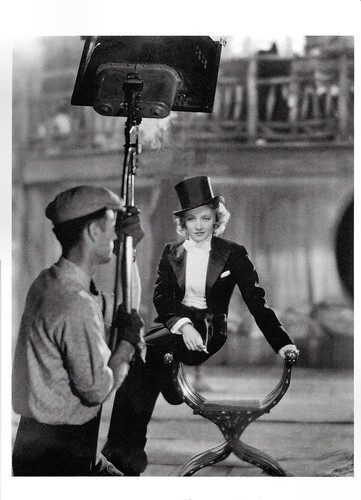
Swiss-German-British postcard by News Productions, Baulmes / Filmwelt Berlin, Bakede / News Productions, Stroud, no. 56481. Photo: Marlene Dietrich , Paramount, 1932 / Collection Cinémathèque Suisse, Lausanne.
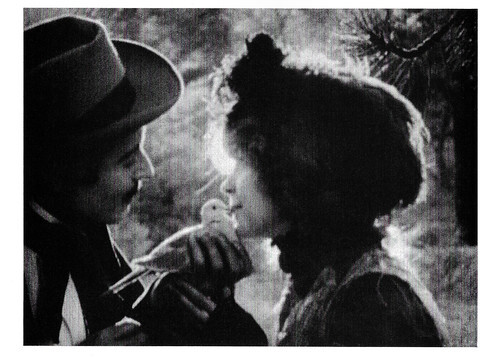
Swiss-German-British postcard by News Productions, Baulmes / Filmwelt Berlin, Bakede / News Productions, Stroud, no. 56487. Photo: Collection Cinémathèque Suisse, Lausanne. Lillian Gish and Henry B. Walthall in Birth of a Nation (David Wark Griffith, 1915), produced by D.W. Griffith Corporation.
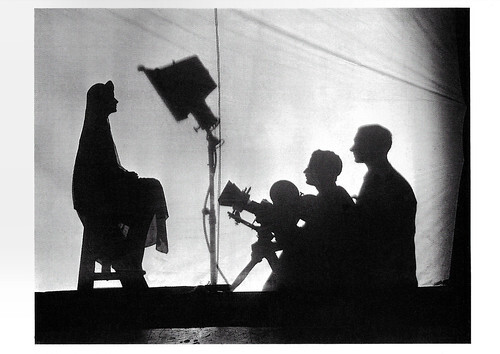
Swiss-German-British postcard by News Productions, Baulmes / Filmwelt Berlin, Bakede / News Productions, Stroud, no. 56492. Photo: Collection Cinémathèque Suisse, Lausanne. Greta Garbo in The Kiss (Jacques Feyder, 1929). produced by MGM.
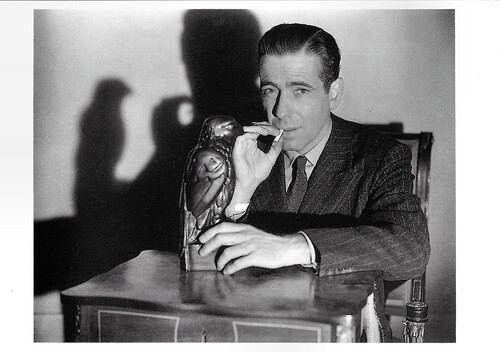
Swiss-German-British postcard by News Productions, Baulmes / Filmwelt Berlin, Bakede / News Productions, Stroud, no. 56495. Photo: Warner Bros / Collection Cinémathèque Suisse, Lausanne. Humphrey Bogart in The Maltese Falcon (John Huston, 1941).
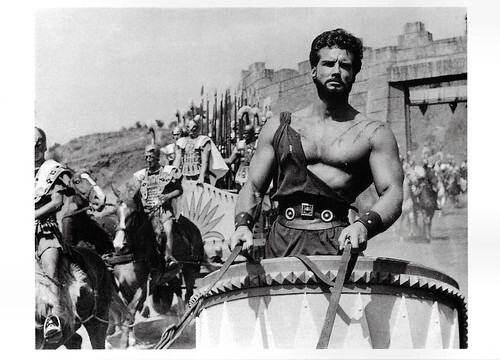
Swiss-German-British postcard by News Productions, Baulmes / Filmwelt Berlin, Bakede / News Productions, Stroud, no. 56496 Photo: Collection Cinémathèque Suisse, Lausanne. Steve Reeves in Ercole e la Regina di Lidia/Hercules Unchained (Pietro Francisci, 1958), produced by Lux-Galatea / Lux France.
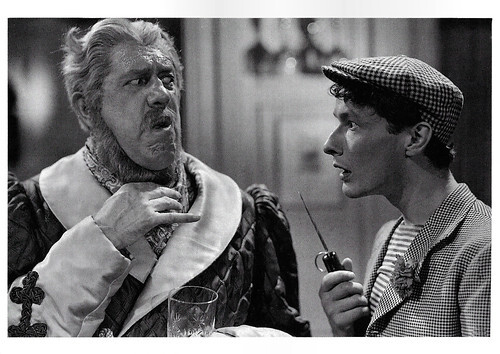
Swiss-German-British postcard by News Productions, Baulmes / Filmwelt Berlin, Bakede / News Productions, Stroud, no. 56510. Photo: Collection Cinémathèque Suisse, Lausanne. Michel Simon and Jean-Louis Barrault in Drôle de Drame/Bizarre, Bizarre (Marcel Carné, 1937), produced by Comiglion-Molinier.
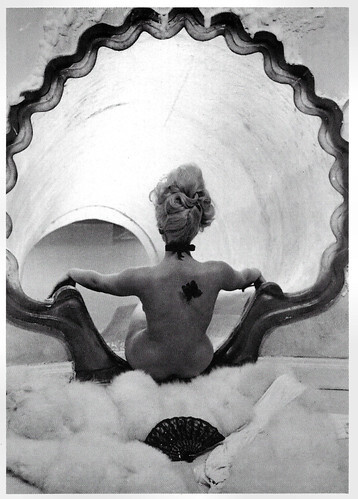
Swiss-German-British postcard by News Productions, Baulmes / Filmwelt Berlin, Bakede / News Productions, Stroud, no. 56522. Photo: Collection Cinémathèque Suisse, Lausanne. Sandra Milo in Giulietta Degli Spiriti/Juliet of the Spirits (Federico Fellini, 1965) produced by Rizzoli.
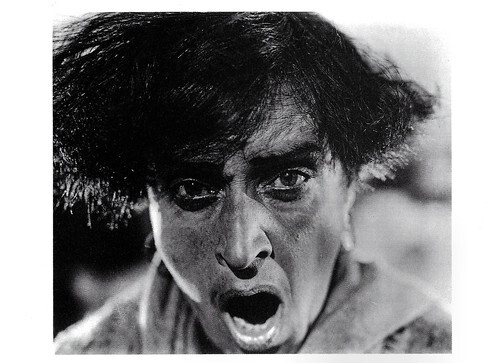
Swiss-German-British postcard by News Productions, Baulmes / Filmwelt Berlin, Bakede / News Productions, Stroud, no. 56531. Photo: Collection Cinémathèque Suisse, Lausanne. Scene from Bronenosets Potyomkin/Battleship Potemkin (Sergei Eisenstein, 1925), produced by Goskino. The actress playing the mother whose child is killed by the tsarist army and discovers this in shock, was Prokhorenko.
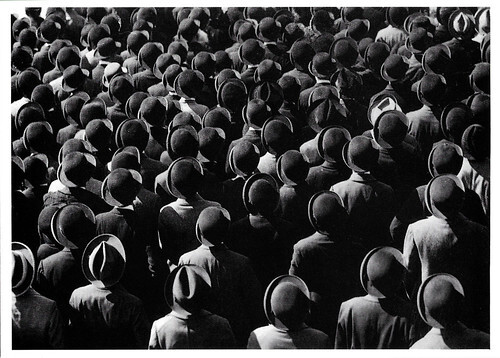
Swiss-German-British postcard by News Productions, Baulmes / Filmwelt Berlin, Bakede / News Productions, Stroud, no. 56533. Photo: Collection Cinémathèque Suisse, Lausanne. Scene from Konets Sankt-Peterburga/The End of St. Petersburg (Vsevolod Pudovkin, Mikhail Doller, 1927) by Mejrabpom.
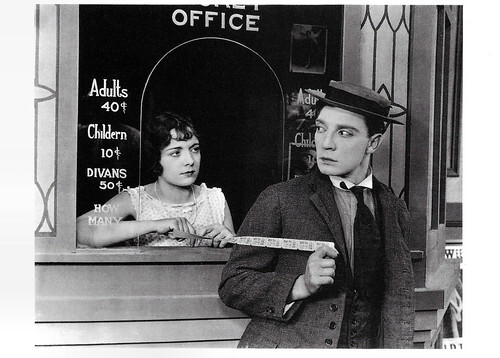
Swiss-German-British postcard by News Productions, Baulmes / Filmwelt Berlin, Bakede / News Productions, Stroud, no. 56545. Photo: MGM / Collection Cinémathèque Suisse, Lausanne. Buster Keaton and Kathryn McGuire in Sherlock Junior (Buster Keaton, 1924).
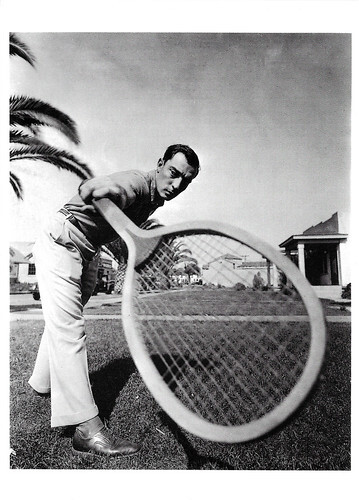
Swiss-German-British postcard by News Productions, Baulmes / Filmwelt Berlin, Bakede / News Productions, Stroud, no. 56550. Photo: MGM / Collection Cinémathèque Suisse, Lausanne. Buster Keaton .
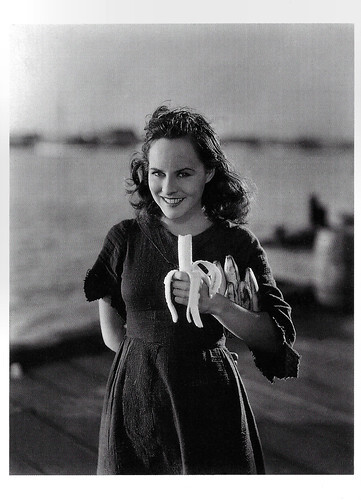
Swiss-German-British postcard by News Productions, Baulmes / Filmwelt Berlin, Bakede / News Productions, Stroud, no. 56551. Paulette Goddard in Modern Times (Charles Chaplin, 1936), produced by United Artists.
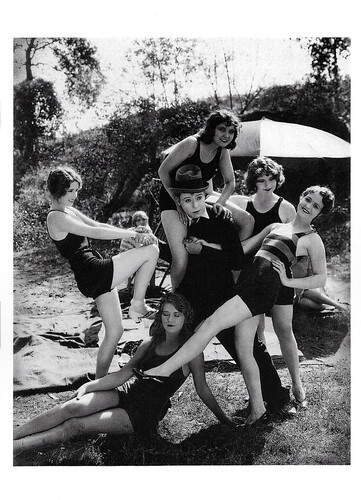
Swiss-German-British postcard by News Productions, Baulmes / Filmwelt Berlin, Bakede / News Productions, Stroud, no. 56553 Photo: First National Pictures Inc. / Collection Cinémathèque Suisse, Lausanne. Harry Langdon in The Chaser (Harry Langdon, 1928).
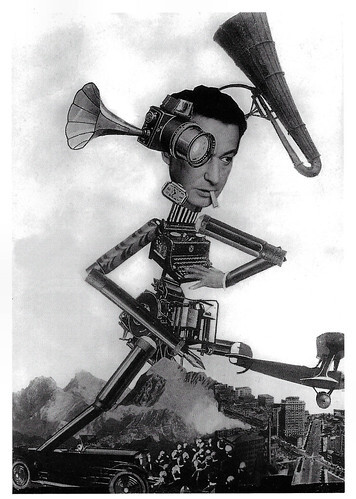
Swiss-German-British postcard by News Productions, Baulmes / Filmwelt Berlin, Bakede / News Productions, Stroud, no. 56556. Photo: Collection Cinémathèque Suisse, Lausanne. Scene from Berlin, Sinfonie der Grossstadt (Walther Ruttmann, 1927), produced by Deutsche Vereins-Film AG, Berlin.
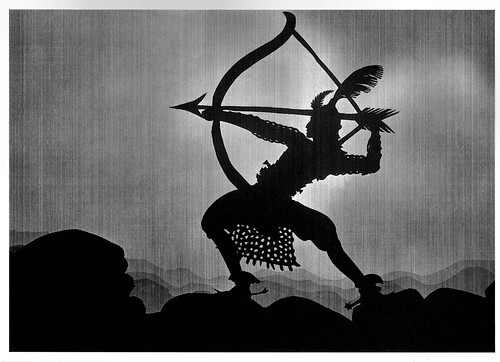
Swiss-German-British postcard by News Productions, Baulmes / Filmwelt Berlin, Bakede / News Productions, Stroud, no. 56557. Photo: Collection Cinémathèque Suisse, Lausanne. Scene from Die Abenteuer des Prinzen Achmed/The Adventures of Prince Achmed (Lotte Reininger, 1926), produced by Comenius Film, Berlin-Potsdam.
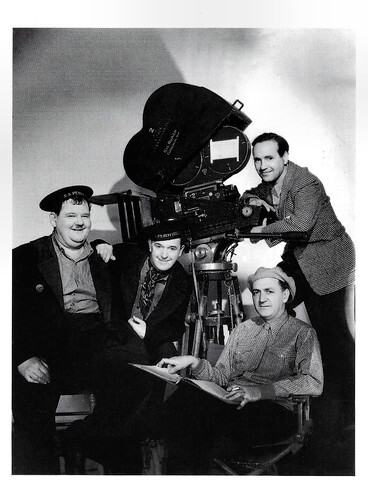
Swiss-German-British postcard by News Productions, Baulmes / Filmwelt Berlin, Bakede / News Productions, Stroud, no. 56559. Oliver Hardy , Stan Laurel , director Harry Lachman and cinematographer Rudolph Mate on the set of Our Relations (Harry Lachman, 1936), produced by MGM.
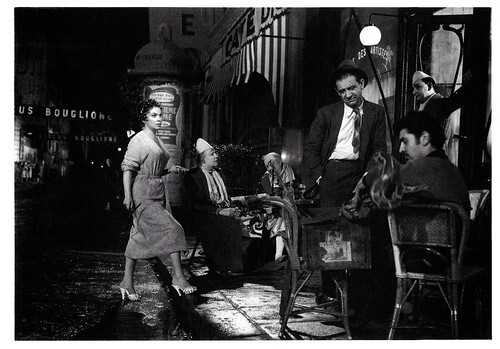
Swiss-German-British postcard by News Productions, Baulmes / Filmwelt Berlin, Bakede / News Productions, Stroud, no. 56572. Photo: Sam Shaw. Gina Lollobrigida on the set of Trapeze (Carol Reed, 1956), Studio de Boulogne, Paris, 1958.
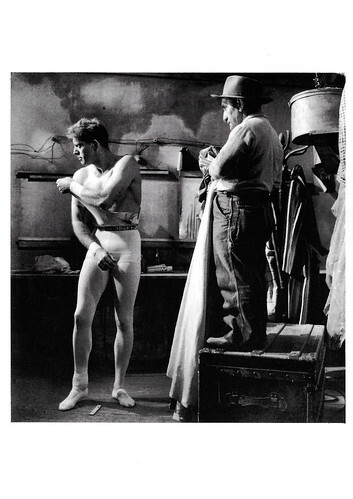
Swiss-German-British postcard by News Productions, Baulmes / Filmwelt Berlin, Bakede / News Productions, Stroud, no. 56577. Photo: Sam Shaw. Burt Lancaster on the Paris set of Trapeze (Carol Reed, 1956).
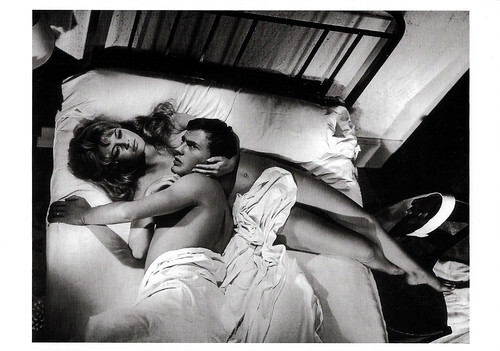
Swiss postcard by News Productions, Baulmes / CVB Publishers, Grandson, no. 56783. Photo: Collection Cinémathèque Suisse, Lausanne. Jean-Louis Trintignant and Brigitte Bardot in Et Dieu... créa la femme/And God Created Woman (Roger Vadim, 1956).
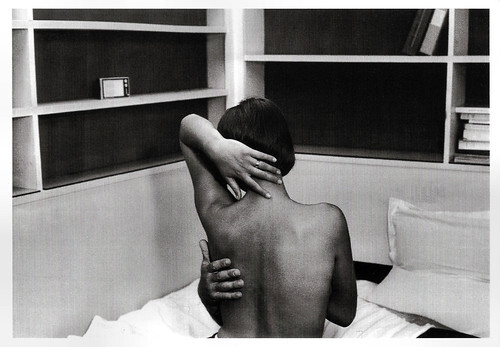
Swiss postcard by News Productions, Baulmes / CVB Publishers, Grandson, no. CP 46, 1996. Photo: Collection Cinémathèque Suisse, Lausanne. Macha Méril in Une femme mariée/A Married Woman (Jean-Luc Godard, 1964).

Swiss-German-British postcard by News Productions, Baulmes / Filmwelt Berlin, Bakede / News Productions, Stroud, no. 56481. Photo: Marlene Dietrich , Paramount, 1932 / Collection Cinémathèque Suisse, Lausanne.

Swiss-German-British postcard by News Productions, Baulmes / Filmwelt Berlin, Bakede / News Productions, Stroud, no. 56487. Photo: Collection Cinémathèque Suisse, Lausanne. Lillian Gish and Henry B. Walthall in Birth of a Nation (David Wark Griffith, 1915), produced by D.W. Griffith Corporation.

Swiss-German-British postcard by News Productions, Baulmes / Filmwelt Berlin, Bakede / News Productions, Stroud, no. 56492. Photo: Collection Cinémathèque Suisse, Lausanne. Greta Garbo in The Kiss (Jacques Feyder, 1929). produced by MGM.

Swiss-German-British postcard by News Productions, Baulmes / Filmwelt Berlin, Bakede / News Productions, Stroud, no. 56495. Photo: Warner Bros / Collection Cinémathèque Suisse, Lausanne. Humphrey Bogart in The Maltese Falcon (John Huston, 1941).

Swiss-German-British postcard by News Productions, Baulmes / Filmwelt Berlin, Bakede / News Productions, Stroud, no. 56496 Photo: Collection Cinémathèque Suisse, Lausanne. Steve Reeves in Ercole e la Regina di Lidia/Hercules Unchained (Pietro Francisci, 1958), produced by Lux-Galatea / Lux France.

Swiss-German-British postcard by News Productions, Baulmes / Filmwelt Berlin, Bakede / News Productions, Stroud, no. 56510. Photo: Collection Cinémathèque Suisse, Lausanne. Michel Simon and Jean-Louis Barrault in Drôle de Drame/Bizarre, Bizarre (Marcel Carné, 1937), produced by Comiglion-Molinier.

Swiss-German-British postcard by News Productions, Baulmes / Filmwelt Berlin, Bakede / News Productions, Stroud, no. 56522. Photo: Collection Cinémathèque Suisse, Lausanne. Sandra Milo in Giulietta Degli Spiriti/Juliet of the Spirits (Federico Fellini, 1965) produced by Rizzoli.

Swiss-German-British postcard by News Productions, Baulmes / Filmwelt Berlin, Bakede / News Productions, Stroud, no. 56531. Photo: Collection Cinémathèque Suisse, Lausanne. Scene from Bronenosets Potyomkin/Battleship Potemkin (Sergei Eisenstein, 1925), produced by Goskino. The actress playing the mother whose child is killed by the tsarist army and discovers this in shock, was Prokhorenko.

Swiss-German-British postcard by News Productions, Baulmes / Filmwelt Berlin, Bakede / News Productions, Stroud, no. 56533. Photo: Collection Cinémathèque Suisse, Lausanne. Scene from Konets Sankt-Peterburga/The End of St. Petersburg (Vsevolod Pudovkin, Mikhail Doller, 1927) by Mejrabpom.

Swiss-German-British postcard by News Productions, Baulmes / Filmwelt Berlin, Bakede / News Productions, Stroud, no. 56545. Photo: MGM / Collection Cinémathèque Suisse, Lausanne. Buster Keaton and Kathryn McGuire in Sherlock Junior (Buster Keaton, 1924).

Swiss-German-British postcard by News Productions, Baulmes / Filmwelt Berlin, Bakede / News Productions, Stroud, no. 56550. Photo: MGM / Collection Cinémathèque Suisse, Lausanne. Buster Keaton .

Swiss-German-British postcard by News Productions, Baulmes / Filmwelt Berlin, Bakede / News Productions, Stroud, no. 56551. Paulette Goddard in Modern Times (Charles Chaplin, 1936), produced by United Artists.

Swiss-German-British postcard by News Productions, Baulmes / Filmwelt Berlin, Bakede / News Productions, Stroud, no. 56553 Photo: First National Pictures Inc. / Collection Cinémathèque Suisse, Lausanne. Harry Langdon in The Chaser (Harry Langdon, 1928).

Swiss-German-British postcard by News Productions, Baulmes / Filmwelt Berlin, Bakede / News Productions, Stroud, no. 56556. Photo: Collection Cinémathèque Suisse, Lausanne. Scene from Berlin, Sinfonie der Grossstadt (Walther Ruttmann, 1927), produced by Deutsche Vereins-Film AG, Berlin.

Swiss-German-British postcard by News Productions, Baulmes / Filmwelt Berlin, Bakede / News Productions, Stroud, no. 56557. Photo: Collection Cinémathèque Suisse, Lausanne. Scene from Die Abenteuer des Prinzen Achmed/The Adventures of Prince Achmed (Lotte Reininger, 1926), produced by Comenius Film, Berlin-Potsdam.

Swiss-German-British postcard by News Productions, Baulmes / Filmwelt Berlin, Bakede / News Productions, Stroud, no. 56559. Oliver Hardy , Stan Laurel , director Harry Lachman and cinematographer Rudolph Mate on the set of Our Relations (Harry Lachman, 1936), produced by MGM.

Swiss-German-British postcard by News Productions, Baulmes / Filmwelt Berlin, Bakede / News Productions, Stroud, no. 56572. Photo: Sam Shaw. Gina Lollobrigida on the set of Trapeze (Carol Reed, 1956), Studio de Boulogne, Paris, 1958.

Swiss-German-British postcard by News Productions, Baulmes / Filmwelt Berlin, Bakede / News Productions, Stroud, no. 56577. Photo: Sam Shaw. Burt Lancaster on the Paris set of Trapeze (Carol Reed, 1956).

Swiss postcard by News Productions, Baulmes / CVB Publishers, Grandson, no. 56783. Photo: Collection Cinémathèque Suisse, Lausanne. Jean-Louis Trintignant and Brigitte Bardot in Et Dieu... créa la femme/And God Created Woman (Roger Vadim, 1956).

Swiss postcard by News Productions, Baulmes / CVB Publishers, Grandson, no. CP 46, 1996. Photo: Collection Cinémathèque Suisse, Lausanne. Macha Méril in Une femme mariée/A Married Woman (Jean-Luc Godard, 1964).
Published on May 21, 2022 22:00
May 20, 2022
Gene Kelly
Gene Kelly (1912-1996) was an American actor, dancer, singer, filmmaker, and choreographer. He was known for his energetic and athletic dancing style, his good looks, and the likable characters that he played on screen. He starred in, choreographed, or co-directed some of the most well-regarded musical films of the 1940s and 1950s until they fell out of fashion in the late 1950s. Kelly is best known today for his performances in films such as Anchors Aweigh (1945), On the Town (1949), which was his directorial debut, An American in Paris (1951), Singin' in the Rain (1952), Brigadoon (1954), and It's Always Fair Weather (1955).
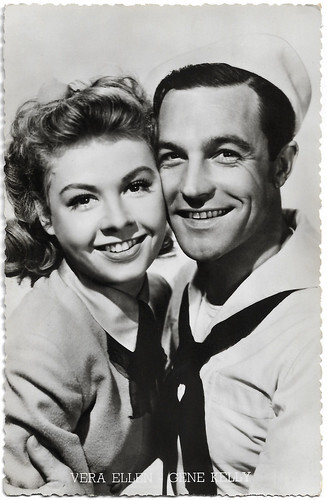
French postcard, no. 1. Photo: Metro-Goldwyn-Mayer. Vera Ellen and Gene Kelly in On the Town (Stanley Donen, Gene Kelly, 1949).
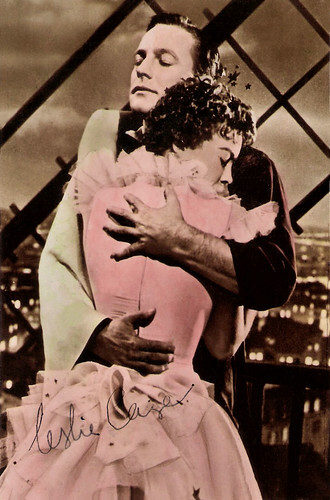
Vintage autograph card. Photo: Leslie Caron and Gene Kelly in An American in Paris (Vincente Minnelli, 1951).
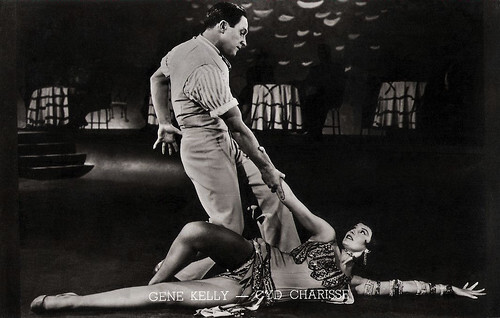
Dutch postcard. Photo: M.G.M. Gene Kelly and Cyd Charisse in Singin' in the Rain (Stanley Donen, Gene Kelly, 1952).
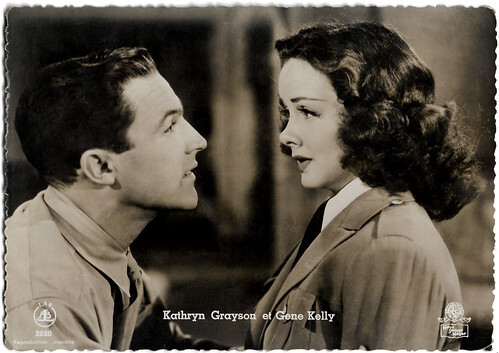
Belgian postcard by Les Editions d'Art L.A.B., Brussels, no. 2020. Photo: Metro-Goldwyn-Mayer. Kathryn Grayson and Gene Kelly in Thousands Cheer (George Sidney, 1943).
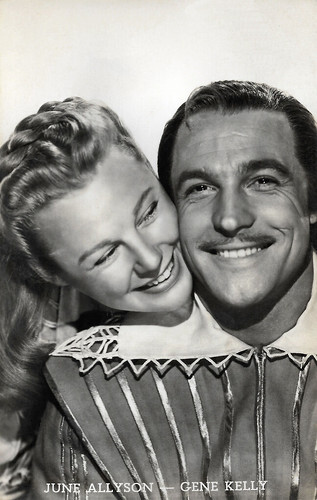
Dutch postcard by van Leer's Fotodrukindustrie N.V., Amsterdam, no. 351, no. 6. Photo: Metro Goldwyn Mayer (M.G.M.) June Allyson and Gene Kelly in The Three Musketeers (George Sidney, 1948), based on the novel by Alexandre Dumas.
An accomplished sportsman and able to defend himself
Eugene Curran Kelly was born in 1912 in the East Liberty neighborhood of Pittsburgh. He was the third son of James Patrick Joseph Kelly, a phonograph salesman, and his wife, Harriet Catherine Curran.
By the time he decided to dance, he was an accomplished sportsman and able to defend himself. He attended St. Raphael Elementary School in the Morningside neighbourhood of Pittsburgh and graduated from Peabody High School at age 16. He entered Pennsylvania State College as a journalism major, but after the 1929 crash, he left school and found work in order to help his family financially.
He created dance routines with his younger brother Fred to earn prize money in local talent contests. They also performed in local nightclubs. In 1931, Kelly enrolled at the University of Pittsburgh to study economics. His family opened a dance studio in the Squirrel Hill neighborhood of Pittsburgh.
In 1932, they renamed it the Gene Kelly Studio of the Dance and opened a second location in Johnstown, Pennsylvania, in 1933. Kelly served as a teacher at the studio during his undergraduate and law-student years at Pitt. Kelly eventually decided to pursue a career as a dance teacher and full-time entertainer, so he dropped out of law school after two months.
In 1937, having successfully managed and developed the family's dance school business, he finally did move to New York City in search of work as a choreographer. His first Broadway assignment, in 1938, was as a dancer in Cole Porter's 'Leave It to Me!'
Kelly's first big breakthrough was in the Pulitzer Prize-winning 'The Time of Your Life' (1939), in which, for the first time on Broadway, he danced to his own choreography. In 1940, he got the lead role in Rodgers and Hart's 'Pal Joey', choreographed by Robert Alton. This role propelled him to stardom. Offers from Hollywood began to arrive.
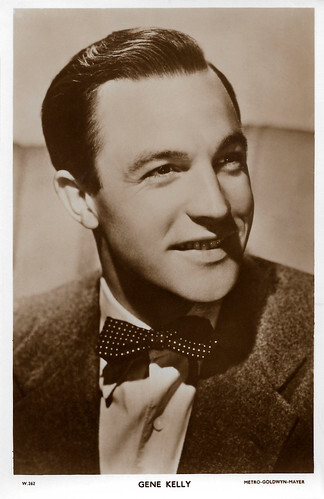
British postcard in the Picturegoer Series, London, no. W 262. Photo: Metro-Goldwyn-Mayer (M.G.M.).
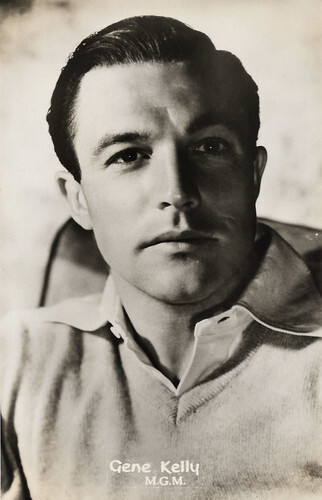
Vintage card. Photo: Metro-Goldwyn-Mayer (M.G.M.).
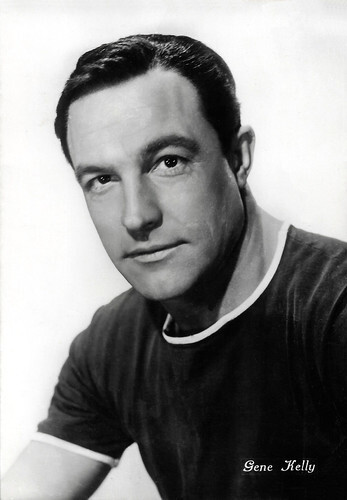
Italian postcard in the Divi del Cinema series by Vetta Traldi, Milano, no. 102.
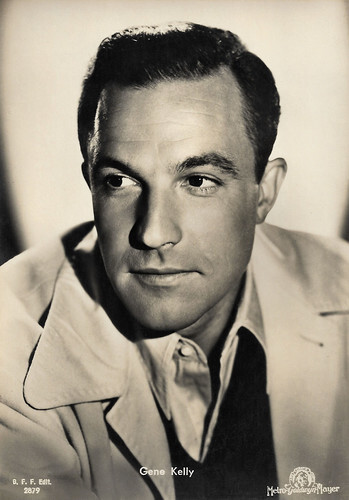
Italian postcard by B.F.F. Edit. (Casa Editr. Ballerini & Fratini, Firenze), no. 2879. Photo: Metro-Goldwyn-Mayer (M.G.M.).
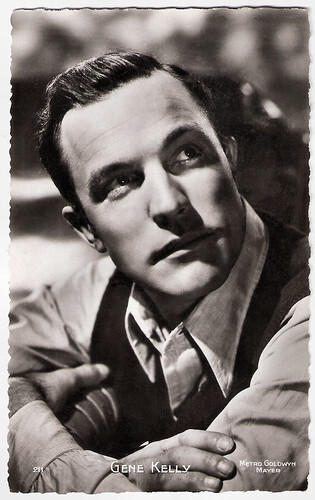
French postcard by Edition P.I., Paris, no. 211, offered by Victoria, Brussels, no. 639. Photo: Metro-Goldwyn-Mayer, 1950.
The most inventive and effervescent musical
Metro-Goldwyn-Mayer was the largest and most powerful studio in Hollywood when Gene Kelly arrived in town in 1941. There he made his film debut with Judy Garland in For Me and My Gal (Busby Berkeley, 1942). The film was a production of the Arthur Freed unit at MGM and it was one of the big hits of the year.
The talent pool at MGM was especially large during World War II when Hollywood was a refuge for many musicians and others in the performing arts of Europe who were forced to flee the Nazis. Kelly's film debut was followed by Cole Porter's Du Barry Was a Lady (Roy Del Ruth, 1943) with Lucille Ball, the morale booster Thousands Cheer (George Sidney, 1943), Cover Girl (Charles Vidor, 1944) opposite Rita Hayworth , and Anchors Aweigh (George Sidney, 1945) with Frank Sinatra .
MGM gave him a free hand to devise a range of dance routines for the latter, including his duets with Sinatra and the celebrated animated dance with Jerry Mouse — the animation for which was supervised by William Hanna and Joseph Barbera. Anchors Aweigh became one of the most successful films of 1945 and Kelly was nominated for the Academy Award for Best Actor.
In Ziegfeld Follies (1946), Kelly collaborated with Fred Astaire, for whom he had the greatest admiration, in 'The Babbitt and the Bromide' challenge dance routine. He co-starred with Judy Garland in The Pirate (Vincente Minnelli, 1948) which gave full rein to Kelly's athleticism. It features Kelly's work with the Nicholas Brothers — the leading black dancers of their day — in a virtuoso dance routine. Now regarded as a classic, the film was ahead of its time but flopped at the box office.
Kelly made his debut as a director with On the Town (Gene Kelly, 1949), for Arthur Freed. Stanley Donen, brought to Hollywood by Kelly to be his assistant choreographer, received co-director credit for On the Town. A breakthrough in the musical film genre, it has been described as "the most inventive and effervescent musical thus far produced in Hollywood."
Two musicals secured Gene Kelly's reputation as a major figure in the American musical film. First, he directed and starred in An American in Paris (Gene Kelly, 1951) with Leslie Caron . The highlight of the film is the seventeen-minute ballet sequence set to the title song written by George Gershwin and choreographed by Kelly. The sequence cost a half-million dollars (U.S.) to make in 1951 dollars.
Kelly's many innovations transformed the Hollywood musical, and he is credited with almost single-handedly making the ballet form commercially acceptable to film audiences. In 1952, he received an Academy Honorary Award for his career achievements, the same year An American in Paris won six Academy Awards, including Best Picture.
Probably the most admired of all film musicals is his next film, Singin' in the Rain (1952). As co-director, lead star, and choreographer, Kelly was the central driving force and unforgettable is Kelly's celebrated and much-imitated solo dance routine to the title song. Dale O'Connor at IMDb : "Kelly was in the same league as Fred Astaire, but instead of a top hat and tails Kelly wore work clothes that went with his masculine, athletic dance style."
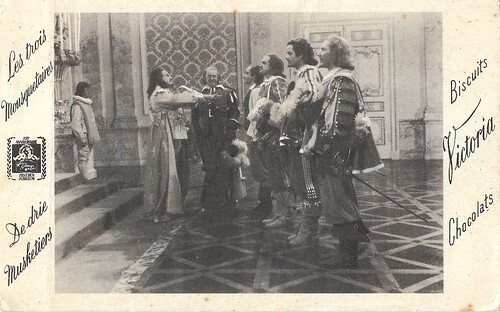
Belgian postcard by Victoria Biscuits Chocolats, no. 4. Photo: M.G.M. Frank Morgan, Reginald Owen, Gene Kelly, Van Heflin, Gig Young, and Robert Coote in The Three Musketeers (George Sidney, 1948), based on the novel by Alexandre Dumas.
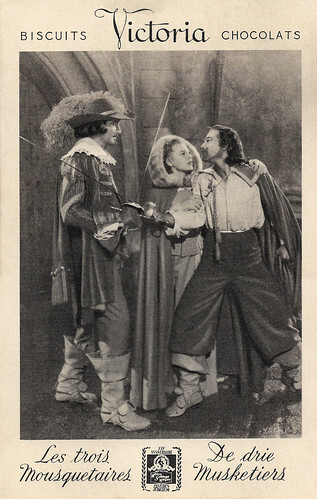
Belgian postcard by Victoria Biscuits Chocolats, no. 8. Photo: M.G.M. June Allyson and Gene Kelly in The Three Musketeers (George Sidney, 1948), based on the novel by Alexandre Dumas.
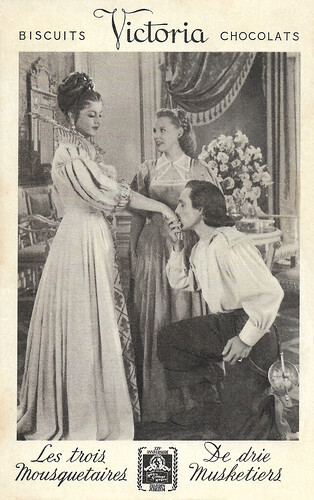
Belgian postcard by Victoria Biscuits Chocolats, no. 12. Photo: M.G.M. Angela Lansbury , June Allyson, and Gene Kelly in The Three Musketeers (George Sidney, 1948), based on the novel by Alexandre Dumas.
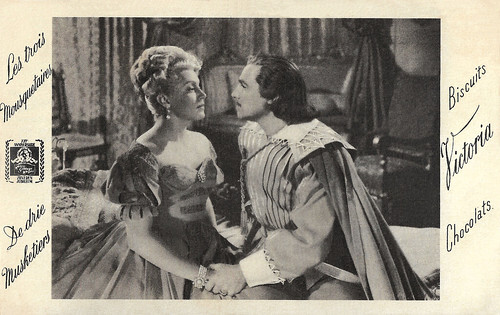
Belgian postcard by Victoria Biscuits Chocolats, no. 17. Photo: M.G.M. Lana Turner and Gene Kelly in The Three Musketeers (George Sidney, 1948), based on the novel by Alexandre Dumas.
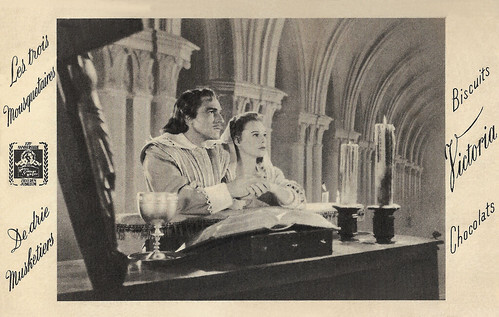
Belgian postcard by Victoria Biscuits Chocolats, no. 19. Photo: M.G.M. Gene Kelly and June Allyson in The Three Musketeers (George Sidney, 1948), based on the novel by Alexandre Dumas.
The 15th greatest male screen legend of Classic Hollywood
Kelly continued his string of classic Hollywood musicals with Brigadoon (1954) with Cyd Charisse , and It's Always Fair Weather (1955), co-directed with Donen. The latter was a musical satire on television and advertising and includes his roller-skate dance routine to 'I Like Myself', and a dance trio with Michael Kidd and Dan Dailey that Kelly used to experiment with the widescreen possibilities of Cinemascope.
Next followed Kelly's last musical film for MGM, Les Girls (1957), in which he partnered a trio of leading ladies, Mitzi Gaynor, Kay Kendall, and Taina Elg. It, too, sold only a few movie tickets. He finally made for MGM The Happy Road (1957), set in his beloved France, his first foray in a new role as producer-director-actor. After leaving MGM, Kelly returned to stage work.
After musicals got out of fashion, Gene Kelly starred in two films outside the musical genre: Inherit the Wind (Stanley Kramer, 1960) with Spencer Tracey and Fredric March , and What a Way to Go! (1964).
In 1967, he appeared in French musical comedy Les Demoiselles de Rochefort/The Young Girls of Rochefort (Jacques Demy, 1967) opposite Catherine Deneuve . It was a box-office success in France and was nominated for Academy Awards for Best Music and Score of a Musical Picture.
Kelly directed films without a collaborator, including the bedroom-farce comedy A Guide for the Married Man (1967) starring Walter Matthau, and the musical Hello, Dolly! (1969) starring Barbra Streisand and Matthau. The latter was nominated for the Academy Award for Best Picture.
He appeared as one of many special narrators in the surprise hit That's Entertainment! (Jack Haley Jr., 1974). The compilation film was released by Metro-Goldwyn-Mayer to celebrate the studio's 50th anniversary. The film turned the spotlight on MGM's legacy of musical films from the 1920s through the 1950s.
Kelly subsequently directed and co-starred with his friend Fred Astaire in the sequel That's Entertainment, Part II (Gene Kelly, 1976). It was a measure of his powers of persuasion that he managed to coax the 77-year-old Astaire — who had insisted that his contract rule out any dancing, having long since retired — into performing a series of song-and-dance duets, evoking a powerful nostalgia for the glory days of the American musical film.
It was later followed by That's Dancing! (Jack Haley Jr., 1985), and That's Entertainment, Part III (Bud Friedgen, Michael J. Sheridan, 1994). Kelly received lifetime achievement awards in the Kennedy Center Honors (1982) and from the Screen Actors Guild and American Film Institute. In 1999, the American Film Institute also ranked him as the 15th greatest male screen legend of Classic Hollywood Cinema.
Gene Kelly passed away in 1996 at the age of 83 in Beverly Hills, California, U.S. His final film project was the animated film Cats Don't Dance, not released until 1997, on which Kelly acted as an uncredited choreographic consultant. It was dedicated to his memory. Gene Kelly was married three times: to actress Betsy Blair (1941-1957), Jeanne Coyne (1960- her death in 1973), and Patricia Ward (1990- his death in 1996).

Dutch postcard by Foto Archief Film en Toneel, no. 3454. Photo: M.G.M. Van Heflin, Gene Kelly, Gig Young, and Robert Coote in The Three Musketeers (George Sidney, 1948), based on the novel by Alexandre Dumas.
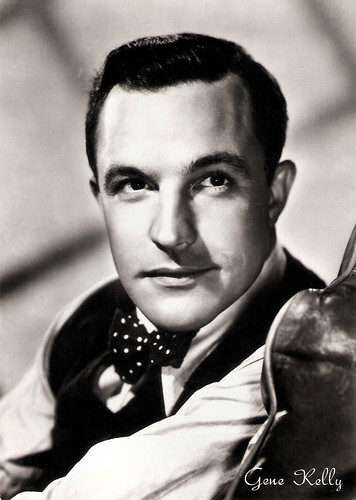
Italian postcard by Rotalfoto, Milano, no. 395.
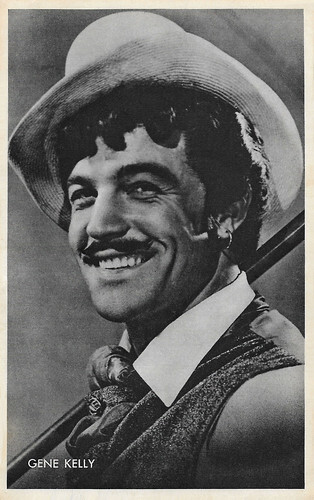
Belgian collectors card by Kwatta, Bois d'Haine, no. C. 153. Photo: M.G.M. Gene Kelly in The Pirate (Vincente Minnelli, 1948).
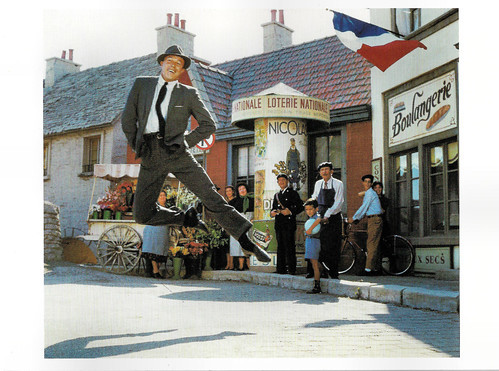
American postcard by Fotofolio, no. 2859. Photo: Milton H. Greene. Caption: Gene Kelly, Los Angeles, 1959. Gene Kelly in The Happy Road (Gene Kelly, 1957).
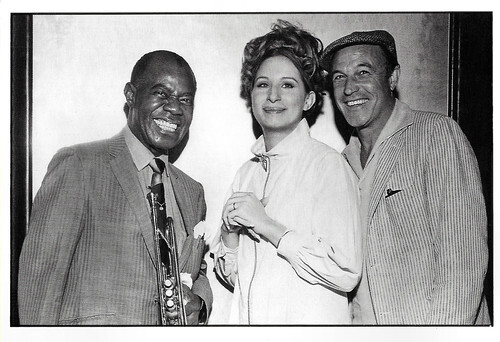
French postcard in the Entr'acte series by Éditions Asphodèle, Mâcon, no. 005/13. Collection: B. Courtel / D.R. Louis Armstrong , Barbra Streisand, and Gene Kelly on the set of Hello Dolly! (Gene Kelly, 1969). Caption: A moment of pause for Gene Kelly and his stars Barbra Streisand and Louis Armstrong.
Sources: (IMDb), Wikipedia, and .

French postcard, no. 1. Photo: Metro-Goldwyn-Mayer. Vera Ellen and Gene Kelly in On the Town (Stanley Donen, Gene Kelly, 1949).

Vintage autograph card. Photo: Leslie Caron and Gene Kelly in An American in Paris (Vincente Minnelli, 1951).

Dutch postcard. Photo: M.G.M. Gene Kelly and Cyd Charisse in Singin' in the Rain (Stanley Donen, Gene Kelly, 1952).

Belgian postcard by Les Editions d'Art L.A.B., Brussels, no. 2020. Photo: Metro-Goldwyn-Mayer. Kathryn Grayson and Gene Kelly in Thousands Cheer (George Sidney, 1943).

Dutch postcard by van Leer's Fotodrukindustrie N.V., Amsterdam, no. 351, no. 6. Photo: Metro Goldwyn Mayer (M.G.M.) June Allyson and Gene Kelly in The Three Musketeers (George Sidney, 1948), based on the novel by Alexandre Dumas.
An accomplished sportsman and able to defend himself
Eugene Curran Kelly was born in 1912 in the East Liberty neighborhood of Pittsburgh. He was the third son of James Patrick Joseph Kelly, a phonograph salesman, and his wife, Harriet Catherine Curran.
By the time he decided to dance, he was an accomplished sportsman and able to defend himself. He attended St. Raphael Elementary School in the Morningside neighbourhood of Pittsburgh and graduated from Peabody High School at age 16. He entered Pennsylvania State College as a journalism major, but after the 1929 crash, he left school and found work in order to help his family financially.
He created dance routines with his younger brother Fred to earn prize money in local talent contests. They also performed in local nightclubs. In 1931, Kelly enrolled at the University of Pittsburgh to study economics. His family opened a dance studio in the Squirrel Hill neighborhood of Pittsburgh.
In 1932, they renamed it the Gene Kelly Studio of the Dance and opened a second location in Johnstown, Pennsylvania, in 1933. Kelly served as a teacher at the studio during his undergraduate and law-student years at Pitt. Kelly eventually decided to pursue a career as a dance teacher and full-time entertainer, so he dropped out of law school after two months.
In 1937, having successfully managed and developed the family's dance school business, he finally did move to New York City in search of work as a choreographer. His first Broadway assignment, in 1938, was as a dancer in Cole Porter's 'Leave It to Me!'
Kelly's first big breakthrough was in the Pulitzer Prize-winning 'The Time of Your Life' (1939), in which, for the first time on Broadway, he danced to his own choreography. In 1940, he got the lead role in Rodgers and Hart's 'Pal Joey', choreographed by Robert Alton. This role propelled him to stardom. Offers from Hollywood began to arrive.

British postcard in the Picturegoer Series, London, no. W 262. Photo: Metro-Goldwyn-Mayer (M.G.M.).

Vintage card. Photo: Metro-Goldwyn-Mayer (M.G.M.).

Italian postcard in the Divi del Cinema series by Vetta Traldi, Milano, no. 102.

Italian postcard by B.F.F. Edit. (Casa Editr. Ballerini & Fratini, Firenze), no. 2879. Photo: Metro-Goldwyn-Mayer (M.G.M.).

French postcard by Edition P.I., Paris, no. 211, offered by Victoria, Brussels, no. 639. Photo: Metro-Goldwyn-Mayer, 1950.
The most inventive and effervescent musical
Metro-Goldwyn-Mayer was the largest and most powerful studio in Hollywood when Gene Kelly arrived in town in 1941. There he made his film debut with Judy Garland in For Me and My Gal (Busby Berkeley, 1942). The film was a production of the Arthur Freed unit at MGM and it was one of the big hits of the year.
The talent pool at MGM was especially large during World War II when Hollywood was a refuge for many musicians and others in the performing arts of Europe who were forced to flee the Nazis. Kelly's film debut was followed by Cole Porter's Du Barry Was a Lady (Roy Del Ruth, 1943) with Lucille Ball, the morale booster Thousands Cheer (George Sidney, 1943), Cover Girl (Charles Vidor, 1944) opposite Rita Hayworth , and Anchors Aweigh (George Sidney, 1945) with Frank Sinatra .
MGM gave him a free hand to devise a range of dance routines for the latter, including his duets with Sinatra and the celebrated animated dance with Jerry Mouse — the animation for which was supervised by William Hanna and Joseph Barbera. Anchors Aweigh became one of the most successful films of 1945 and Kelly was nominated for the Academy Award for Best Actor.
In Ziegfeld Follies (1946), Kelly collaborated with Fred Astaire, for whom he had the greatest admiration, in 'The Babbitt and the Bromide' challenge dance routine. He co-starred with Judy Garland in The Pirate (Vincente Minnelli, 1948) which gave full rein to Kelly's athleticism. It features Kelly's work with the Nicholas Brothers — the leading black dancers of their day — in a virtuoso dance routine. Now regarded as a classic, the film was ahead of its time but flopped at the box office.
Kelly made his debut as a director with On the Town (Gene Kelly, 1949), for Arthur Freed. Stanley Donen, brought to Hollywood by Kelly to be his assistant choreographer, received co-director credit for On the Town. A breakthrough in the musical film genre, it has been described as "the most inventive and effervescent musical thus far produced in Hollywood."
Two musicals secured Gene Kelly's reputation as a major figure in the American musical film. First, he directed and starred in An American in Paris (Gene Kelly, 1951) with Leslie Caron . The highlight of the film is the seventeen-minute ballet sequence set to the title song written by George Gershwin and choreographed by Kelly. The sequence cost a half-million dollars (U.S.) to make in 1951 dollars.
Kelly's many innovations transformed the Hollywood musical, and he is credited with almost single-handedly making the ballet form commercially acceptable to film audiences. In 1952, he received an Academy Honorary Award for his career achievements, the same year An American in Paris won six Academy Awards, including Best Picture.
Probably the most admired of all film musicals is his next film, Singin' in the Rain (1952). As co-director, lead star, and choreographer, Kelly was the central driving force and unforgettable is Kelly's celebrated and much-imitated solo dance routine to the title song. Dale O'Connor at IMDb : "Kelly was in the same league as Fred Astaire, but instead of a top hat and tails Kelly wore work clothes that went with his masculine, athletic dance style."

Belgian postcard by Victoria Biscuits Chocolats, no. 4. Photo: M.G.M. Frank Morgan, Reginald Owen, Gene Kelly, Van Heflin, Gig Young, and Robert Coote in The Three Musketeers (George Sidney, 1948), based on the novel by Alexandre Dumas.

Belgian postcard by Victoria Biscuits Chocolats, no. 8. Photo: M.G.M. June Allyson and Gene Kelly in The Three Musketeers (George Sidney, 1948), based on the novel by Alexandre Dumas.

Belgian postcard by Victoria Biscuits Chocolats, no. 12. Photo: M.G.M. Angela Lansbury , June Allyson, and Gene Kelly in The Three Musketeers (George Sidney, 1948), based on the novel by Alexandre Dumas.

Belgian postcard by Victoria Biscuits Chocolats, no. 17. Photo: M.G.M. Lana Turner and Gene Kelly in The Three Musketeers (George Sidney, 1948), based on the novel by Alexandre Dumas.

Belgian postcard by Victoria Biscuits Chocolats, no. 19. Photo: M.G.M. Gene Kelly and June Allyson in The Three Musketeers (George Sidney, 1948), based on the novel by Alexandre Dumas.
The 15th greatest male screen legend of Classic Hollywood
Kelly continued his string of classic Hollywood musicals with Brigadoon (1954) with Cyd Charisse , and It's Always Fair Weather (1955), co-directed with Donen. The latter was a musical satire on television and advertising and includes his roller-skate dance routine to 'I Like Myself', and a dance trio with Michael Kidd and Dan Dailey that Kelly used to experiment with the widescreen possibilities of Cinemascope.
Next followed Kelly's last musical film for MGM, Les Girls (1957), in which he partnered a trio of leading ladies, Mitzi Gaynor, Kay Kendall, and Taina Elg. It, too, sold only a few movie tickets. He finally made for MGM The Happy Road (1957), set in his beloved France, his first foray in a new role as producer-director-actor. After leaving MGM, Kelly returned to stage work.
After musicals got out of fashion, Gene Kelly starred in two films outside the musical genre: Inherit the Wind (Stanley Kramer, 1960) with Spencer Tracey and Fredric March , and What a Way to Go! (1964).
In 1967, he appeared in French musical comedy Les Demoiselles de Rochefort/The Young Girls of Rochefort (Jacques Demy, 1967) opposite Catherine Deneuve . It was a box-office success in France and was nominated for Academy Awards for Best Music and Score of a Musical Picture.
Kelly directed films without a collaborator, including the bedroom-farce comedy A Guide for the Married Man (1967) starring Walter Matthau, and the musical Hello, Dolly! (1969) starring Barbra Streisand and Matthau. The latter was nominated for the Academy Award for Best Picture.
He appeared as one of many special narrators in the surprise hit That's Entertainment! (Jack Haley Jr., 1974). The compilation film was released by Metro-Goldwyn-Mayer to celebrate the studio's 50th anniversary. The film turned the spotlight on MGM's legacy of musical films from the 1920s through the 1950s.
Kelly subsequently directed and co-starred with his friend Fred Astaire in the sequel That's Entertainment, Part II (Gene Kelly, 1976). It was a measure of his powers of persuasion that he managed to coax the 77-year-old Astaire — who had insisted that his contract rule out any dancing, having long since retired — into performing a series of song-and-dance duets, evoking a powerful nostalgia for the glory days of the American musical film.
It was later followed by That's Dancing! (Jack Haley Jr., 1985), and That's Entertainment, Part III (Bud Friedgen, Michael J. Sheridan, 1994). Kelly received lifetime achievement awards in the Kennedy Center Honors (1982) and from the Screen Actors Guild and American Film Institute. In 1999, the American Film Institute also ranked him as the 15th greatest male screen legend of Classic Hollywood Cinema.
Gene Kelly passed away in 1996 at the age of 83 in Beverly Hills, California, U.S. His final film project was the animated film Cats Don't Dance, not released until 1997, on which Kelly acted as an uncredited choreographic consultant. It was dedicated to his memory. Gene Kelly was married three times: to actress Betsy Blair (1941-1957), Jeanne Coyne (1960- her death in 1973), and Patricia Ward (1990- his death in 1996).

Dutch postcard by Foto Archief Film en Toneel, no. 3454. Photo: M.G.M. Van Heflin, Gene Kelly, Gig Young, and Robert Coote in The Three Musketeers (George Sidney, 1948), based on the novel by Alexandre Dumas.

Italian postcard by Rotalfoto, Milano, no. 395.

Belgian collectors card by Kwatta, Bois d'Haine, no. C. 153. Photo: M.G.M. Gene Kelly in The Pirate (Vincente Minnelli, 1948).

American postcard by Fotofolio, no. 2859. Photo: Milton H. Greene. Caption: Gene Kelly, Los Angeles, 1959. Gene Kelly in The Happy Road (Gene Kelly, 1957).

French postcard in the Entr'acte series by Éditions Asphodèle, Mâcon, no. 005/13. Collection: B. Courtel / D.R. Louis Armstrong , Barbra Streisand, and Gene Kelly on the set of Hello Dolly! (Gene Kelly, 1969). Caption: A moment of pause for Gene Kelly and his stars Barbra Streisand and Louis Armstrong.
Sources: (IMDb), Wikipedia, and .
Published on May 20, 2022 22:00
May 19, 2022
Laura Nucci
Italian actress Laura Nucci (1913-1994) was one of the stars of the Fascist era. Between 1930 and 1989, she appeared in more than 60 films and TV series.
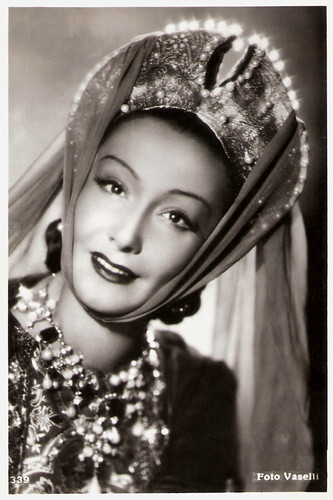
Italian postcard by Armando Terzoli, Roma, no. 339. Photo: Vaselli. Postcard for the film Rita da Cascia (Antonio Leonviola, 1943).
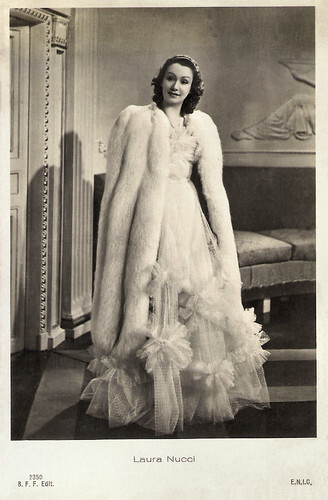
Italian postcard by Ed. Ballerini & Fratini (B.F.F. Edit.), Firenze, no. 2350. Photo: E.N.I.C.
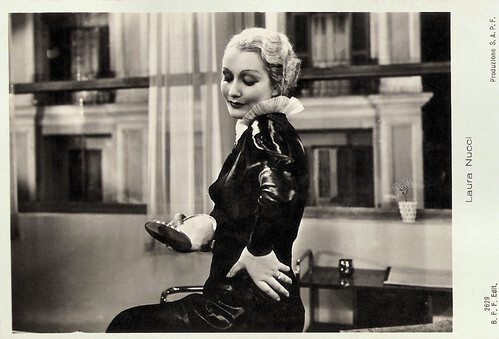
Italian postcard by Ed. Ballerini & Fratini (B.F.F. Edit.), Firenze, no. 2629. Photo: Produzione S.A.P.F. (Società Anonima Produzione Film).Laura Nucci in L'impiegata di papà/Dad's employee (Alessandro Blasetti, 1934).
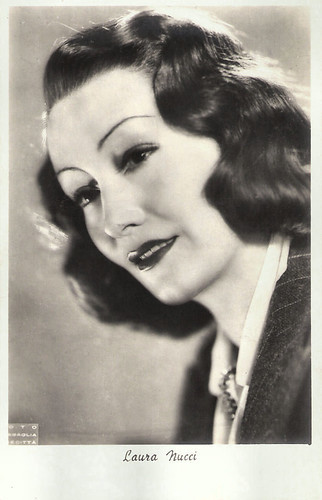
Italian postcard. Photo: Bragaglia, Cinecittà, no. 7788.
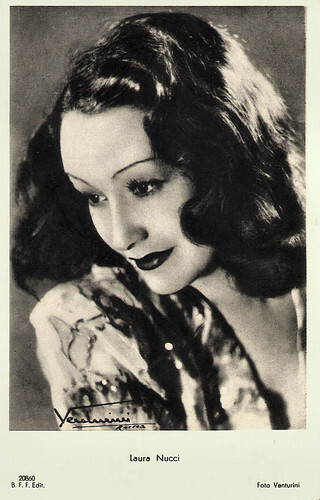
Italian postcard by Ed. Ballerini & Fratini (B.F.F. Edit.), Firenze, no. 20860. Photo: Venturini.
Beauty competition
Laura Nucci was born Maria Laura Lodovici in Carrara, Italy in 1913. She was the sister of actor and stage author Carlo Lodovici.
After she had won a beauty competition at the age of 16, the elegant and voluptuous Nucci made her film debut in the silent film La Leggenda di Wally (Gian Orlando Vassallo, 1930) featuring Linda Pini as La Wally.
One of her next films was the historical drama Palio (1932) directed by Alessandro Blasetti and starring Leda Gloria. The film is set against the backdrop of the Palio di Siena horse race during the Medieval era.
Nucci continued the collaboration with director Alessandro Blasetti and she played the antagonist or the femme fatale in many of his films. She also appeared in films like the comedy Un cattivo soggetto/Bad Subject (Carlo Ludovico Bragaglia, 1933), starring Vittorio De Sica .
Soon she was one of the stars of the Italian cinema of the Fascist era. One of the most important films of the Mussolini regime was the historical film Condottieri (1937) directed by Luis Trenker and starring Trenker, Loris Gizzi, and Laura Nucci.
It portrays the life of Giovanni de' Medici, a celebrated Condottiere of the sixteenth century. A separate German-language version was also made. The film received 9.6 million lire of funding from the Italian government, as part of a major drive by the Fascist authorities to develop the Italian film industry (which also involved the construction of the large Cinecittà complex in Rome).
Along with Scipio Africanus, the film was an attempt to harness history to support the Fascist regime's current policies. Condottieri drew parallels between the dictator Benito Mussolini and the historical figure of de' Medici, portraying both as unifying Italy. She also starred in the adventure film Fra' Diavolo/The Adventures of Fra Diavolo (Luigi Zampa, 1942) opposite Enzo Fiermonte. During the German occupation of Rome in 1943-1944, Laura Nucci became a close friend of Erich Priebke, the captain of the Gestapo.
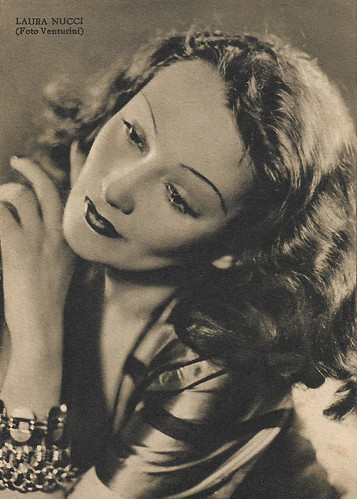
Italian postcard by Rizzoli & C., Milano, 1941. Photo: Venturini.
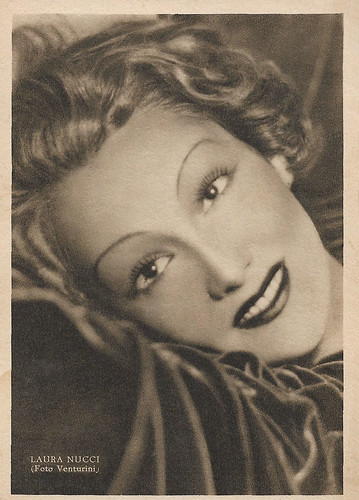
Italian postcard by Rizzoli & C., Milano, 1940. Photo: Venturini.
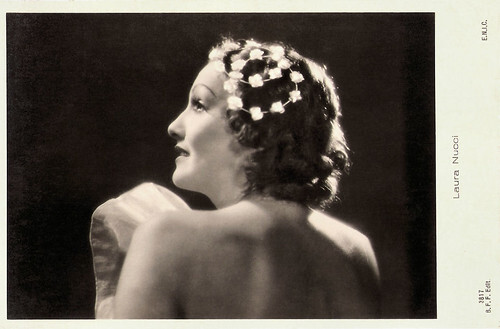
Italian postcard by Ed. Ballerini & Fratini (B.F.F. Edit.), Firenze, no. 3817. Photo: E.N.I.C.
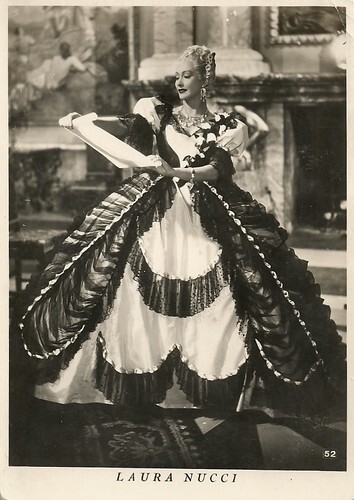
Italian postcard, no. 52. Photo: Vaselli.
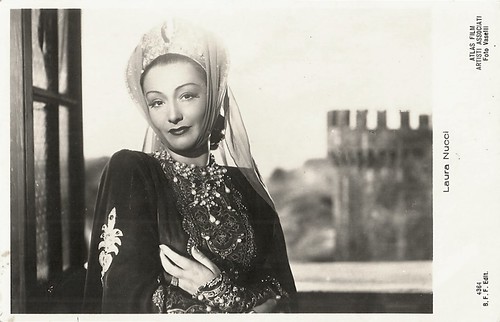
Italian postcard by Ed. Ballerini & Fratini, Firenze, no. 4364. Photo: Vaselli / Atlas Film / Artisti Associati. Publicity still for Rita da Cascia (Antonio Leonviola, 1943).
Spaghetti Western
Laura Nucci’s career halted in 1943. It was set back by the downfall of the fascist regime, but from 1950 on, she began appearing in films again as a character actress.
She also worked regularly for Italian television. She was part of the cast of the TV series Pride and Prejudice (Daniele D'Anza, 1957).
During the 1960s and 1970s, Nucci appeared in several genre films. The peplum Anthar l'invincibile/Devil of the Desert Against the Son of Hercules (Antonio Margheriti, 1964) was an Italian/French/Spanish co-production filmed in Algeria and featuring bodybuilder Kirk Morris.
She also appeared in a Spaghetti Western, Ramon il Messicano/Ramon the Mexican (Maurizio Pradeaux, 1966). In the Giallo Solamente nero/The Bloodstained Shadow (Antonio Bido, 1978), she played the stepmother of Stefania Casini.
One of her best-known films is the crime film A ciascuno il suo/We Still Kill the Old Way (Elio Petri, 1967), starring Gian Maria Volonté and Irene Papas . It was entered into the 1967 Cannes Film Festival where it won the award for Best Screenplay. It was written by Elio Petri and Ugo Pirro.
On television, Nucci played the role of Mrs. Ida in the film Ricomincio da tre/Groundhog Day Three (Massimo Troisi, 1981). She was also known for films such as Colpire al cuore/Blow to the Heart (Gianni Amelio, 1983) and Fratelli d'Italia (Neri Parenti 1989).
Laura Nucci died in 1994 in Rome, Lazio, Italy.
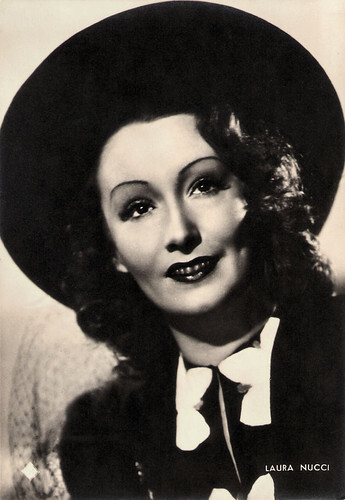
Italian postcard by Aser, Roma, no. N 1. Photo: Ciolfi.
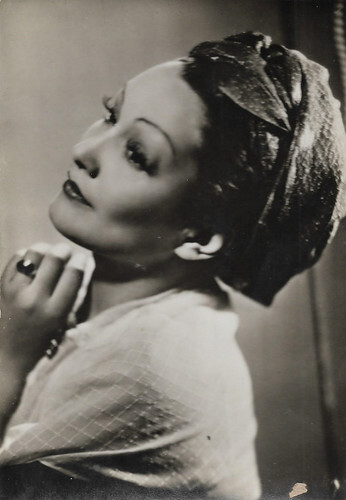
Italian postcard by Fotopan, Rotante, no. 552, 1941.
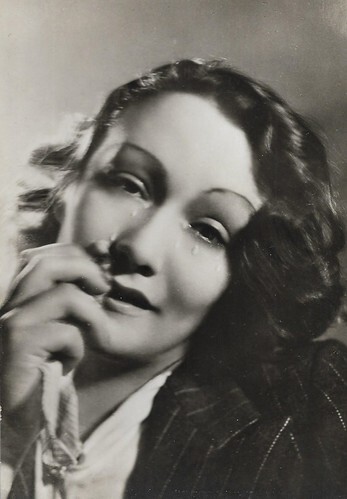
Italian postcard by Fotopan, Rotante, no. 0032, 1941.
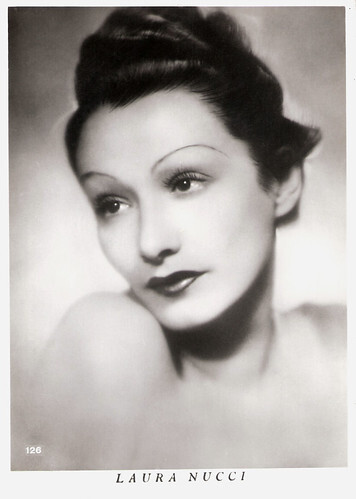
Italian postcard by Armando Terzoli, Roma, no. 126.
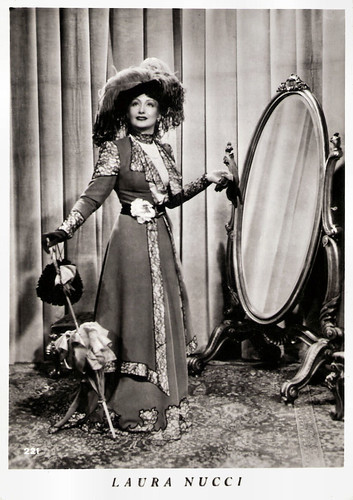
Italian postcard by Armando Terzoli, Roma, no. 221. Photo: Pesce. Publicity still for La Signorina/The young lady (Ladislao Kish, 1942).
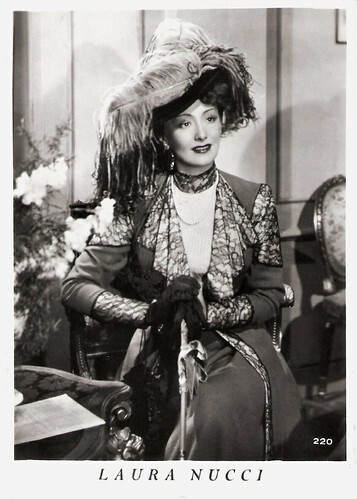
Italian postcard by Armando Terzoli, Roma, no. 220. Photo: Pesce. Publicity still for La Signorina/The young lady (Ladislao Kish, 1942).
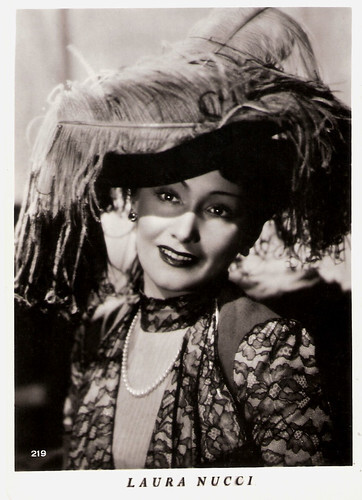
Italian postcard by Armando Terzoli, Roma, no. 219. Photo: Pesce. Publicity still for La Signorina/The young lady (Ladislao Kish, 1942).
Sources: Wikipedia (English, German and Italian) and .

Italian postcard by Armando Terzoli, Roma, no. 339. Photo: Vaselli. Postcard for the film Rita da Cascia (Antonio Leonviola, 1943).

Italian postcard by Ed. Ballerini & Fratini (B.F.F. Edit.), Firenze, no. 2350. Photo: E.N.I.C.

Italian postcard by Ed. Ballerini & Fratini (B.F.F. Edit.), Firenze, no. 2629. Photo: Produzione S.A.P.F. (Società Anonima Produzione Film).Laura Nucci in L'impiegata di papà/Dad's employee (Alessandro Blasetti, 1934).

Italian postcard. Photo: Bragaglia, Cinecittà, no. 7788.

Italian postcard by Ed. Ballerini & Fratini (B.F.F. Edit.), Firenze, no. 20860. Photo: Venturini.
Beauty competition
Laura Nucci was born Maria Laura Lodovici in Carrara, Italy in 1913. She was the sister of actor and stage author Carlo Lodovici.
After she had won a beauty competition at the age of 16, the elegant and voluptuous Nucci made her film debut in the silent film La Leggenda di Wally (Gian Orlando Vassallo, 1930) featuring Linda Pini as La Wally.
One of her next films was the historical drama Palio (1932) directed by Alessandro Blasetti and starring Leda Gloria. The film is set against the backdrop of the Palio di Siena horse race during the Medieval era.
Nucci continued the collaboration with director Alessandro Blasetti and she played the antagonist or the femme fatale in many of his films. She also appeared in films like the comedy Un cattivo soggetto/Bad Subject (Carlo Ludovico Bragaglia, 1933), starring Vittorio De Sica .
Soon she was one of the stars of the Italian cinema of the Fascist era. One of the most important films of the Mussolini regime was the historical film Condottieri (1937) directed by Luis Trenker and starring Trenker, Loris Gizzi, and Laura Nucci.
It portrays the life of Giovanni de' Medici, a celebrated Condottiere of the sixteenth century. A separate German-language version was also made. The film received 9.6 million lire of funding from the Italian government, as part of a major drive by the Fascist authorities to develop the Italian film industry (which also involved the construction of the large Cinecittà complex in Rome).
Along with Scipio Africanus, the film was an attempt to harness history to support the Fascist regime's current policies. Condottieri drew parallels between the dictator Benito Mussolini and the historical figure of de' Medici, portraying both as unifying Italy. She also starred in the adventure film Fra' Diavolo/The Adventures of Fra Diavolo (Luigi Zampa, 1942) opposite Enzo Fiermonte. During the German occupation of Rome in 1943-1944, Laura Nucci became a close friend of Erich Priebke, the captain of the Gestapo.

Italian postcard by Rizzoli & C., Milano, 1941. Photo: Venturini.

Italian postcard by Rizzoli & C., Milano, 1940. Photo: Venturini.

Italian postcard by Ed. Ballerini & Fratini (B.F.F. Edit.), Firenze, no. 3817. Photo: E.N.I.C.

Italian postcard, no. 52. Photo: Vaselli.

Italian postcard by Ed. Ballerini & Fratini, Firenze, no. 4364. Photo: Vaselli / Atlas Film / Artisti Associati. Publicity still for Rita da Cascia (Antonio Leonviola, 1943).
Spaghetti Western
Laura Nucci’s career halted in 1943. It was set back by the downfall of the fascist regime, but from 1950 on, she began appearing in films again as a character actress.
She also worked regularly for Italian television. She was part of the cast of the TV series Pride and Prejudice (Daniele D'Anza, 1957).
During the 1960s and 1970s, Nucci appeared in several genre films. The peplum Anthar l'invincibile/Devil of the Desert Against the Son of Hercules (Antonio Margheriti, 1964) was an Italian/French/Spanish co-production filmed in Algeria and featuring bodybuilder Kirk Morris.
She also appeared in a Spaghetti Western, Ramon il Messicano/Ramon the Mexican (Maurizio Pradeaux, 1966). In the Giallo Solamente nero/The Bloodstained Shadow (Antonio Bido, 1978), she played the stepmother of Stefania Casini.
One of her best-known films is the crime film A ciascuno il suo/We Still Kill the Old Way (Elio Petri, 1967), starring Gian Maria Volonté and Irene Papas . It was entered into the 1967 Cannes Film Festival where it won the award for Best Screenplay. It was written by Elio Petri and Ugo Pirro.
On television, Nucci played the role of Mrs. Ida in the film Ricomincio da tre/Groundhog Day Three (Massimo Troisi, 1981). She was also known for films such as Colpire al cuore/Blow to the Heart (Gianni Amelio, 1983) and Fratelli d'Italia (Neri Parenti 1989).
Laura Nucci died in 1994 in Rome, Lazio, Italy.

Italian postcard by Aser, Roma, no. N 1. Photo: Ciolfi.

Italian postcard by Fotopan, Rotante, no. 552, 1941.

Italian postcard by Fotopan, Rotante, no. 0032, 1941.

Italian postcard by Armando Terzoli, Roma, no. 126.

Italian postcard by Armando Terzoli, Roma, no. 221. Photo: Pesce. Publicity still for La Signorina/The young lady (Ladislao Kish, 1942).

Italian postcard by Armando Terzoli, Roma, no. 220. Photo: Pesce. Publicity still for La Signorina/The young lady (Ladislao Kish, 1942).

Italian postcard by Armando Terzoli, Roma, no. 219. Photo: Pesce. Publicity still for La Signorina/The young lady (Ladislao Kish, 1942).
Sources: Wikipedia (English, German and Italian) and .
Published on May 19, 2022 22:00
May 18, 2022
Soviet film postcards of the 1920s
During the 1920s, the cinema of the Soviet Union was at its best. But who were the actors in these films? Vintage postcards of the Soviet cinema of the 1920s are rare. But in 1927, a new postcard series was introduced by Goznak in Moscow, which presented both pictures of Russian actors and of the stars of the silent European cinema and Hollywood.
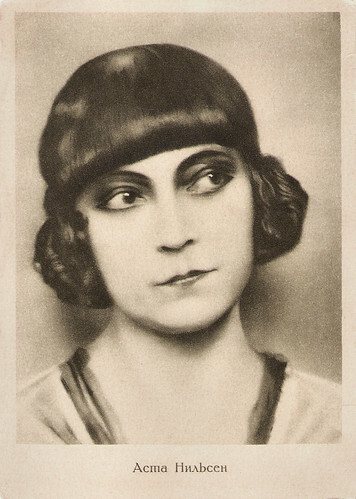
Russian postcard by Goziak, Moscow, series, no. 2, no. A-1725, 1927. The card was issued in an edition of 15,000 copies.
Danish silent film actress Asta Nielsen (1881-1972), was one of the most popular leading ladies of the 1910s and one of the first international film stars. Of her 74 films between 1910 and 1932, seventy were made in Germany where she was known simply as 'Die Asta'. Noted for her large dark eyes, mask-like face, and boyish figure, Nielsen most often portrayed strong-willed passionate women trapped by tragic consequences.
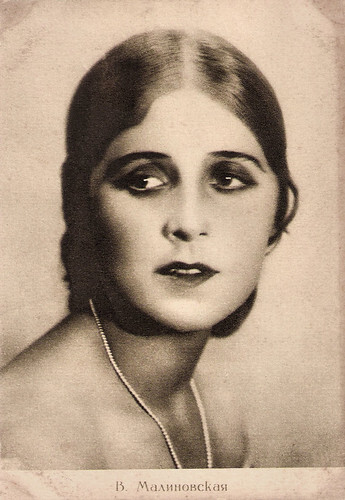
Russian postcard by Goziak, Moscow, series no. 4, no. A-2400, 1927. Published in an edition of 25,000 cards.
Vera Malinovskaya (1900-1988), also written as Malinovskaja or Malinovskaia, played in several Russian films of the 1920s and also in a few films in Germany and Austria. From 1925 on, she had leading roles in films by the Mezhrabpom film company, often playing innocent girls. In 1925 she played Dunia opposite Ivan Moskvin in Kollezhskiy registrator/The Station Master (Ivan Moskvin, Yuri Zhelyabuzhsky, 1925), scripted by Fyodor Otsep (Fedor Ozep), after a novel by Alexander Pushkin.
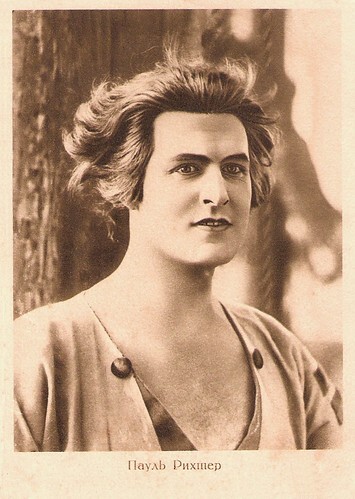
Russian postcard by Goziak, Moscow. Paul Richter in Pietro der Korsar/Peter the Pirate (Arthur Robison, 1925).
Austrian actor Paul Richter (1895-1961) starred in several silent films directed by Joe May and Fritz Lang. He became an idol of the 1920s with the lushly produced Ufa production Die Nibelungen (Fritz Lang, 1924).
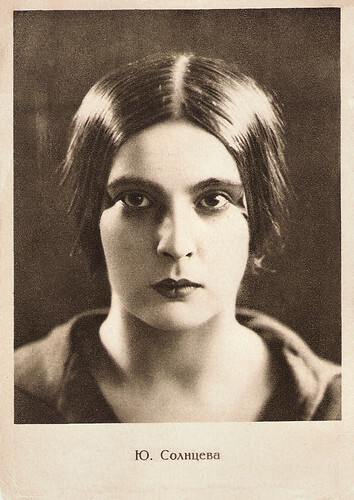
Russian postcard by Goziak, Moscow, no. 2, 1927.
Yuliya Solntseva (1901–1989) was a Soviet film director and actress who starred as the Queen of Mars in the silent Sci-Fi classic Aelita (Yakov Protazanov, 1924) and as a cigarette girl in the romantic comedy Papirosnitsa ot Mosselproma/The Cigarette Girl of Mosselprom (Yuri Zhelyabuzhsky, 1924). Solntseva directed 14 films between 1939 and 1979. She was married to director Aleksandr Dovzhenko and collaborated with him on his later films, including Michurin (1949), for which she was awarded a Stalin Prize. For Povest plamennykh let/The Chronicle of Flaming Years (1961), she won the Best Director award at the 1961 Cannes Film Festival. She was named a People's Artist of the USSR when she turned 80.
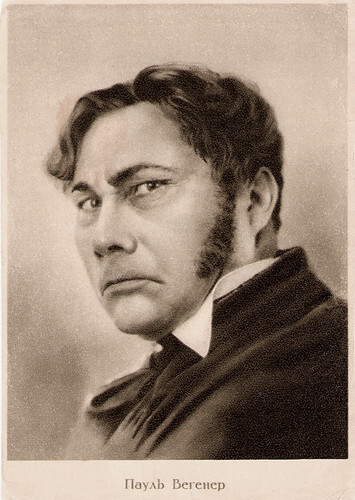
Russian postcard, no. 4, 1927.
German actor, writer, and film director Paul Wegener (1874-1948) is one of the true fathers of the horror and fantasy genre, particularly remembered for his three silent films centred around the Jewish legend of the Golem. Wegener was one of the pioneers of German cinema who realised the potential of the new medium and used the possibilities of cinematic trick photography as a method for presenting fantastic tales in a serious matter.
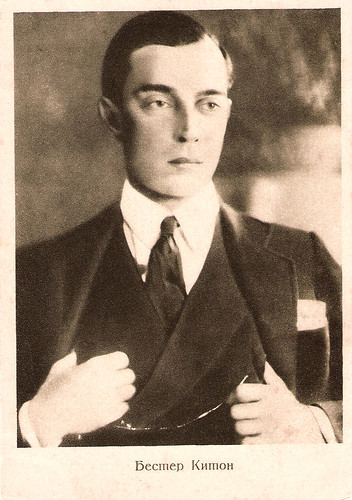
Russian postcard by Goziak, Moscow, no. 1725, 1927.
Stone-faced Buster Keaton (1895-1966) was one of the three greatest comedians of Silent Hollywood. His most enduring features include Our Hospitality (1923), The Navigator (1924), Sherlock Jr. (1924), College (1927), and The General (1927).
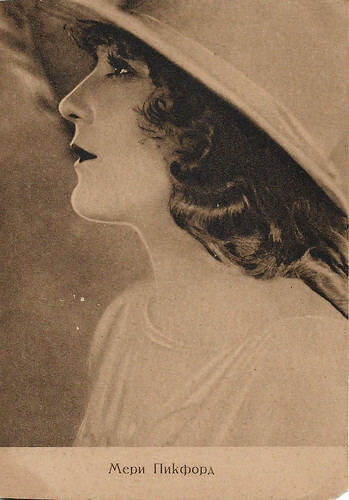
Russian postcard by Goziak, Moscow, no. A-11967, 1928. The card was issued in an edition of 25,000 copies.
Mary Pickford (1892-1979) was a legendary silent film actress and was known as 'America’s sweetheart'. She married Douglas Fairbanks, Sr. in 1920, becoming one of Hollywood’s earliest super couples. Fans adored the pairing, and the couple was mobbed at every port on their whirlwind European honeymoon. She scored box-office hits with Polyanna (1920), Little Lord Fauntleroy (1921), and Tess of the Storm Country (1922). She was a founder of United Artists and helped to establish the Academy.
The ideological and artistic needs of the proletariat
In 1924, filmmakers Sergei Eisenstein and Lev Kuleshov created the first association of Soviet filmmakers, the Association of Revolutionary Cinematography (ARK), to “meet the ideological and artistic needs of the proletariat”. Although state-controlled, the organisation was characterised by a pluralism of political and artistic views until the late 1920s.
One of the most iconic developments in film during this period that is still used in films today was editing and montage to create meaning. This style of filmmaking came to be known as 'the Kuleshov effect' and was employed to conserve film stock due to shortages during that period.
Innovation in Russian filmmaking was expressed particularly in the work of Eisenstein such as his films Bronenosets Potyomkin/Battleship Potemkin (1925) and Oktyabr': Desyat' dney kotorye potryasli mir/October: Ten Days That Shook the World (1928).
Also noteworthy was Vsevolod Pudovkin's adaptation of Maxim Gorky's Mat/Mother to the screen in 1926. Pudovkin developed themes of revolutionary history in the film Konets Sankt-Peterburga/The End of St. Petersburg (1927).
Other noteworthy silent films were films dealing with contemporary life such as Boris Barnet's Dom na Trubnoy/The House on Trubnaya (1928). The films of Yakov Protazanov were devoted to the revolutionary struggle and the shaping of a new way of life, such as Don Diego i Pelageya/Don Diego and Pelagia (1928).
And finally, the Ukrainian director Aleksandr Dovzhenko was noteworthy for the historical-revolutionary epic Arsenal (1929) and the poetic film Zemlya/Earth (1930).
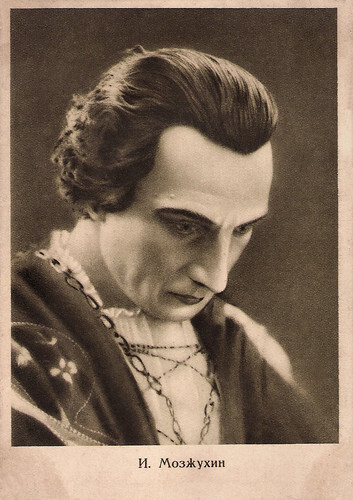
Russian postcard by Goziak, Moscow, series no. 5, no. A 4711, 1928. The card was issued in an edition of 25,000 copies. The price was 10 Kop. Photo: Ivan Mozzhukhin in Kean/Edmund Kean: Prince Among Lovers (Alexandre Volkoff, 1924).
Russian actor Ivan Mozzhukhin (1889-1939) was a legendary star of the European silent film. He escaped from execution by the Soviet Red Army and made a stellar career in Europe, but he suffered in Hollywood. He first starred in about thirty silent Russian films made by Pyotr Chardynin, Aleksandr Khanzhonkov, and Yevgeni Bauer. From 1915 to 1919 he worked in about 40 films by directors Yakov Protazanov and Viktor Tourjansky under the legendary Russian producer Joseph N. Ermolieff. After the Revolution, in 1920, he left Russia together with his wife Nathalie Lissenko and his partners from Ermolieff. They emigrated together to France and started in Paris a Russian-French film company. He starred in hits like the innovative murder mystery La maison du mystère/The Mysterious House (1923), Kean/Edmund Kean: Prince Among Lovers (1924), and the lavish adventure spectacle Michel Strogoff/Michael Strogoff (1926) based on the Jules Verne novel. Best remembered is the humourous and visually splendid epic Casanova/The Loves of Casanova (1927).
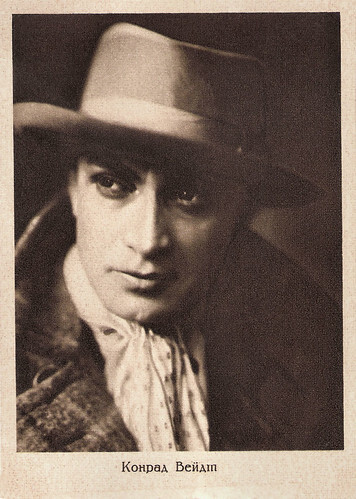
Russian postcard, no. 6, 1928.
Conrad Veidt (1893–1943) was the most highly strung and romantically handsome of the German expressionist actors. From 1916 until his death, he appeared in well over 100 films, including such classics as Das Kabinett des Dr. Caligari/Das Cabinet des Dr. Caligari (Robert Wiene, 1920) and Casablanca (Michael Curtiz, 1942).
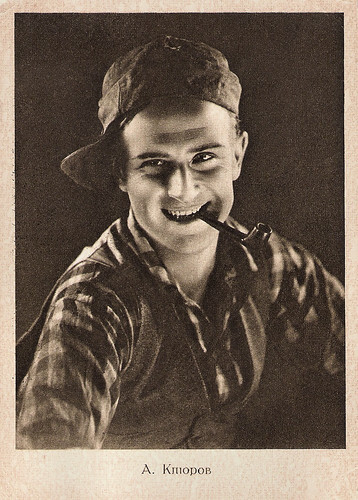
Russian postcard by Goziak, Moscow, series no. 9, no. A-15639, 1928. The card was issued in an edition of 10,000 copies. The price was 10 Kop.
Anatoli Ktorov (1898-1980) was a brilliant Soviet and Russian film and stage actor who was stuttering in real life but was perfectly eloquent in acting roles. He had a career spanning from silent films Yakov Protazanov to the Oscar-winning epic Voyna i mir/War and Peace (1965-1967). He became a People's Artist of the USSR in 1963.
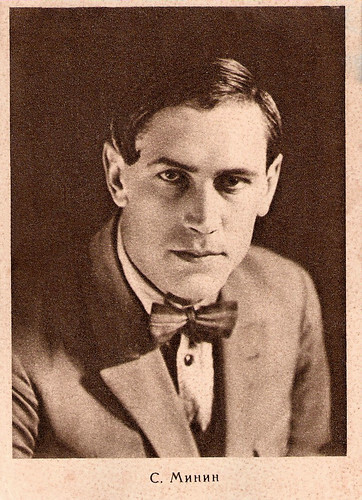
Russian postcard by Goziak, Moscow, series no. 8, no. A-16279, 1928. The card was issued in an edition of 30,000 copies. The price was 10 Kop.
Russian actor Sergei Minin (1901-1937) was a star of the Soviet cinema of the 1920s. He worked with such famous directors as Abram Room and Ilya Trauberg.
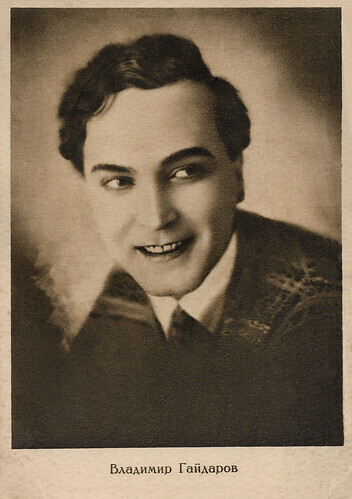
Russian postcard by Goziak, Moscow, series no. 5, no. A-47112, 1928. The card was issued in an edition of 25,000 copies. The price was 10 Kop.
Ukrainian actor Vladimir Gajdarov (1893-1976) (aka Wladimir Gaidarow and Vladimir Gaidaroff) was a popular star in the European silent cinema. He began his film career in Russia before the October Revolution. Later he became a popular star in the German and French silent cinema. The sound film made him return to his home country, but in the Soviet Union, he had a hard time getting work.
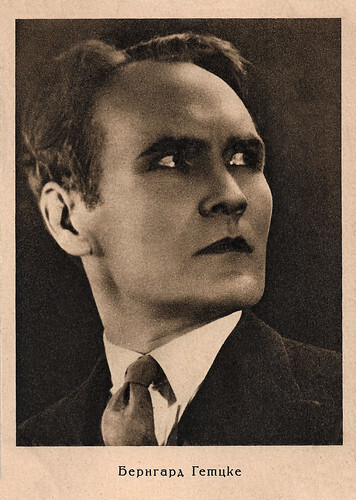
Russian postcard by Goziak, Moscow, series no. 14, no. A 29871, 1929. The card was issued in an edition of 15,000 copies. The price was 10 Kop.
German film actor Bernhard Goetzke (1884-1964) was one of the impressive stars of the silent films by Fritz Lang. He appeared in 130 films between 1917 and 1961.
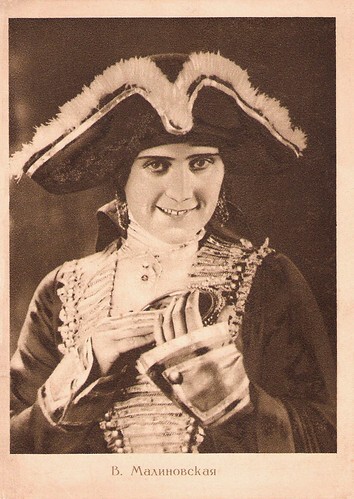
Russian postcard by Goziak, Moscow.
Vera Malinovskaya (1900-1988), also written as Malinovskaja/Malinovskaia, played in several Russian films of the 1920s and a few in Germany and Austria.
Sources: Wikipedia and .

Russian postcard by Goziak, Moscow, series, no. 2, no. A-1725, 1927. The card was issued in an edition of 15,000 copies.
Danish silent film actress Asta Nielsen (1881-1972), was one of the most popular leading ladies of the 1910s and one of the first international film stars. Of her 74 films between 1910 and 1932, seventy were made in Germany where she was known simply as 'Die Asta'. Noted for her large dark eyes, mask-like face, and boyish figure, Nielsen most often portrayed strong-willed passionate women trapped by tragic consequences.

Russian postcard by Goziak, Moscow, series no. 4, no. A-2400, 1927. Published in an edition of 25,000 cards.
Vera Malinovskaya (1900-1988), also written as Malinovskaja or Malinovskaia, played in several Russian films of the 1920s and also in a few films in Germany and Austria. From 1925 on, she had leading roles in films by the Mezhrabpom film company, often playing innocent girls. In 1925 she played Dunia opposite Ivan Moskvin in Kollezhskiy registrator/The Station Master (Ivan Moskvin, Yuri Zhelyabuzhsky, 1925), scripted by Fyodor Otsep (Fedor Ozep), after a novel by Alexander Pushkin.

Russian postcard by Goziak, Moscow. Paul Richter in Pietro der Korsar/Peter the Pirate (Arthur Robison, 1925).
Austrian actor Paul Richter (1895-1961) starred in several silent films directed by Joe May and Fritz Lang. He became an idol of the 1920s with the lushly produced Ufa production Die Nibelungen (Fritz Lang, 1924).

Russian postcard by Goziak, Moscow, no. 2, 1927.
Yuliya Solntseva (1901–1989) was a Soviet film director and actress who starred as the Queen of Mars in the silent Sci-Fi classic Aelita (Yakov Protazanov, 1924) and as a cigarette girl in the romantic comedy Papirosnitsa ot Mosselproma/The Cigarette Girl of Mosselprom (Yuri Zhelyabuzhsky, 1924). Solntseva directed 14 films between 1939 and 1979. She was married to director Aleksandr Dovzhenko and collaborated with him on his later films, including Michurin (1949), for which she was awarded a Stalin Prize. For Povest plamennykh let/The Chronicle of Flaming Years (1961), she won the Best Director award at the 1961 Cannes Film Festival. She was named a People's Artist of the USSR when she turned 80.

Russian postcard, no. 4, 1927.
German actor, writer, and film director Paul Wegener (1874-1948) is one of the true fathers of the horror and fantasy genre, particularly remembered for his three silent films centred around the Jewish legend of the Golem. Wegener was one of the pioneers of German cinema who realised the potential of the new medium and used the possibilities of cinematic trick photography as a method for presenting fantastic tales in a serious matter.

Russian postcard by Goziak, Moscow, no. 1725, 1927.
Stone-faced Buster Keaton (1895-1966) was one of the three greatest comedians of Silent Hollywood. His most enduring features include Our Hospitality (1923), The Navigator (1924), Sherlock Jr. (1924), College (1927), and The General (1927).

Russian postcard by Goziak, Moscow, no. A-11967, 1928. The card was issued in an edition of 25,000 copies.
Mary Pickford (1892-1979) was a legendary silent film actress and was known as 'America’s sweetheart'. She married Douglas Fairbanks, Sr. in 1920, becoming one of Hollywood’s earliest super couples. Fans adored the pairing, and the couple was mobbed at every port on their whirlwind European honeymoon. She scored box-office hits with Polyanna (1920), Little Lord Fauntleroy (1921), and Tess of the Storm Country (1922). She was a founder of United Artists and helped to establish the Academy.
The ideological and artistic needs of the proletariat
In 1924, filmmakers Sergei Eisenstein and Lev Kuleshov created the first association of Soviet filmmakers, the Association of Revolutionary Cinematography (ARK), to “meet the ideological and artistic needs of the proletariat”. Although state-controlled, the organisation was characterised by a pluralism of political and artistic views until the late 1920s.
One of the most iconic developments in film during this period that is still used in films today was editing and montage to create meaning. This style of filmmaking came to be known as 'the Kuleshov effect' and was employed to conserve film stock due to shortages during that period.
Innovation in Russian filmmaking was expressed particularly in the work of Eisenstein such as his films Bronenosets Potyomkin/Battleship Potemkin (1925) and Oktyabr': Desyat' dney kotorye potryasli mir/October: Ten Days That Shook the World (1928).
Also noteworthy was Vsevolod Pudovkin's adaptation of Maxim Gorky's Mat/Mother to the screen in 1926. Pudovkin developed themes of revolutionary history in the film Konets Sankt-Peterburga/The End of St. Petersburg (1927).
Other noteworthy silent films were films dealing with contemporary life such as Boris Barnet's Dom na Trubnoy/The House on Trubnaya (1928). The films of Yakov Protazanov were devoted to the revolutionary struggle and the shaping of a new way of life, such as Don Diego i Pelageya/Don Diego and Pelagia (1928).
And finally, the Ukrainian director Aleksandr Dovzhenko was noteworthy for the historical-revolutionary epic Arsenal (1929) and the poetic film Zemlya/Earth (1930).

Russian postcard by Goziak, Moscow, series no. 5, no. A 4711, 1928. The card was issued in an edition of 25,000 copies. The price was 10 Kop. Photo: Ivan Mozzhukhin in Kean/Edmund Kean: Prince Among Lovers (Alexandre Volkoff, 1924).
Russian actor Ivan Mozzhukhin (1889-1939) was a legendary star of the European silent film. He escaped from execution by the Soviet Red Army and made a stellar career in Europe, but he suffered in Hollywood. He first starred in about thirty silent Russian films made by Pyotr Chardynin, Aleksandr Khanzhonkov, and Yevgeni Bauer. From 1915 to 1919 he worked in about 40 films by directors Yakov Protazanov and Viktor Tourjansky under the legendary Russian producer Joseph N. Ermolieff. After the Revolution, in 1920, he left Russia together with his wife Nathalie Lissenko and his partners from Ermolieff. They emigrated together to France and started in Paris a Russian-French film company. He starred in hits like the innovative murder mystery La maison du mystère/The Mysterious House (1923), Kean/Edmund Kean: Prince Among Lovers (1924), and the lavish adventure spectacle Michel Strogoff/Michael Strogoff (1926) based on the Jules Verne novel. Best remembered is the humourous and visually splendid epic Casanova/The Loves of Casanova (1927).

Russian postcard, no. 6, 1928.
Conrad Veidt (1893–1943) was the most highly strung and romantically handsome of the German expressionist actors. From 1916 until his death, he appeared in well over 100 films, including such classics as Das Kabinett des Dr. Caligari/Das Cabinet des Dr. Caligari (Robert Wiene, 1920) and Casablanca (Michael Curtiz, 1942).

Russian postcard by Goziak, Moscow, series no. 9, no. A-15639, 1928. The card was issued in an edition of 10,000 copies. The price was 10 Kop.
Anatoli Ktorov (1898-1980) was a brilliant Soviet and Russian film and stage actor who was stuttering in real life but was perfectly eloquent in acting roles. He had a career spanning from silent films Yakov Protazanov to the Oscar-winning epic Voyna i mir/War and Peace (1965-1967). He became a People's Artist of the USSR in 1963.

Russian postcard by Goziak, Moscow, series no. 8, no. A-16279, 1928. The card was issued in an edition of 30,000 copies. The price was 10 Kop.
Russian actor Sergei Minin (1901-1937) was a star of the Soviet cinema of the 1920s. He worked with such famous directors as Abram Room and Ilya Trauberg.

Russian postcard by Goziak, Moscow, series no. 5, no. A-47112, 1928. The card was issued in an edition of 25,000 copies. The price was 10 Kop.
Ukrainian actor Vladimir Gajdarov (1893-1976) (aka Wladimir Gaidarow and Vladimir Gaidaroff) was a popular star in the European silent cinema. He began his film career in Russia before the October Revolution. Later he became a popular star in the German and French silent cinema. The sound film made him return to his home country, but in the Soviet Union, he had a hard time getting work.

Russian postcard by Goziak, Moscow, series no. 14, no. A 29871, 1929. The card was issued in an edition of 15,000 copies. The price was 10 Kop.
German film actor Bernhard Goetzke (1884-1964) was one of the impressive stars of the silent films by Fritz Lang. He appeared in 130 films between 1917 and 1961.

Russian postcard by Goziak, Moscow.
Vera Malinovskaya (1900-1988), also written as Malinovskaja/Malinovskaia, played in several Russian films of the 1920s and a few in Germany and Austria.
Sources: Wikipedia and .
Published on May 18, 2022 22:00
May 17, 2022
A Home at the End of the World (2004)
A Home at the End of the World (Michael Mayer, 2004) is a lyrical American drama from a screenplay by Michael Cunningham, based on Cunningham's 1990 novel of the same name. It stars Colin Farrell, Robin Wright Penn, Dallas Roberts, and Sissy Spacek.
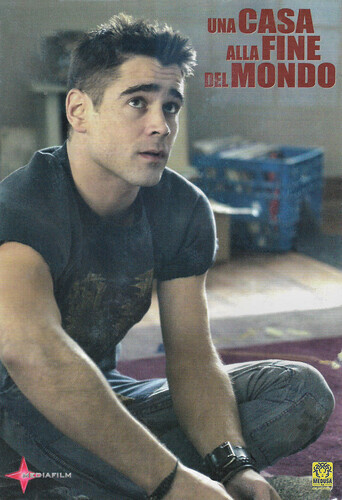
Italian postcard by Media Film, Milano. Photo: Media Film / Medusa. Colin Farrell in A Home at the End of the World (Michael Mayer, 2004).
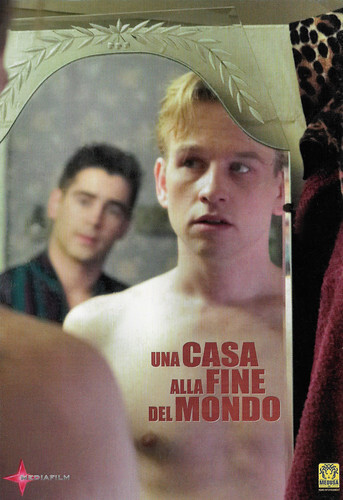
Italian postcard by Media Film, Milano. Photo: Media Film / Medusa. Dallas Roberts and Colin Farrell in A Home at the End of the World (Michael Mayer, 2004).
A journey of trials, triumphs, loves, and losses
A Home at the End of the World (Michael Mayer, 2004) is based on a novel by Michael Cunningham, the Pulitzer Prize-winning author of 'The Hours'. The film chronicles a dozen years in the lives of two best friends who couldn't be more different.
We follow them from suburban Cleveland in the 1960s to New York City in the 1980s. Bobby Morrow's (Colin Farrell) life has been tinged with tragedy since he was a young boy, losing first his beloved older brother to a freak accident, then his mother to illness, and finally his father.
As a rebellious teenager, he meets the conservative and gawky Jonathan Glover (Dallas Roberts) in high school, and he becomes a regular visitor to the Glover home, where he introduces his friend and his mother Alice (Sissy Spacek) to marijuana and the music of Laura Nyro. Jonathan, who is slowly coming out as a homosexual, initiates Bobby into adolescent mutual masturbation during their frequent sleepovers.
When Alice catches them both masturbating in a car, Jonathan, embarrassed, tells Bobby he is going to leave as soon as he finishes high school. Alice teaches Bobby how to bake, unintentionally setting him on a career path that eventually takes him to New York City, where Jonathan is sharing a colorful East Village apartment with bohemian Clare (Robin Wright).
Bobby moves in, and the three create their own household. A Home at the End of the World charts a journey of trials, triumphs, loves, and losses. The question is: can they navigate the unusual triangle they've created and hold their friendship together?
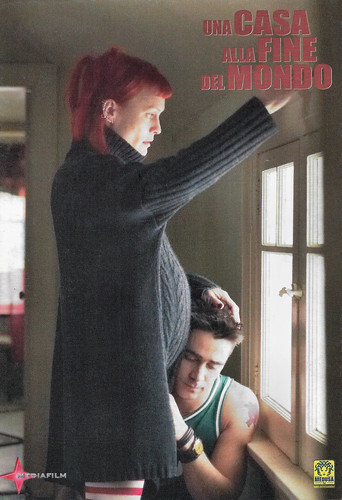
Italian postcard by Media Film, Milano. Photo: Media Film / Medusa. Robin Wright and Colin Farrell in A Home at the End of the World (Michael Mayer, 2004).
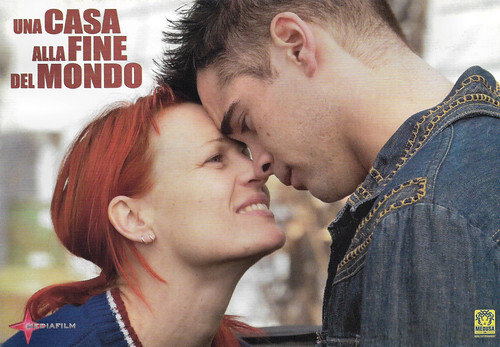
Italian postcard by Media Film, Milano. Photo: Media Film / Medusa. Robin Wright and Colin Farrell in A Home at the End of the World (Michael Mayer, 2004).
Farrell's Bobby is suddenly an asexual puppy dog
Roger Ebert of the Chicago Sun-Times wrote: "The movie exists outside our expectations for such stories. Nothing about it is conventional. The three-member household is puzzling not only to us but to its members. We expect conflict, resolution, an ending happy or sad, but what we get is mostly life, muddling through ... Colin Farrell is astonishing in the movie, not least because the character is such a departure from everything he has done before."
At AllMovie, Derek Armstrong is much more negative: "The title A Home at the End of the World gives off both an optimistic and a pessimistic vibe, simultaneously, which is appropriate for a film that can't figure out what its tone should be. For example, the plot follows the protagonist (Colin Farrell's Bobby) through the deaths of a half-dozen important family members and friends, yet Duncan Sheik's dopey score is better suited to an annoyingly whimsical romantic comedy.
That dopiness is, however, well suited to Farrell's performance. Despite the succession of traumas his character endures, his attitude rarely changes from that of a pseudo-hippie naïf. It's hard to tell whether that's a reflection on director Michael Mayer's vision for the character, or Farrell's limitations as an actor, but it rings terribly false."
Finally, Wes Connors at IMDb : "indeed, it is a portrait of an unconventional family unit, but that should have remained secondary. At heart, this is a love (the kind including a sexual attraction) story between the Bobby and Jonathan characters, possibly deemphasized to make it more palatable. The focus unravels, especially after Mr. Farrell's adult Bobby takes over the action.
The film draws its fault line by losing touch with the central relationship, and Farrell's characterization goes off course. Freed-from-the-wig Colin Farrell and Dallas Roberts could have recorded a hit version of "Look Out, Cleveland" with The Band backing... The casting is excellent, with Erik Smith and Harris Allan especially winning as the teenage Bobby and Jonathan; they blend perfectly with the grown-up Farrell and Mr. Roberts.
Note that criticisms of Farrell in the lead role are of characterization, not acting. Smith's Bobby was played as a self-assured and sexually adventurous young man, but Farrell's Bobby is suddenly an asexual puppy dog; something is missing."
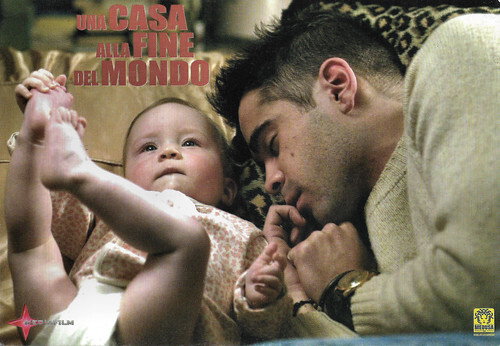
Italian postcard by Media Film, Milano. Photo: Media Film / Medusa. Colin Farrell in A Home at the End of the World (Michael Mayer, 2004).
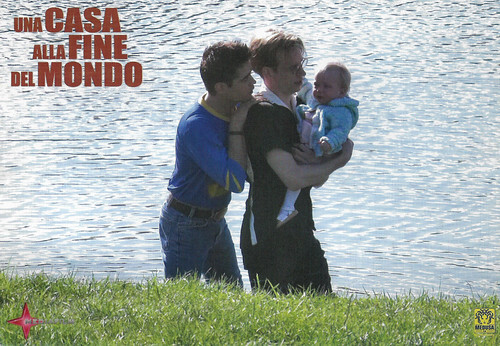
Italian postcard by Media Film, Milano. Photo: Media Film / Medusa. Colin Farrell and Dallas Roberts in A Home at the End of the World (Michael Mayer, 2004).
Sources: Roger Ebert (Roger Ebert.com), Derek Armstrong (AllMovie), Wes Connors (IMDb), Wikipedia, and IMDb.

Italian postcard by Media Film, Milano. Photo: Media Film / Medusa. Colin Farrell in A Home at the End of the World (Michael Mayer, 2004).

Italian postcard by Media Film, Milano. Photo: Media Film / Medusa. Dallas Roberts and Colin Farrell in A Home at the End of the World (Michael Mayer, 2004).
A journey of trials, triumphs, loves, and losses
A Home at the End of the World (Michael Mayer, 2004) is based on a novel by Michael Cunningham, the Pulitzer Prize-winning author of 'The Hours'. The film chronicles a dozen years in the lives of two best friends who couldn't be more different.
We follow them from suburban Cleveland in the 1960s to New York City in the 1980s. Bobby Morrow's (Colin Farrell) life has been tinged with tragedy since he was a young boy, losing first his beloved older brother to a freak accident, then his mother to illness, and finally his father.
As a rebellious teenager, he meets the conservative and gawky Jonathan Glover (Dallas Roberts) in high school, and he becomes a regular visitor to the Glover home, where he introduces his friend and his mother Alice (Sissy Spacek) to marijuana and the music of Laura Nyro. Jonathan, who is slowly coming out as a homosexual, initiates Bobby into adolescent mutual masturbation during their frequent sleepovers.
When Alice catches them both masturbating in a car, Jonathan, embarrassed, tells Bobby he is going to leave as soon as he finishes high school. Alice teaches Bobby how to bake, unintentionally setting him on a career path that eventually takes him to New York City, where Jonathan is sharing a colorful East Village apartment with bohemian Clare (Robin Wright).
Bobby moves in, and the three create their own household. A Home at the End of the World charts a journey of trials, triumphs, loves, and losses. The question is: can they navigate the unusual triangle they've created and hold their friendship together?

Italian postcard by Media Film, Milano. Photo: Media Film / Medusa. Robin Wright and Colin Farrell in A Home at the End of the World (Michael Mayer, 2004).

Italian postcard by Media Film, Milano. Photo: Media Film / Medusa. Robin Wright and Colin Farrell in A Home at the End of the World (Michael Mayer, 2004).
Farrell's Bobby is suddenly an asexual puppy dog
Roger Ebert of the Chicago Sun-Times wrote: "The movie exists outside our expectations for such stories. Nothing about it is conventional. The three-member household is puzzling not only to us but to its members. We expect conflict, resolution, an ending happy or sad, but what we get is mostly life, muddling through ... Colin Farrell is astonishing in the movie, not least because the character is such a departure from everything he has done before."
At AllMovie, Derek Armstrong is much more negative: "The title A Home at the End of the World gives off both an optimistic and a pessimistic vibe, simultaneously, which is appropriate for a film that can't figure out what its tone should be. For example, the plot follows the protagonist (Colin Farrell's Bobby) through the deaths of a half-dozen important family members and friends, yet Duncan Sheik's dopey score is better suited to an annoyingly whimsical romantic comedy.
That dopiness is, however, well suited to Farrell's performance. Despite the succession of traumas his character endures, his attitude rarely changes from that of a pseudo-hippie naïf. It's hard to tell whether that's a reflection on director Michael Mayer's vision for the character, or Farrell's limitations as an actor, but it rings terribly false."
Finally, Wes Connors at IMDb : "indeed, it is a portrait of an unconventional family unit, but that should have remained secondary. At heart, this is a love (the kind including a sexual attraction) story between the Bobby and Jonathan characters, possibly deemphasized to make it more palatable. The focus unravels, especially after Mr. Farrell's adult Bobby takes over the action.
The film draws its fault line by losing touch with the central relationship, and Farrell's characterization goes off course. Freed-from-the-wig Colin Farrell and Dallas Roberts could have recorded a hit version of "Look Out, Cleveland" with The Band backing... The casting is excellent, with Erik Smith and Harris Allan especially winning as the teenage Bobby and Jonathan; they blend perfectly with the grown-up Farrell and Mr. Roberts.
Note that criticisms of Farrell in the lead role are of characterization, not acting. Smith's Bobby was played as a self-assured and sexually adventurous young man, but Farrell's Bobby is suddenly an asexual puppy dog; something is missing."

Italian postcard by Media Film, Milano. Photo: Media Film / Medusa. Colin Farrell in A Home at the End of the World (Michael Mayer, 2004).

Italian postcard by Media Film, Milano. Photo: Media Film / Medusa. Colin Farrell and Dallas Roberts in A Home at the End of the World (Michael Mayer, 2004).
Sources: Roger Ebert (Roger Ebert.com), Derek Armstrong (AllMovie), Wes Connors (IMDb), Wikipedia, and IMDb.
Published on May 17, 2022 22:00
May 16, 2022
Cannes Film Festival
Every year, in the third week of May, international filmmakers, stars, film industry professionals and thousands of journalists go to the Côte d'Azur. They visit the most prestigious film festival in the world, the Cannes Film Festival (Festival de Cannes). The festival starts today.
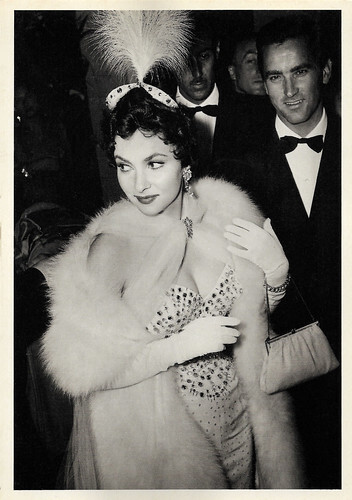
French postcard by Editions Admira in the Collection 'Portraits de cinema" (1st series), no. 12, 1987. Photo: Léo Mirkine. Caption: Gina Lollobrigida , Cannes (1959).
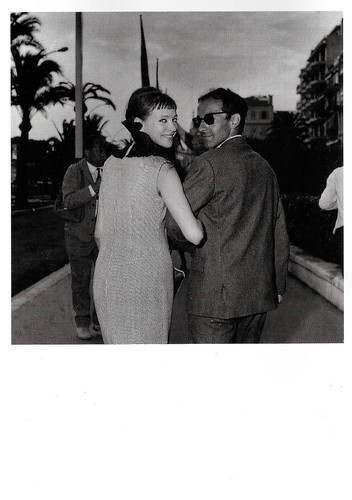
French postcard by Editions Cahiers du Cinéma, Paris, 1997. Photo: Traverso. Caption: Anna Karina and Jean-Luc Godard , Festival de Cannes 1963.
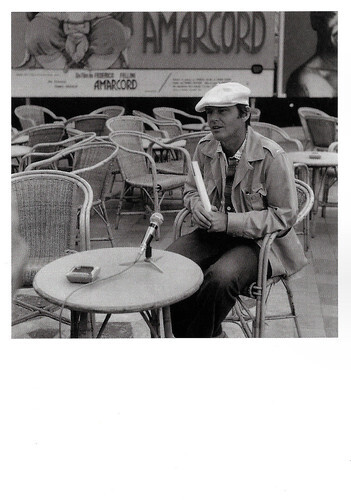
French postcard by Editions Cahiers de cinéma, Paris, 1997. Caption: Jack Nicholson , Festival de Cannes 1974.
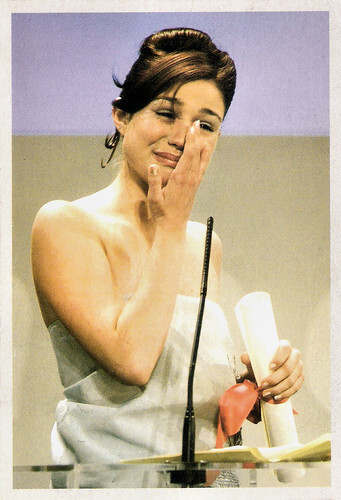
Belgian postcard by Ed. resp. P. Hurbain, Bruxelles, no. 148. Photo: Laurent Rebours / AP. Caption: Cannes 1999: Rosetta, the film by the Dardenne brothers, receives the Grand Prix, and Émilie Dequenne wins the award for Best Actress.
The Golden Palm
The Cannes Film Festival has been held every year in the French city of Cannes since 1946. The venue is the Palais des Festivals et des Congrès on the La Croisette promenade.
The most important prize awarded at Cannes is the Palme d'Or (Golden Palm) for the best film in the International Competition. The Golden Palm is sometimes shared by several films in the same year.
Other prizes awarded by the jury for the film as a whole are (in descending order) the Grand Prize of the Jury (Grand Prix du Jury), the Prize of the Jury (Prix du Jury) and the Special Prize of the Jury (not necessarily awarded every year). There are also prizes in the individual categories of female actor, male actor, director and screenplay.
The awards in Cannes are given by a jury made up of several people, usually experienced and award-winning professionals from the film industry. Other juries also award competition films here. The most important are the FIPRESCI Prize of International Film Critics (Prix de la FIPRESCI) and the Ecumenical Jury Prize (Prix du Jury oecuménique).
In addition to the main competition, there is also the short film competition with the Palme d'Or for short films (Palme d'Or du court métrage), the Cinéfondation competition, in which works by film students are awarded, as well as the Un Certain Regard series, in which the Prix Un Certain Regard has been awarded since 1998.
Within the framework of the international film festival, both the directors' association Société des Réalisateurs de Films with its La Quinzaine des Réalisateurs and the critics' organisation Syndicat français de la critique de cinéma with its La Semaine Internationale de la Critique hold their own independent parallel event at which a number of prizes are also awarded.
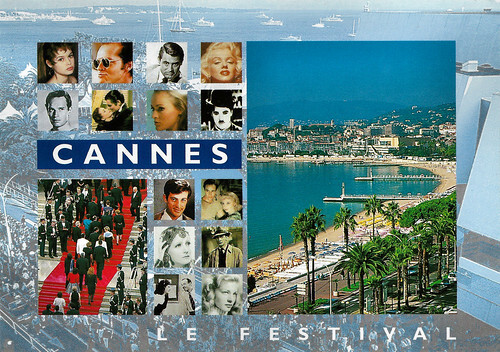
French postcard by Images - Distribution. Image: Photos D.R.
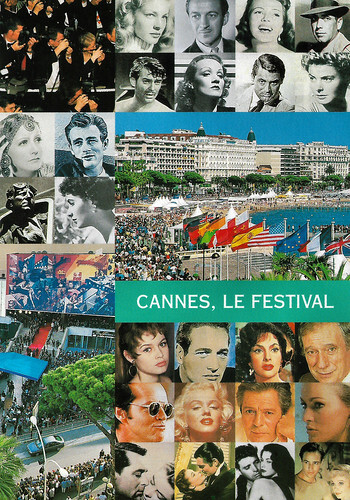
French postcard by Images - Distribution. Image: Photos D.R. Caption: Cannes (Alpes-Maritimes) Le Festival.
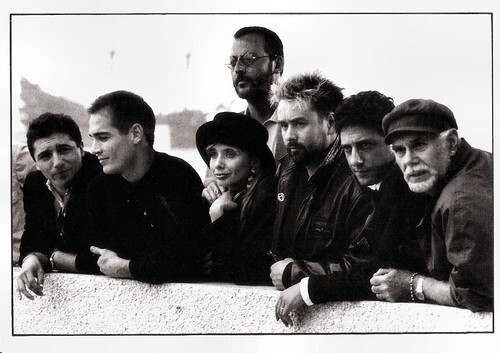
French postcard by News Productions, Beaulmes, no 56063. Photo: Eric Coiffier. Director and cast of Le Grand Bleu (Luc Besson, 1988) at the Festival de Cannes, 1988. With in the front row from left to right: Marc Duret, Jean-Marc Barr , Rosanna Arquette, Luc Besson, Sergio Castellitto and Andréas Voutsinas.
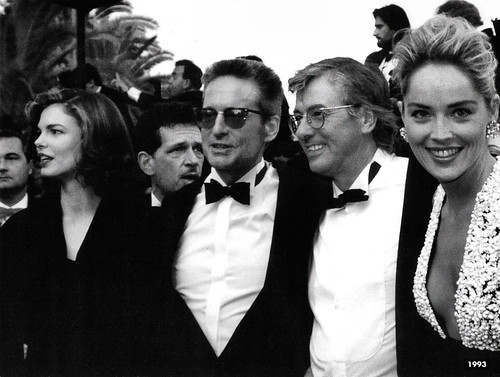
Big photo, 1993. Jeanne Tripplehorn, Michael Douglas , Paul Verhoeven , Sharon Stone at the Premiere of Basic Instinct (Paul Verhoeven, 1992) in Cannes.
24 Stairs to glory
The Cannes Film Festival receives a lot of media attention, it is attended by many film stars and is a popular opportunity for film producers to present their new films and sell them to distributors. The film stars are transported in luxurious limousines to the famous red carpet, where they climb the "24 stairs to glory" and to be hidden from public view.
From the 1950s onwards, Cannes became the biggest event in world cinema. Gradually, as the critic André Bazin wished, the festival became more concerned with cinema and less with mundanities, patriotism and diplomacy. Until the 1970s, embassies presented the films chosen by their governments.
Major filmmakers presented major works at the festival: Roberto Rossellini, Federico Fellini, Ingmar Bergman , Elia Kazan, Joseph L. Mankiewicz, Robert Wise, William Wyler, Michelangelo Antonioni, Vittorio De Sica , Andrzej Wajda, Satyajit Ray, Luis Buñuel, Akira Kurosawa, Martin Scorsese, Paul Verhoeven and Quentin Tarantino .
In 1997, on the occasion of the 50th Cannes Film Festival, Ingmar Bergman was awarded the "Palm of Palms" in the presence of many previous winners. In 2012 the president of the Festival at the time, Gilles Jacob, expressed regret about the monumentality of the event, which had lost its humanity compared to the time when Kirk Douglas played football with journalists and the stars walked to the beach:
"The Festival should stop growing, so as not to become an embarrassment. Cannes is the most beautiful city for a film festival, but it must remain a pleasure, not a constraint. [...] There are more and more people and media who want to come, we can't forbid them. [...] When the stars come down to the bottom of the steps, some talk to people, others don't. Many give nothing but the usual, devote themselves to their work. Many just give the agreed-upon, spend a short day with the press, and leave. It's almost like a factory."
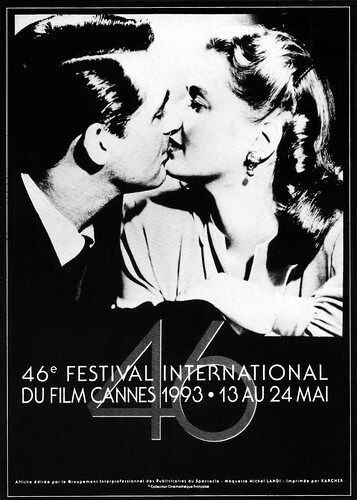
French postcard by Mondial Projection S.A., Paris. Image: poster for 46e Festival International Du Film Cannes 1993. Design: Michel Landi. Photo: Collection Cinémathèque Française. Ingrid Bergman and Cary Grant in Notorious (Alfred Hitchcock, 1946).
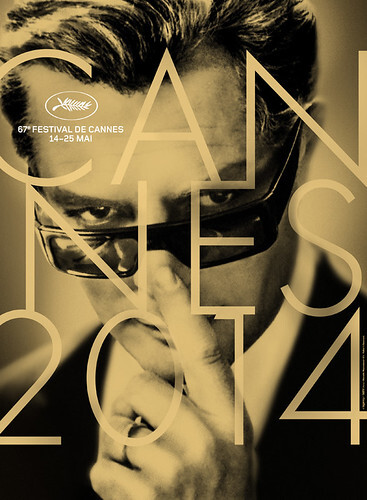
French postcard. Caption: Cannes 2014. 67e Festival de Cannes 14-25 Mai. Photo: Marcello Mastroianni in La dolce vita (Federico Fellini, 1960).
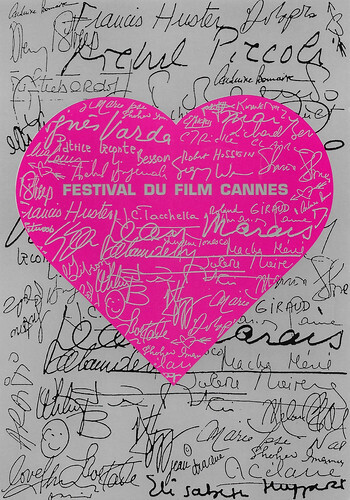
French postcard by Davis. Design: Sylvie Cruguet. Caption: Festival du Film - Cannes 2004.
Cancelled in 1968
The Cannes Film Festival was conceived on the initiative of the French Minister of Education and Culture, Jean Zay. Originally planned for 1939, the first Cannes International Film Festival took place for the first time from 20 September to 5 October 1946 due to the Second World War.
In 1948 and 1950, the festival was cancelled due to financing difficulties. In 1955, the best film was awarded the Palme d'Or for the first time. The trophy, designed by French jeweller Lucienne Lazon, replaced the "Grand Prix" which had been awarded until then.
As a result of the Paris May riots, the 1968 festival was cancelled on 19 May. Louis Malle had already resigned as a member of the jury the evening before. Malle, François Truffaut , Claude Berri, Jean-Gabriel Albicocco, Claude Lelouch, Roman Polański and Jean-Luc Godard invaded the Great Hall of the Palais des Festivals and demanded the interruption of the screening as a show of solidarity with the striking workers and students.
The action was also seen as a response to the dismissal of Henri Langlois as director of the Cinémathèque française shortly before. In 2014, Gilles Jacob became honorary president after 38 years of directing the Festival, his successor is Pierre Lescure.
The Film Market facilitates exchanges between buyers and sellers in the film industry and has become the world's leading platform for the international film trade. In 2007, it hosted over 10,000 participants from 91 countries.
In 2017, the festival celebrated its 70th edition, inviting award-winning filmmakers and screenings of series by great filmmakers. Today, the official selection is intended to reflect the world's film production. The competition generally highlights auteur or research films. The question of creating an award for original music has been raised.
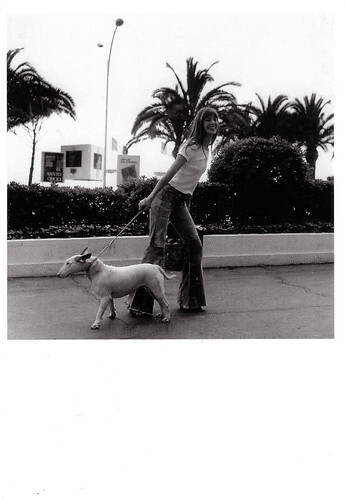
French postcard by Editions Cahiers de cinéma, Paris, 1997. Photo: Traverso. Caption: Jane Birkin , Festival de Cannes 1974.
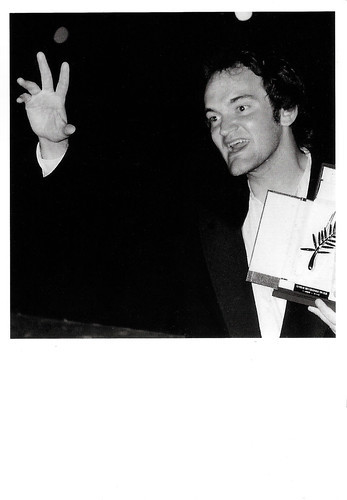
French postcard by Editions Cahiers du Cinéma, Paris, 1997. Photo: Traverso. Quentin Tarantino , Festival de Cannes 1994.
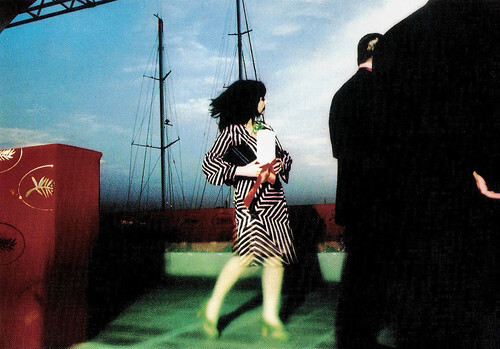
French postcard by Cartcom. Photo: Sandrine Expily / Studio Magazine. Caption: Björk, Prix d'interprétation pour Dancer in the Dark. Cannes 2000. The photo was part of theexhibition 'Un Regard sur Cannes', presented at the UGC Ciné Cité Strasbourg-Étoile.
Sources: Wikipedia (French, Dutch and German) and Festival de Cannes.

French postcard by Editions Admira in the Collection 'Portraits de cinema" (1st series), no. 12, 1987. Photo: Léo Mirkine. Caption: Gina Lollobrigida , Cannes (1959).

French postcard by Editions Cahiers du Cinéma, Paris, 1997. Photo: Traverso. Caption: Anna Karina and Jean-Luc Godard , Festival de Cannes 1963.

French postcard by Editions Cahiers de cinéma, Paris, 1997. Caption: Jack Nicholson , Festival de Cannes 1974.

Belgian postcard by Ed. resp. P. Hurbain, Bruxelles, no. 148. Photo: Laurent Rebours / AP. Caption: Cannes 1999: Rosetta, the film by the Dardenne brothers, receives the Grand Prix, and Émilie Dequenne wins the award for Best Actress.
The Golden Palm
The Cannes Film Festival has been held every year in the French city of Cannes since 1946. The venue is the Palais des Festivals et des Congrès on the La Croisette promenade.
The most important prize awarded at Cannes is the Palme d'Or (Golden Palm) for the best film in the International Competition. The Golden Palm is sometimes shared by several films in the same year.
Other prizes awarded by the jury for the film as a whole are (in descending order) the Grand Prize of the Jury (Grand Prix du Jury), the Prize of the Jury (Prix du Jury) and the Special Prize of the Jury (not necessarily awarded every year). There are also prizes in the individual categories of female actor, male actor, director and screenplay.
The awards in Cannes are given by a jury made up of several people, usually experienced and award-winning professionals from the film industry. Other juries also award competition films here. The most important are the FIPRESCI Prize of International Film Critics (Prix de la FIPRESCI) and the Ecumenical Jury Prize (Prix du Jury oecuménique).
In addition to the main competition, there is also the short film competition with the Palme d'Or for short films (Palme d'Or du court métrage), the Cinéfondation competition, in which works by film students are awarded, as well as the Un Certain Regard series, in which the Prix Un Certain Regard has been awarded since 1998.
Within the framework of the international film festival, both the directors' association Société des Réalisateurs de Films with its La Quinzaine des Réalisateurs and the critics' organisation Syndicat français de la critique de cinéma with its La Semaine Internationale de la Critique hold their own independent parallel event at which a number of prizes are also awarded.

French postcard by Images - Distribution. Image: Photos D.R.

French postcard by Images - Distribution. Image: Photos D.R. Caption: Cannes (Alpes-Maritimes) Le Festival.

French postcard by News Productions, Beaulmes, no 56063. Photo: Eric Coiffier. Director and cast of Le Grand Bleu (Luc Besson, 1988) at the Festival de Cannes, 1988. With in the front row from left to right: Marc Duret, Jean-Marc Barr , Rosanna Arquette, Luc Besson, Sergio Castellitto and Andréas Voutsinas.

Big photo, 1993. Jeanne Tripplehorn, Michael Douglas , Paul Verhoeven , Sharon Stone at the Premiere of Basic Instinct (Paul Verhoeven, 1992) in Cannes.
24 Stairs to glory
The Cannes Film Festival receives a lot of media attention, it is attended by many film stars and is a popular opportunity for film producers to present their new films and sell them to distributors. The film stars are transported in luxurious limousines to the famous red carpet, where they climb the "24 stairs to glory" and to be hidden from public view.
From the 1950s onwards, Cannes became the biggest event in world cinema. Gradually, as the critic André Bazin wished, the festival became more concerned with cinema and less with mundanities, patriotism and diplomacy. Until the 1970s, embassies presented the films chosen by their governments.
Major filmmakers presented major works at the festival: Roberto Rossellini, Federico Fellini, Ingmar Bergman , Elia Kazan, Joseph L. Mankiewicz, Robert Wise, William Wyler, Michelangelo Antonioni, Vittorio De Sica , Andrzej Wajda, Satyajit Ray, Luis Buñuel, Akira Kurosawa, Martin Scorsese, Paul Verhoeven and Quentin Tarantino .
In 1997, on the occasion of the 50th Cannes Film Festival, Ingmar Bergman was awarded the "Palm of Palms" in the presence of many previous winners. In 2012 the president of the Festival at the time, Gilles Jacob, expressed regret about the monumentality of the event, which had lost its humanity compared to the time when Kirk Douglas played football with journalists and the stars walked to the beach:
"The Festival should stop growing, so as not to become an embarrassment. Cannes is the most beautiful city for a film festival, but it must remain a pleasure, not a constraint. [...] There are more and more people and media who want to come, we can't forbid them. [...] When the stars come down to the bottom of the steps, some talk to people, others don't. Many give nothing but the usual, devote themselves to their work. Many just give the agreed-upon, spend a short day with the press, and leave. It's almost like a factory."

French postcard by Mondial Projection S.A., Paris. Image: poster for 46e Festival International Du Film Cannes 1993. Design: Michel Landi. Photo: Collection Cinémathèque Française. Ingrid Bergman and Cary Grant in Notorious (Alfred Hitchcock, 1946).

French postcard. Caption: Cannes 2014. 67e Festival de Cannes 14-25 Mai. Photo: Marcello Mastroianni in La dolce vita (Federico Fellini, 1960).

French postcard by Davis. Design: Sylvie Cruguet. Caption: Festival du Film - Cannes 2004.
Cancelled in 1968
The Cannes Film Festival was conceived on the initiative of the French Minister of Education and Culture, Jean Zay. Originally planned for 1939, the first Cannes International Film Festival took place for the first time from 20 September to 5 October 1946 due to the Second World War.
In 1948 and 1950, the festival was cancelled due to financing difficulties. In 1955, the best film was awarded the Palme d'Or for the first time. The trophy, designed by French jeweller Lucienne Lazon, replaced the "Grand Prix" which had been awarded until then.
As a result of the Paris May riots, the 1968 festival was cancelled on 19 May. Louis Malle had already resigned as a member of the jury the evening before. Malle, François Truffaut , Claude Berri, Jean-Gabriel Albicocco, Claude Lelouch, Roman Polański and Jean-Luc Godard invaded the Great Hall of the Palais des Festivals and demanded the interruption of the screening as a show of solidarity with the striking workers and students.
The action was also seen as a response to the dismissal of Henri Langlois as director of the Cinémathèque française shortly before. In 2014, Gilles Jacob became honorary president after 38 years of directing the Festival, his successor is Pierre Lescure.
The Film Market facilitates exchanges between buyers and sellers in the film industry and has become the world's leading platform for the international film trade. In 2007, it hosted over 10,000 participants from 91 countries.
In 2017, the festival celebrated its 70th edition, inviting award-winning filmmakers and screenings of series by great filmmakers. Today, the official selection is intended to reflect the world's film production. The competition generally highlights auteur or research films. The question of creating an award for original music has been raised.

French postcard by Editions Cahiers de cinéma, Paris, 1997. Photo: Traverso. Caption: Jane Birkin , Festival de Cannes 1974.

French postcard by Editions Cahiers du Cinéma, Paris, 1997. Photo: Traverso. Quentin Tarantino , Festival de Cannes 1994.

French postcard by Cartcom. Photo: Sandrine Expily / Studio Magazine. Caption: Björk, Prix d'interprétation pour Dancer in the Dark. Cannes 2000. The photo was part of theexhibition 'Un Regard sur Cannes', presented at the UGC Ciné Cité Strasbourg-Étoile.
Sources: Wikipedia (French, Dutch and German) and Festival de Cannes.
Published on May 16, 2022 22:00
May 15, 2022
Hannelore Schroth
German actress Hannelore Schroth (1922-1987) made her film debut at the age of nine and a long and successful career in both theatre and cinema followed. She starred in Helmut Käutner's Unter den Brücken/Under the bridges (1945), one of the most beautiful love stories of the German cinema – without any trace of propaganda.
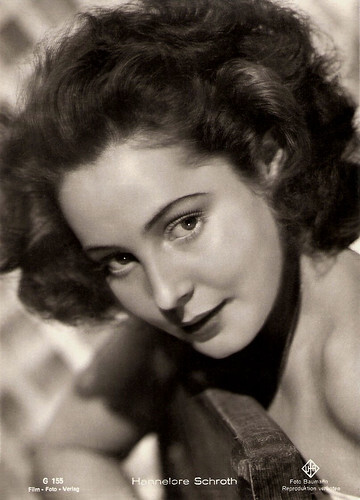
German postcard by Film-Foto-Verlag, no. G 155, 1941-1944. Photo: Baumann / Ufa.
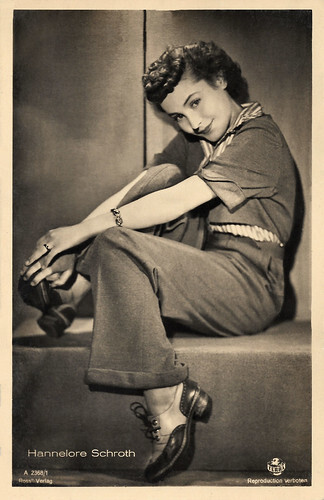
German postcard by Ross Verlag, no. A 2368/1, 1939-1940. Photo: Terra.
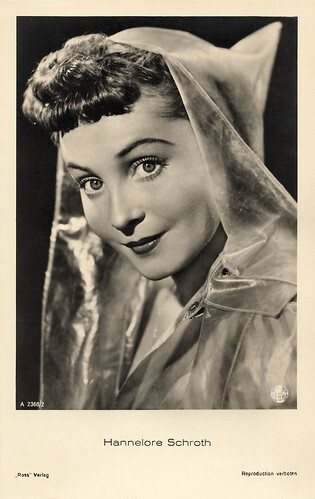
German postcard by Ross Verlag, no. A 2368/2, 1939-1940. Photo: Terra.
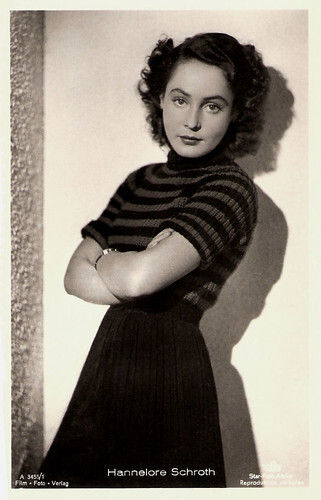
German postcard by Film-Foto-Verlag, no. A 3455/1, 1941-1944. Photo: Star-Foto-Atelier / Tobis.
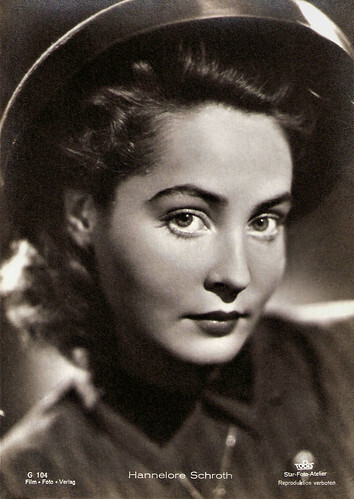
German postcard by Film-Foto-Verlag, no. G 104, 1941-1944. Photo: Star-Foto-Atelier / Tobis.
Wonderfully natural
Hanne Lore Emilie Käte Grete Schroth was born in Berlin in 1922 as the daughter of actor Heinrich Schroth and actress Käthe Haack . Her half-brother Carl-Heinz Schroth would also become a well-known actor.
Hannelore already made her film debut at the age of nine in the short comedy Dann schon lieber Lebertran/I'd Rather Have Cod Liver Oil (Max Ophüls, 1931) opposite her mother, Käthe Haack . At sixteen, she attended a drama school in Lausanne.
To her early successes belong the love story Spiel im Sommerwind/Play in the Summer Breezes (Roger von Norman, 1938) with Rolf Möbius, and Kitty und die Weltkonferenz/Kitty and the World Conference (Helmut Käutner, 1939).
During the wartime, she continued her career with leading parts in Friedrich Schiller (Herbert Maisch, 1940) about the 18th-century German playwright and blank-verse poet, the romantic comedy Sophienlund (Heinz Rühmann, 1944) and Unter den Brücken/Under the Bridge (Helmut Käutner, 1945), a classic love triangle with Carl Raddatz and Gustav Knuth.
IMDb reviewer Christian Wasser calls the latter "one of the most beautiful love stories of the German cinema. The acting of Hannelore Schroth is wonderfully natural even today".
Unter den Brücken was one of the last films to be made in Nazi Germany - it passed the censorship in March 1945, but didn't make it to the cinemas as the street battles were about to commence in Berlin in a few weeks. In 1950, the film was finally shown in cinemas.
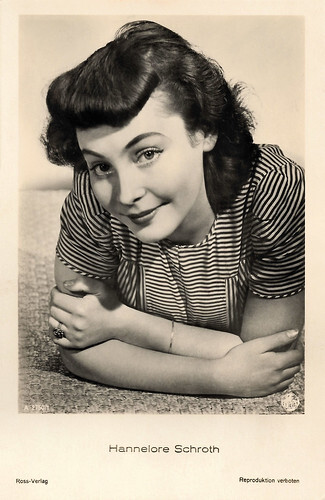
German postcard by Ross Verlag, no. A 2750/1, 1939-1940. Photo: Terra.
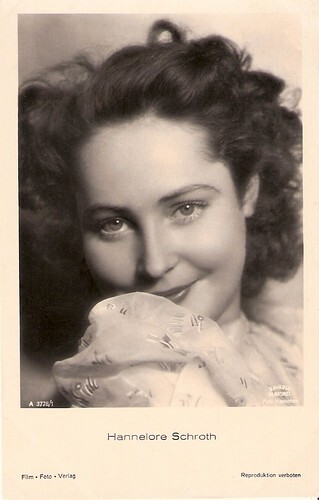
German postcard by Film-Foto-Verlag, no. A 3776/1, 1941-1944. Photo: Foto Haenchen / Bavaria Filmkunst.
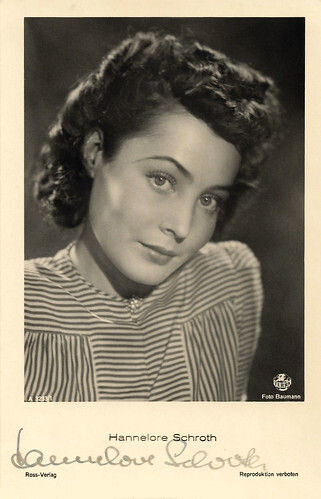
German postcard by Ross Verlag, no. A 3233/1, 1941-1944. Photo: Baumann / Terra.
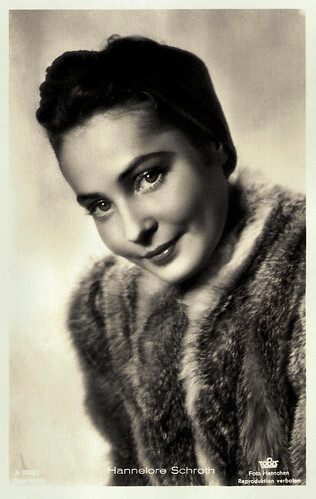
German postcard by Ross Verlag, no. A 3233/2, 1941-1944. Photo: Haenchen / Tobis.
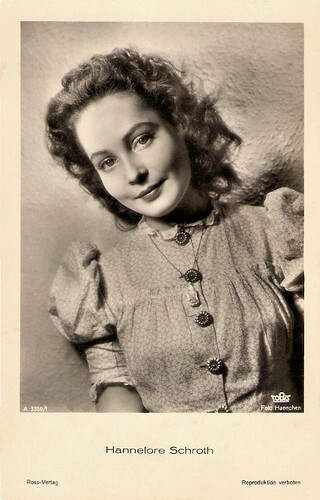
German postcard by Ross Verlag, no. A 3359/1, 1941-1944. Photo: Haenchen / Tobis.
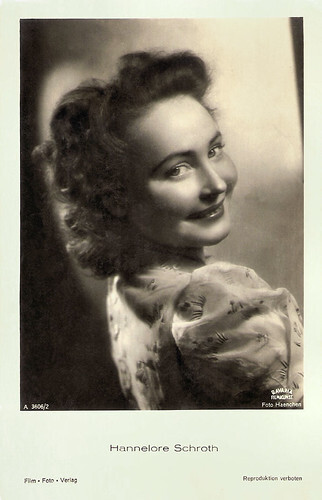
German postcard by Film-Foto-Verlag, no. A 3606/2, 1941-1944. Photo: Haenchen / Bavaria Filmkunst.
Emiiiil
After the war, Hannelore Schroth gained a foothold at the theater and also continued her film career with such hits as Taxi-Kitty (Kurt Hoffmann, 1950) and Kommen Sie am Ersten/Come at the First (Erich Engel, 1951).
Later well-known films are the classic comedy Der Hauptmann von Köpenick/The Captain from Köpenick (Helmut Käutner, 1956), the romantic drama Wie einst Lili Marleen/Like Once Lili Marleen (Paul Verhoeven, 1956) with the wartime song hit Lili Marlene woven into its plotline, and the comedy Der Mann, der nicht nein sagen konnte/The Man Who Could Not say No (Kurt Früh, 1958) with Heinz Rühmann .
She also became a popular voice actor and dubbed such Hollywood stars as Shirley MacLaine and Elizabeth Taylor .
From the 1950s on, regular engagements for TV followed. She became well-known for a younger audience when she impersonated the role of Mrs. Petrell in the successful Swedish film- and TV series Emil (Olle Hellbom, 1971-1976). The three feature films and the TV series were based on the novels by Astrid Lindgren about the 5-year-old prankster Emil, who lives with his family on a farm in the district of Lönneberga in Sweden, at the start of the 20th century.
To Hannelore Schroth's last films belong the comedy Bomber & Paganini (Nicos Perakis, 1976) starring Mario Adorf , and Zwischengleis/Yesterday's Tomorrow (Wolfgang Staudte, 1978) with Pola Kinski. In 1980, Schroth was awarded the Filmband in Gold for her achievements in German cinema.
Hannelore Schroth died in 1987 in München (Munich). She had been married to the actor Carl Raddatz , her co-star of Unter den Brücken, and from 1945 till 1950 with the Austrian deep-sea diver Hans Hass. Her son from that marriage, Hans Hass Jr., was an actor and singer. From her third marriage with a lawyer and film producer also comes a son, Christopher Köster.
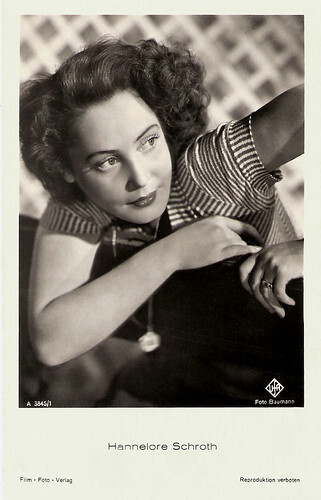
German postcard by Film-Foto-Verlag, no. A 3845/1, 1941-1944. Photo: Baumann / Ufa.
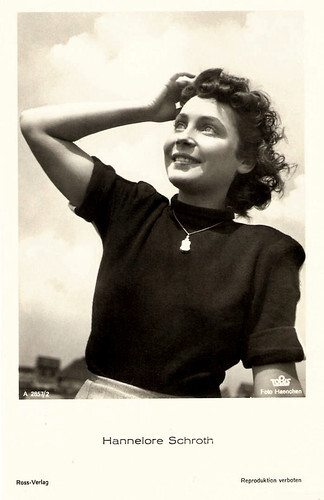
German postcard by Ross Verlag, no. A 2857/1, 1939-1940. Photo: Haenchen / Tobis.
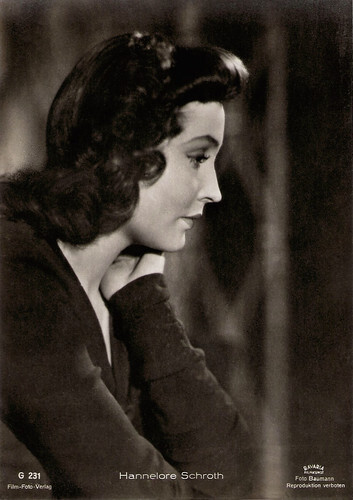
German postcard by Film-Foto-Verlag, no. G 231, 1941-1944. Photo: Baumann / Bavaria.
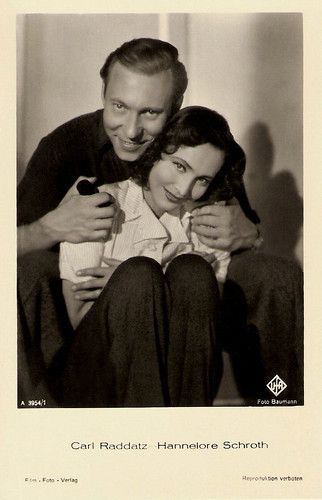
With Carl Raddatz . German postcard by Film-Foto-Verlag, no. A 3954/1, 1941-1944. Photo: Baumann / Ufa.
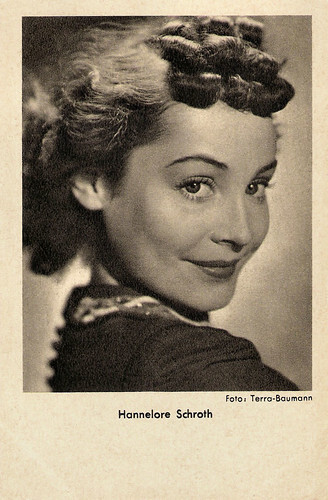
German postcard. Photo: Baumann / Terra.
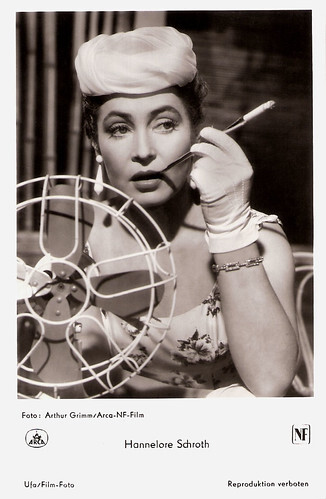
German postcard by Ufa, Berlin-Tempelhof, no. FK 3492. Retail price: 25 Pfg. Photo: Arthur Grimm / Arca-NF-Film.
Sources: Thomas Staedeli (Cyranos), Filmportal.de, Wikipedia (German), and .

German postcard by Film-Foto-Verlag, no. G 155, 1941-1944. Photo: Baumann / Ufa.

German postcard by Ross Verlag, no. A 2368/1, 1939-1940. Photo: Terra.

German postcard by Ross Verlag, no. A 2368/2, 1939-1940. Photo: Terra.

German postcard by Film-Foto-Verlag, no. A 3455/1, 1941-1944. Photo: Star-Foto-Atelier / Tobis.

German postcard by Film-Foto-Verlag, no. G 104, 1941-1944. Photo: Star-Foto-Atelier / Tobis.
Wonderfully natural
Hanne Lore Emilie Käte Grete Schroth was born in Berlin in 1922 as the daughter of actor Heinrich Schroth and actress Käthe Haack . Her half-brother Carl-Heinz Schroth would also become a well-known actor.
Hannelore already made her film debut at the age of nine in the short comedy Dann schon lieber Lebertran/I'd Rather Have Cod Liver Oil (Max Ophüls, 1931) opposite her mother, Käthe Haack . At sixteen, she attended a drama school in Lausanne.
To her early successes belong the love story Spiel im Sommerwind/Play in the Summer Breezes (Roger von Norman, 1938) with Rolf Möbius, and Kitty und die Weltkonferenz/Kitty and the World Conference (Helmut Käutner, 1939).
During the wartime, she continued her career with leading parts in Friedrich Schiller (Herbert Maisch, 1940) about the 18th-century German playwright and blank-verse poet, the romantic comedy Sophienlund (Heinz Rühmann, 1944) and Unter den Brücken/Under the Bridge (Helmut Käutner, 1945), a classic love triangle with Carl Raddatz and Gustav Knuth.
IMDb reviewer Christian Wasser calls the latter "one of the most beautiful love stories of the German cinema. The acting of Hannelore Schroth is wonderfully natural even today".
Unter den Brücken was one of the last films to be made in Nazi Germany - it passed the censorship in March 1945, but didn't make it to the cinemas as the street battles were about to commence in Berlin in a few weeks. In 1950, the film was finally shown in cinemas.

German postcard by Ross Verlag, no. A 2750/1, 1939-1940. Photo: Terra.

German postcard by Film-Foto-Verlag, no. A 3776/1, 1941-1944. Photo: Foto Haenchen / Bavaria Filmkunst.

German postcard by Ross Verlag, no. A 3233/1, 1941-1944. Photo: Baumann / Terra.

German postcard by Ross Verlag, no. A 3233/2, 1941-1944. Photo: Haenchen / Tobis.

German postcard by Ross Verlag, no. A 3359/1, 1941-1944. Photo: Haenchen / Tobis.

German postcard by Film-Foto-Verlag, no. A 3606/2, 1941-1944. Photo: Haenchen / Bavaria Filmkunst.
Emiiiil
After the war, Hannelore Schroth gained a foothold at the theater and also continued her film career with such hits as Taxi-Kitty (Kurt Hoffmann, 1950) and Kommen Sie am Ersten/Come at the First (Erich Engel, 1951).
Later well-known films are the classic comedy Der Hauptmann von Köpenick/The Captain from Köpenick (Helmut Käutner, 1956), the romantic drama Wie einst Lili Marleen/Like Once Lili Marleen (Paul Verhoeven, 1956) with the wartime song hit Lili Marlene woven into its plotline, and the comedy Der Mann, der nicht nein sagen konnte/The Man Who Could Not say No (Kurt Früh, 1958) with Heinz Rühmann .
She also became a popular voice actor and dubbed such Hollywood stars as Shirley MacLaine and Elizabeth Taylor .
From the 1950s on, regular engagements for TV followed. She became well-known for a younger audience when she impersonated the role of Mrs. Petrell in the successful Swedish film- and TV series Emil (Olle Hellbom, 1971-1976). The three feature films and the TV series were based on the novels by Astrid Lindgren about the 5-year-old prankster Emil, who lives with his family on a farm in the district of Lönneberga in Sweden, at the start of the 20th century.
To Hannelore Schroth's last films belong the comedy Bomber & Paganini (Nicos Perakis, 1976) starring Mario Adorf , and Zwischengleis/Yesterday's Tomorrow (Wolfgang Staudte, 1978) with Pola Kinski. In 1980, Schroth was awarded the Filmband in Gold for her achievements in German cinema.
Hannelore Schroth died in 1987 in München (Munich). She had been married to the actor Carl Raddatz , her co-star of Unter den Brücken, and from 1945 till 1950 with the Austrian deep-sea diver Hans Hass. Her son from that marriage, Hans Hass Jr., was an actor and singer. From her third marriage with a lawyer and film producer also comes a son, Christopher Köster.

German postcard by Film-Foto-Verlag, no. A 3845/1, 1941-1944. Photo: Baumann / Ufa.

German postcard by Ross Verlag, no. A 2857/1, 1939-1940. Photo: Haenchen / Tobis.

German postcard by Film-Foto-Verlag, no. G 231, 1941-1944. Photo: Baumann / Bavaria.

With Carl Raddatz . German postcard by Film-Foto-Verlag, no. A 3954/1, 1941-1944. Photo: Baumann / Ufa.

German postcard. Photo: Baumann / Terra.

German postcard by Ufa, Berlin-Tempelhof, no. FK 3492. Retail price: 25 Pfg. Photo: Arthur Grimm / Arca-NF-Film.
Sources: Thomas Staedeli (Cyranos), Filmportal.de, Wikipedia (German), and .
Published on May 15, 2022 22:00
May 14, 2022
Published by Weenenk & Snel
Weenenk & Snel in the city of Baarn was one of the Dutch publishers that created many film star postcards, first mainly of Dutch actors in sepia and later of film stars in black and white. In 1900, Wilhelm Reinier Weenenk opened a shop in Dern Haag (The Hague) selling postcards and cityscapes. In 1905 he associated with Nicolaas François Snel and the publishing company of Mr. Weenenk continued as Weenenk & Snel. In 1935 the head offices moved to Baarn. In an advertisement in the trade journal De Band in 1957, a completely new collection was promoted with new art cards, holiday and bathing cards, windmills, flower bulb fields, summer landscapes, and, of course, film cards.

Dutch postcard by Uitg. N.V. v.h. Weenenk & Snel, Baarn, no. 133.
Beautiful Myléne Demongeot (1936) became in 1957 one of the blond sex symbols of the French cinema when she seduced Yves Montand in Les sorcières de Salem. The coquettish French actress would go on to co-star in the three Fantômas adventures and many other European films of the 1950s and 1960s. In the 1980s she also became a producer.

Dutch postcard by N.V. v.h. Weenenk & Snel, Baarn, no. 661. Photo: MGM. Steve Reeves in Morgan il pirata/Morgan the Pirate (André De Toth, Primo Zeglio, 1960).
Handsome, musclebound Steve Reeves (1926-2000) was an American bodybuilder and actor, who was a huge success in Hercules (1958) and other Peplum films, the Italian sword-and-sandal epics. At the peak of his career, around 1960, he was reputedly the highest-paid actor in Europe.
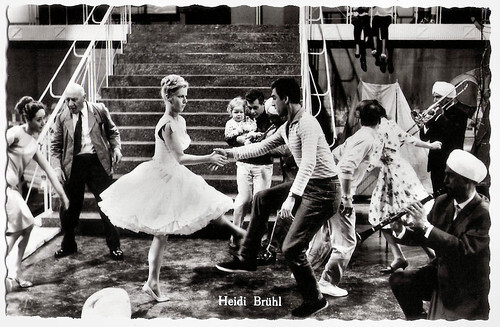
Dutch postcard by N.V. v.h. Weenenk & Snel, Baarn, no. 761. Photo: Gofilex. Heidi Brühl in Immer will ich dich gehören/Always I will be yours (Arno Assmann, 1960) with Peter Weck .
Blonde, blue-eyed schlager singer and film star Heidi Brühl (1942-1991) was called 'the Doris Day of Germany'. In 1963 she was the German participant at the Eurovision Song Contest.
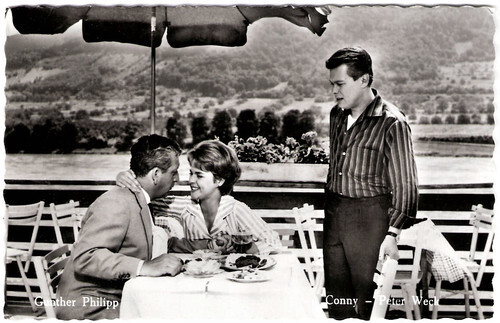
Dutch postcard by N.V. v.h. Weenenk & Snel, Baarn, no. 762. Photo: Günther Philipp, Conny Froboess and Peter Weck in Mariandl (Werner Jacobs, 1961).
Cornelia Froboess (1943) was as 'Conny' a teen idol in the late 1950s and early 1960s. Later she became a respected stage actress. Austrian actor, theatre impresario, and director Peter Weck (1930) appeared in more than 100 films. With his natural acting style in costume dramas and Heimatfilms, he became the Golden Boy from Vienna.
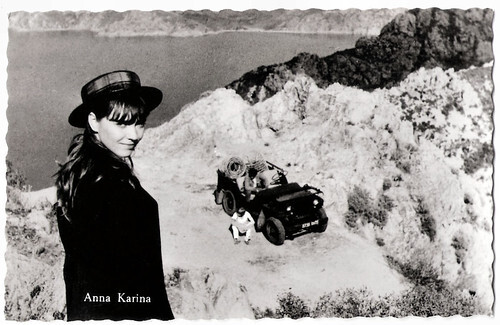
Dutch postcard by N.V. v.h. Weenenk & Snel, Baarn, no. 853. Photo: Hafbo-film. Anna Karina in Le soleil dans l'oeil/Sun in Your Eyes (Jacques Bourdon, 1962).
French, but Danish-born film actress, singer, and director Anna Karina (1940-2019) was the queen of the Nouvelle Vague. Karina was the muse of director Jean-Luc Godard and starred in eight of his films.
Dutch actors
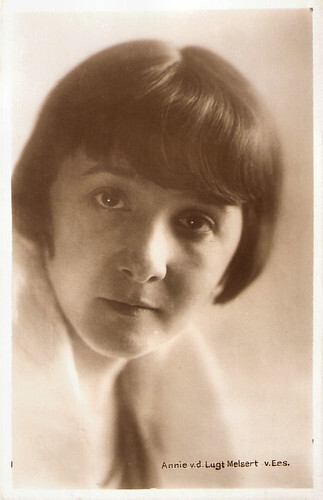
Dutch postcard by Weenenk & Snel, Den Haag. Photo: Willem Coret, Den Haag (The Hague).
Dutch actress Annie van Ees (1893-1970) performed hundreds of times in the stage play 'Boefje' (Little Rascal, 1922). Boefje is a little street boy who is always into mischief but has a heart of gold. In 1935 Annie had already played 'Boefje' 500 times, often together with her husband, stage director Cor van der Lugt Melsert. When Van Ees was 45 and mother, she starred again as Boefje in a Dutch film after the play, Boefje (1939), directed by Detlev Sierck, the future Douglas Sirk.
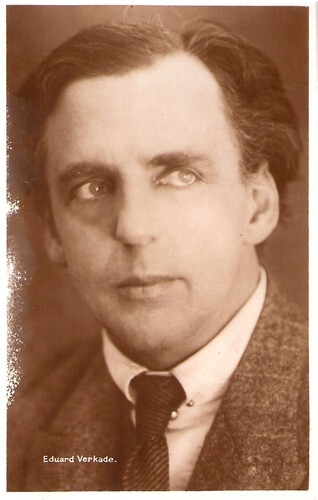
Dutch postcard by Weenenk & Snel, Den Haag. Photo: Willem Coret. Collection: Geoffrey Donaldson Institute.
Dutch actor Eduard Verkade (1878-1961) was one of the actor-directors who revolutionised Dutch theatre in the first decades of the 20th century. He also starred in Dutch films of the 1910s, 1920s, and 1930s.
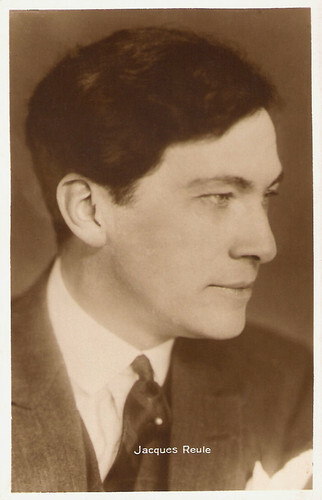
Dutch postcard by Weenenk & Snel, Den Haag. Photo: Willem Coret.
Jacques Reule (1879-1954) was a Dutch stage actor who occasionally played in Dutch films as well. He acted in two Dutch silent films, Pro Domo (Theo Frenkel, 1918) and De duivel in Amsterdam/The Devil in Amsterdam (Theo Frenkel, 1919), and one Dutch sound film, Blokkade/Block cade (Willem de Hoog, 1934).
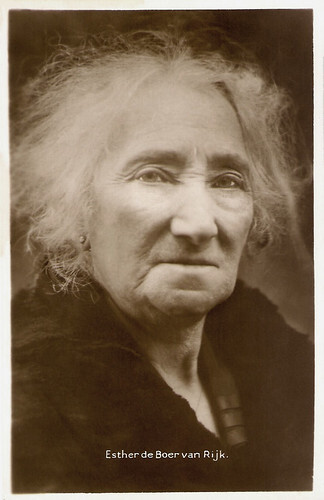
Dutch postcard by Weenenk & Snel, Den Haag. Photo: Willem Coret.
Esther de Boer-van Rijk (1853-1937) was the most popular Dutch actress ever. She was a national icon as the tragic fisherwoman Kniertje in the stage classic 'Op hoop van zegen' (The Good Hope) by Herman Heijermans and played the role again in both a silent (1918) and a sound film version (1934). She also appeared in a dozen other Dutch silent films.
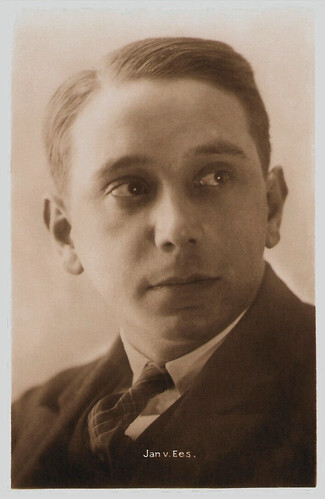
Dutch postcard by Uitgave Weenenk & Snel, Den Haag. Photo: Willem Coret.
Jan van Ees (1896-1966) was a popular Dutch actor, the author of several stage plays, and the brother of Annie van Ees. He was one of the title characters of the Dutch film classic De Jantjes/The Tars (Jaap Speyer, 1934) and starred in several other Dutch films of the 1930s.
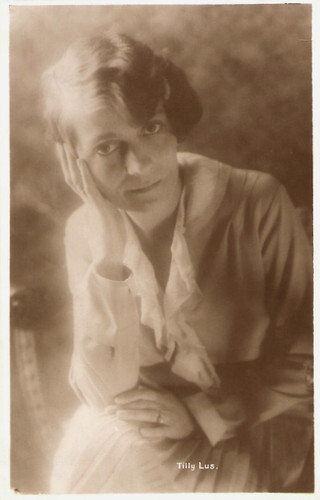
Dutch postcard by Weenenk & Snel, Den Haag (The Hague). Photo: Willem Coret.
Tilly Lus (1888-1971) was one of the great tragedy actresses of Dutch theatre. She also appeared in five silent films, including the first Dutch horror thriller Het Geheim van het Slot Arco/The Secret of Arco Castle (Maurits Binger, Jan van Dommelen, 1915), a Hollandia Filmfabriek production, filmed in Austria.
Hollywood in Holland
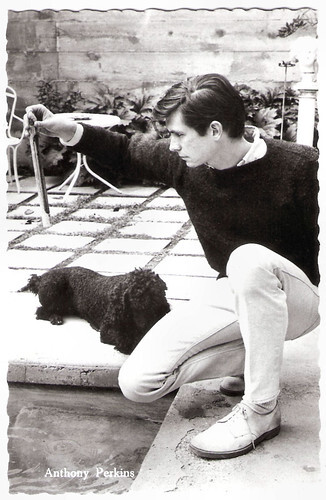
Dutch postcard by N.V. v.h. Weenenk & Snel, Baarn, no. 861.
Tall and slim American actor Anthony 'Tony' Perkins (1932-1992) is best known for his boyish good looks and his nervous, sweet but often unbalanced characters. Perkins made his screen debut in The Actress (1953) featuring Jean Simmons and was nominated for a Best Supporting Actor Oscar for his second film, the Civil War film Friendly Persuasion (1956). Three years later, he appeared in what would be his most memorable role to date, Norman Bates in Psycho (Alfred Hitchcock, 1960) and later in its three sequels.
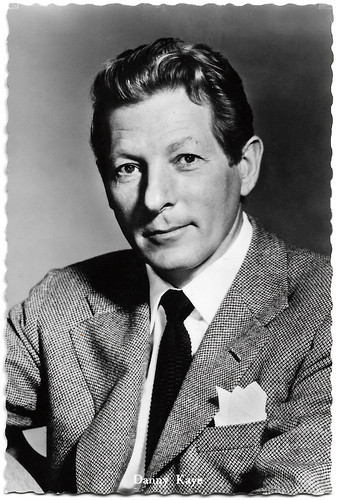
Dutch postcard by N.V. v.h. Weenenk & Snel, Baarn, no. 1060. Photo: M.G.M. Danny Kaye in Merry Andrew (Michael Kidd, 1958). Collection: Geoffrey Donaldson Institute.
Danny Kaye (1911-1987) was an American actor, singer, dancer, comedian, and musician. His performances featured physical comedy, idiosyncratic pantomimes, and tongue-twisting songs. Kaye starred in 17 films like Wonder Man (1945), The Secret Life of Walter Mitty (1947), and White Christmas (1954).
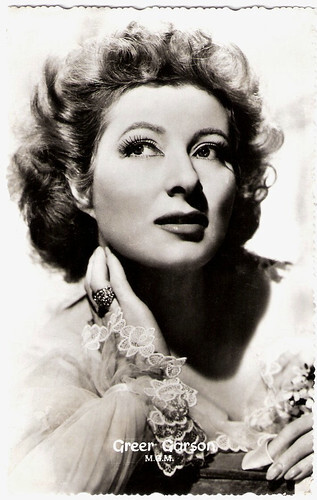
Dutch postcard by Weenenk & Snel, Baarn, no. 1155. Photo: MGM.
British-born actress Greer Garson (1904-1996) was a very popular Hollywood star during World War II. She epitomized a noble, wise, and courageous wife in sleek and sentimental films, often with Walter Pidgeon as her co-star. As one of MGM's major stars of the 1940s, Garson received seven Academy Award nominations. She won the Oscar for Mrs. Miniver (1942), in which she personified the spirit and virtue of a British homemaker in wartime.
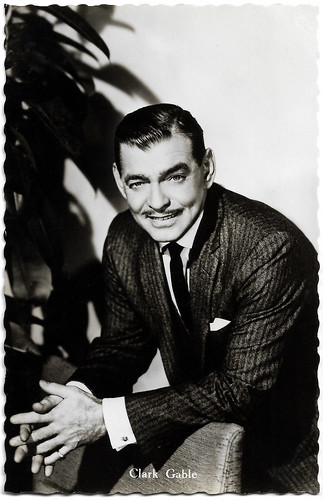
Dutch postcard by N.V. v.h. Weenenk & Snel, Baarn, no. 160 (?). Photo: Paramount. Clark Gable in But Not For Me (Walter Lang, 1959). Collection: Geoffrey Donaldson Institute.
With his natural charm and knowing smile, Clark Gable (1901-1959) was 'The King of Hollywood' during the 1930s. He often portrayed down-to-earth, bravado characters with a carefree attitude, and was seen as the epitome of masculinity. Gable won an Academy Award for Best Actor for It Happened One Night (1934), and was nominated for leading roles in Mutiny on the Bounty (1935) and for his best-known role as Rhett Butler in Gone with the Wind (1939).
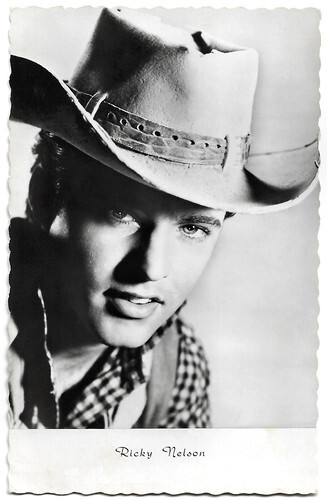
Dutch postcard by N.V. v. h. Weenenk & Snel, Baarn. Ricky Nelson in Rio Bravo (Howard Hawks, 1959).
American singer Ricky Nelson (1940-1985) was one of the first teenage stars in America. He started his career in his parents' television series The Adventures of Ozzie & Harriet. In the late 1950s, he had such hits as 'Hello Mary Lou' and he starred in the Western Rio Bravo (1959) with John Wayne.
European film stars
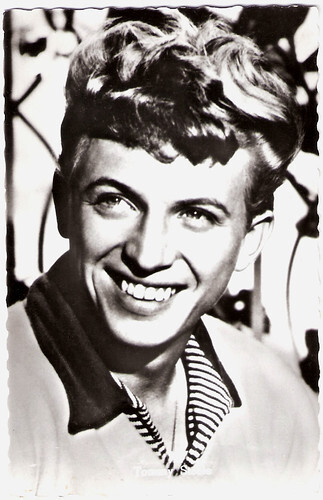
Dutch postcard by N.V. v.h. Weenenk & Snel, Baarn, no. 161. Photo: Centra.
Entertainer Tommy Steele (1936) was Britain's first teen idol and rock 'n roll star. His cheeky Cockney image and boy-next-door looks won him success as a musician, singer, and actor.
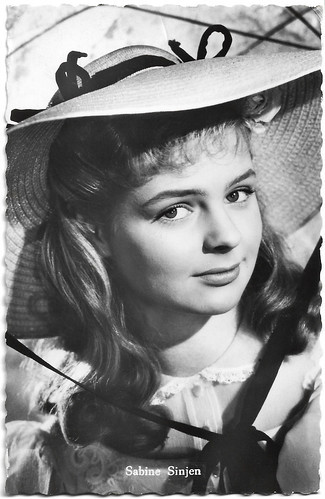
Dutch postcard by N.V. v.h. Weenenk & Snel, Baarn, no. 306. Sabine Sinjen in Alt Heidelberg/Old Heidelberg (Ernst Marischka, 1959). Collection: Geoffrey Donaldson Institute.
German Stage and film actress Sabine Sinjen (1942-1995) was a teenage star of the 1950s, who became a protagonist of the Neue Deutsche Film in the 1960s.
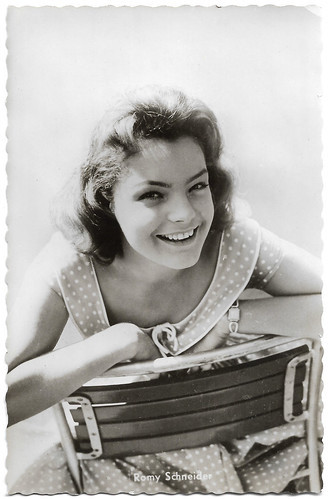
Dutch postcard by N.V. v.h. Weenenk & Snel, Baarn, no. 759 (?). Collection: Geoffrey Donaldson Institute.
Austrian actress Romy Schneider (1938-1982) was one of the most beautiful and intelligent actors of her generation. Thirty years after her death she still has an immense popular appeal.
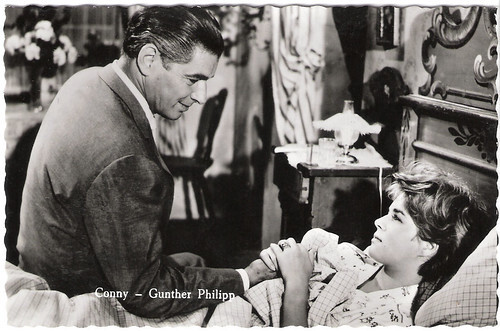
Dutch postcard by N.V. v.h. Weenenk & Snel, Baarn. Photo: Cornelia Froboess in Mariandl (Werner Jacobs, 1961). The man on the postcard is not the mentioned Günther Philipp but Rudolf Prack .
Cornelia Froboess (1943) was a teen idol in the late 1950s and early 1960s who would later become a respected stage actress. Austrian actor Rudolf Prack (1905-1981) was once 'the most often kissed man of the German cinema’. Nowadays he is mainly connected with his Heimatfilms of the 1950s, but his career already started in the middle of the 1930s.
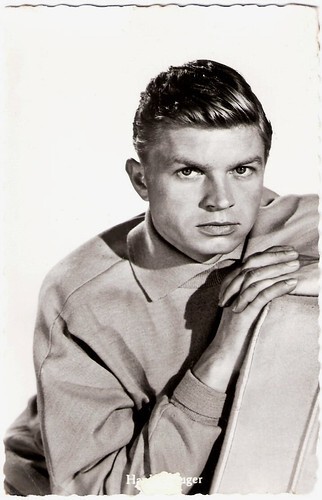
Dutch postcard by NV v.h. Weenenk & Snel, Baarn, no. 759. Photo: Rank Organisation. Hardy Krüger in The One That Got Away (Roy Ward Baker, 1957).
German actor and writer Hardy Krüger (1928-2022) was a blond heartthrob who acted in numerous European films of the 1950s and 1960s and also in several classic American films. He played friendly soldiers and adventurers in numerous German, British and French films and also in some Hollywood classics. Although he often was typecasted as the Aryan Nazi, he hated wearing the brown uniform.
Miscellaneous
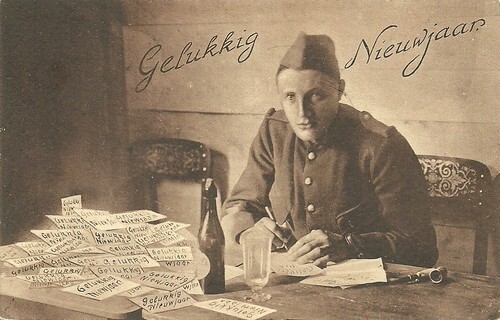
Dutch postcard by Weenenk & Snel, The Hague, no. 14 71448. Postcard mailed in 1921. Caption: Happy New Year.
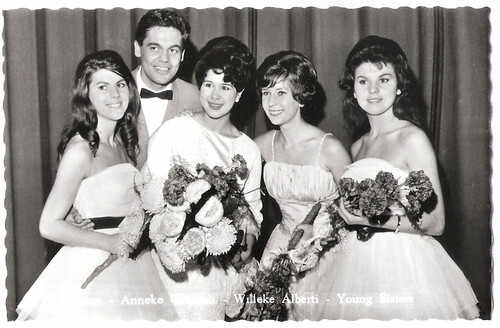
Dutch postcard by N.V. v.h. Weenenk & Snel, Baarn, no. 963. Photo: Phonogram / Philips. Dutch pop stars Johnny Lion , Anneke Grönloh, Willeke Alberti and The Young Sisters.
Source: Lodewijk van Duuren (VDP - Dutch).

Dutch postcard by Uitg. N.V. v.h. Weenenk & Snel, Baarn, no. 133.
Beautiful Myléne Demongeot (1936) became in 1957 one of the blond sex symbols of the French cinema when she seduced Yves Montand in Les sorcières de Salem. The coquettish French actress would go on to co-star in the three Fantômas adventures and many other European films of the 1950s and 1960s. In the 1980s she also became a producer.

Dutch postcard by N.V. v.h. Weenenk & Snel, Baarn, no. 661. Photo: MGM. Steve Reeves in Morgan il pirata/Morgan the Pirate (André De Toth, Primo Zeglio, 1960).
Handsome, musclebound Steve Reeves (1926-2000) was an American bodybuilder and actor, who was a huge success in Hercules (1958) and other Peplum films, the Italian sword-and-sandal epics. At the peak of his career, around 1960, he was reputedly the highest-paid actor in Europe.

Dutch postcard by N.V. v.h. Weenenk & Snel, Baarn, no. 761. Photo: Gofilex. Heidi Brühl in Immer will ich dich gehören/Always I will be yours (Arno Assmann, 1960) with Peter Weck .
Blonde, blue-eyed schlager singer and film star Heidi Brühl (1942-1991) was called 'the Doris Day of Germany'. In 1963 she was the German participant at the Eurovision Song Contest.

Dutch postcard by N.V. v.h. Weenenk & Snel, Baarn, no. 762. Photo: Günther Philipp, Conny Froboess and Peter Weck in Mariandl (Werner Jacobs, 1961).
Cornelia Froboess (1943) was as 'Conny' a teen idol in the late 1950s and early 1960s. Later she became a respected stage actress. Austrian actor, theatre impresario, and director Peter Weck (1930) appeared in more than 100 films. With his natural acting style in costume dramas and Heimatfilms, he became the Golden Boy from Vienna.

Dutch postcard by N.V. v.h. Weenenk & Snel, Baarn, no. 853. Photo: Hafbo-film. Anna Karina in Le soleil dans l'oeil/Sun in Your Eyes (Jacques Bourdon, 1962).
French, but Danish-born film actress, singer, and director Anna Karina (1940-2019) was the queen of the Nouvelle Vague. Karina was the muse of director Jean-Luc Godard and starred in eight of his films.
Dutch actors

Dutch postcard by Weenenk & Snel, Den Haag. Photo: Willem Coret, Den Haag (The Hague).
Dutch actress Annie van Ees (1893-1970) performed hundreds of times in the stage play 'Boefje' (Little Rascal, 1922). Boefje is a little street boy who is always into mischief but has a heart of gold. In 1935 Annie had already played 'Boefje' 500 times, often together with her husband, stage director Cor van der Lugt Melsert. When Van Ees was 45 and mother, she starred again as Boefje in a Dutch film after the play, Boefje (1939), directed by Detlev Sierck, the future Douglas Sirk.

Dutch postcard by Weenenk & Snel, Den Haag. Photo: Willem Coret. Collection: Geoffrey Donaldson Institute.
Dutch actor Eduard Verkade (1878-1961) was one of the actor-directors who revolutionised Dutch theatre in the first decades of the 20th century. He also starred in Dutch films of the 1910s, 1920s, and 1930s.

Dutch postcard by Weenenk & Snel, Den Haag. Photo: Willem Coret.
Jacques Reule (1879-1954) was a Dutch stage actor who occasionally played in Dutch films as well. He acted in two Dutch silent films, Pro Domo (Theo Frenkel, 1918) and De duivel in Amsterdam/The Devil in Amsterdam (Theo Frenkel, 1919), and one Dutch sound film, Blokkade/Block cade (Willem de Hoog, 1934).

Dutch postcard by Weenenk & Snel, Den Haag. Photo: Willem Coret.
Esther de Boer-van Rijk (1853-1937) was the most popular Dutch actress ever. She was a national icon as the tragic fisherwoman Kniertje in the stage classic 'Op hoop van zegen' (The Good Hope) by Herman Heijermans and played the role again in both a silent (1918) and a sound film version (1934). She also appeared in a dozen other Dutch silent films.

Dutch postcard by Uitgave Weenenk & Snel, Den Haag. Photo: Willem Coret.
Jan van Ees (1896-1966) was a popular Dutch actor, the author of several stage plays, and the brother of Annie van Ees. He was one of the title characters of the Dutch film classic De Jantjes/The Tars (Jaap Speyer, 1934) and starred in several other Dutch films of the 1930s.

Dutch postcard by Weenenk & Snel, Den Haag (The Hague). Photo: Willem Coret.
Tilly Lus (1888-1971) was one of the great tragedy actresses of Dutch theatre. She also appeared in five silent films, including the first Dutch horror thriller Het Geheim van het Slot Arco/The Secret of Arco Castle (Maurits Binger, Jan van Dommelen, 1915), a Hollandia Filmfabriek production, filmed in Austria.
Hollywood in Holland

Dutch postcard by N.V. v.h. Weenenk & Snel, Baarn, no. 861.
Tall and slim American actor Anthony 'Tony' Perkins (1932-1992) is best known for his boyish good looks and his nervous, sweet but often unbalanced characters. Perkins made his screen debut in The Actress (1953) featuring Jean Simmons and was nominated for a Best Supporting Actor Oscar for his second film, the Civil War film Friendly Persuasion (1956). Three years later, he appeared in what would be his most memorable role to date, Norman Bates in Psycho (Alfred Hitchcock, 1960) and later in its three sequels.

Dutch postcard by N.V. v.h. Weenenk & Snel, Baarn, no. 1060. Photo: M.G.M. Danny Kaye in Merry Andrew (Michael Kidd, 1958). Collection: Geoffrey Donaldson Institute.
Danny Kaye (1911-1987) was an American actor, singer, dancer, comedian, and musician. His performances featured physical comedy, idiosyncratic pantomimes, and tongue-twisting songs. Kaye starred in 17 films like Wonder Man (1945), The Secret Life of Walter Mitty (1947), and White Christmas (1954).

Dutch postcard by Weenenk & Snel, Baarn, no. 1155. Photo: MGM.
British-born actress Greer Garson (1904-1996) was a very popular Hollywood star during World War II. She epitomized a noble, wise, and courageous wife in sleek and sentimental films, often with Walter Pidgeon as her co-star. As one of MGM's major stars of the 1940s, Garson received seven Academy Award nominations. She won the Oscar for Mrs. Miniver (1942), in which she personified the spirit and virtue of a British homemaker in wartime.

Dutch postcard by N.V. v.h. Weenenk & Snel, Baarn, no. 160 (?). Photo: Paramount. Clark Gable in But Not For Me (Walter Lang, 1959). Collection: Geoffrey Donaldson Institute.
With his natural charm and knowing smile, Clark Gable (1901-1959) was 'The King of Hollywood' during the 1930s. He often portrayed down-to-earth, bravado characters with a carefree attitude, and was seen as the epitome of masculinity. Gable won an Academy Award for Best Actor for It Happened One Night (1934), and was nominated for leading roles in Mutiny on the Bounty (1935) and for his best-known role as Rhett Butler in Gone with the Wind (1939).

Dutch postcard by N.V. v. h. Weenenk & Snel, Baarn. Ricky Nelson in Rio Bravo (Howard Hawks, 1959).
American singer Ricky Nelson (1940-1985) was one of the first teenage stars in America. He started his career in his parents' television series The Adventures of Ozzie & Harriet. In the late 1950s, he had such hits as 'Hello Mary Lou' and he starred in the Western Rio Bravo (1959) with John Wayne.
European film stars

Dutch postcard by N.V. v.h. Weenenk & Snel, Baarn, no. 161. Photo: Centra.
Entertainer Tommy Steele (1936) was Britain's first teen idol and rock 'n roll star. His cheeky Cockney image and boy-next-door looks won him success as a musician, singer, and actor.

Dutch postcard by N.V. v.h. Weenenk & Snel, Baarn, no. 306. Sabine Sinjen in Alt Heidelberg/Old Heidelberg (Ernst Marischka, 1959). Collection: Geoffrey Donaldson Institute.
German Stage and film actress Sabine Sinjen (1942-1995) was a teenage star of the 1950s, who became a protagonist of the Neue Deutsche Film in the 1960s.

Dutch postcard by N.V. v.h. Weenenk & Snel, Baarn, no. 759 (?). Collection: Geoffrey Donaldson Institute.
Austrian actress Romy Schneider (1938-1982) was one of the most beautiful and intelligent actors of her generation. Thirty years after her death she still has an immense popular appeal.

Dutch postcard by N.V. v.h. Weenenk & Snel, Baarn. Photo: Cornelia Froboess in Mariandl (Werner Jacobs, 1961). The man on the postcard is not the mentioned Günther Philipp but Rudolf Prack .
Cornelia Froboess (1943) was a teen idol in the late 1950s and early 1960s who would later become a respected stage actress. Austrian actor Rudolf Prack (1905-1981) was once 'the most often kissed man of the German cinema’. Nowadays he is mainly connected with his Heimatfilms of the 1950s, but his career already started in the middle of the 1930s.

Dutch postcard by NV v.h. Weenenk & Snel, Baarn, no. 759. Photo: Rank Organisation. Hardy Krüger in The One That Got Away (Roy Ward Baker, 1957).
German actor and writer Hardy Krüger (1928-2022) was a blond heartthrob who acted in numerous European films of the 1950s and 1960s and also in several classic American films. He played friendly soldiers and adventurers in numerous German, British and French films and also in some Hollywood classics. Although he often was typecasted as the Aryan Nazi, he hated wearing the brown uniform.
Miscellaneous

Dutch postcard by Weenenk & Snel, The Hague, no. 14 71448. Postcard mailed in 1921. Caption: Happy New Year.

Dutch postcard by N.V. v.h. Weenenk & Snel, Baarn, no. 963. Photo: Phonogram / Philips. Dutch pop stars Johnny Lion , Anneke Grönloh, Willeke Alberti and The Young Sisters.
Source: Lodewijk van Duuren (VDP - Dutch).
Published on May 14, 2022 22:00
May 13, 2022
Written by Charles Dickens
Charles Dickens (1812-1870) was one of the most important English writers during the Victorian era and the first literary chronicler of the metropolis in the midst of the Industrial Revolution. He became famous with 'The Pickwick Papers', which appeared monthly from 1836 onwards. It was followed by 'Oliver Twist' in 1837-1838, 'Nicholas Nickleby' in 1838-1839, 'The Old Curiosity Shop' and 'Barnaby Rudge', both in 1841. Other famous novels are the partly autobiographical 'David Copperfield' (1849-1850), 'Great Expectations' (1860-1861), and 'A Christmas Carol' (1843). 'A Tale of Two Cities' is the world's seventh best-selling book with 200 million copies. His last novel, "The Mystery of Edwin Drood", was never completed and was later published posthumously. Characteristics of Dickens' stories are the social evils, the story structure, the cartoonish characters, and the humour. The first feature-length film adaptation was a 1913 version of 'David Copperfield' directed by Thomas Bentley for producer Cecil Hepworth. In the years since the prolific author has never ceased to be an inspiration for filmmakers—dozens of adaptations of his work have made their way to the screen.
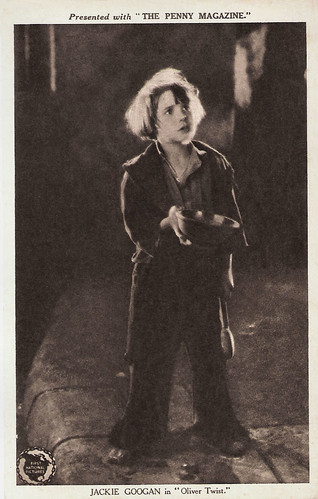
British postcard presented with The Penny Magazine. Photo: First National. Jackie Coogan in Oliver Twist (Frank Lloyd, 1922).
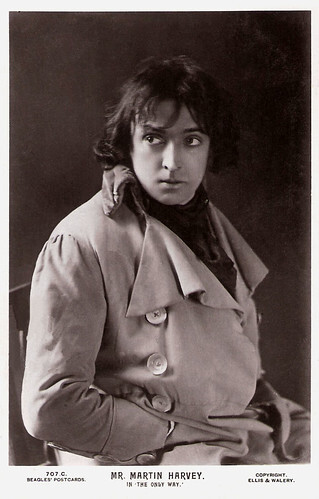
British postcard by Beagles Postcards, no. 707 C. Photo: Ellis & Walery. British Actor-manager Sir John Martin Harvey (1863-1944) was one of the last great romantic actors of the English theatre. His most famous play was 'The Only Way' (1899), an adaptation of Charles Dickens' 'A Tale of Two Cities'. 25 years later, he also featured in the film version when he was a sprightly 62 year-old.
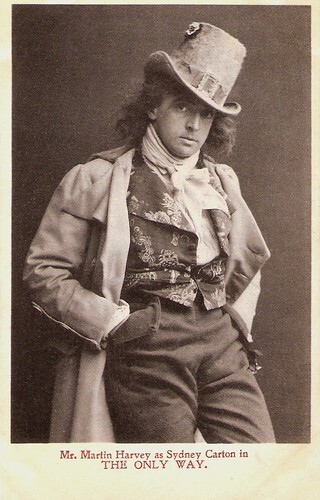
British postcard by the London Stereoscope Company. Photo: John Martin Harvey in The Only Way.
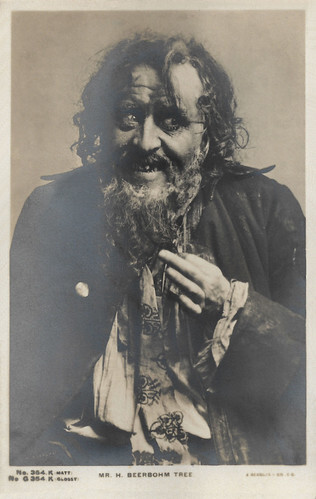
British postcard by J. Beagles & Co., London, no. 354. Photo: F.W. Burford. Herbert Beerbohm Tree as Fagin in 'Oliver Twist' by Charles Dickens.
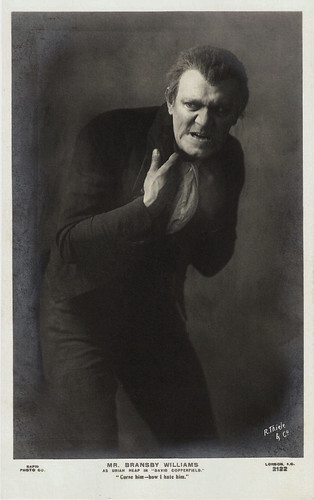
British postcard by Rapid Photo co., London, no. 3122 Photo: R. Thiele & Co. Publicity still for a stage production of David Copperfield with Bransby Williams as Uriah Heep. Caption: "Curse him - how I hate him." British comic actor and writer Bransby Williams (1870-1961) was on stage from the 1890s and often worked as a monologist and impersonator. From 1911 on, he played roles in more than 20 films. He is best known for his portraying various Charles Dickens characters.
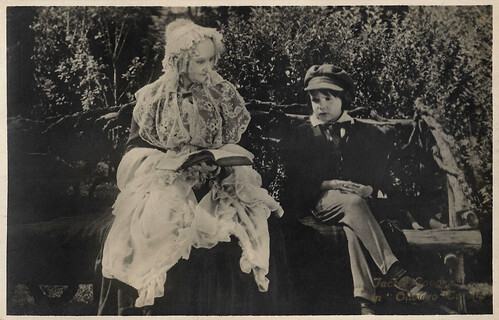
Italian postcard by Fotominio / G. B. Falci, Milano. Photo: Jackie Coogan in Oliver Twist (Frank Lloyd, 1922).
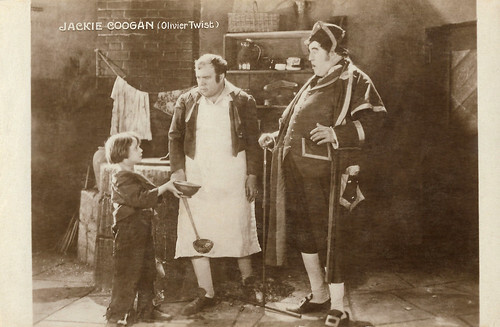
French postcard by Cinémagazine-Edition. Photo: Jackie Coogan in Oliver Twist (Frank Lloyd, 1922).
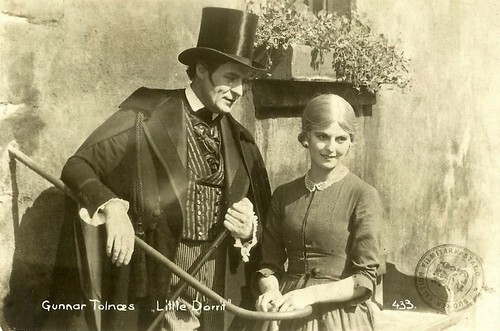
Finnish postcard, no. 433. The postcard carries a stamp from the Finnish film inspection office. Photo: Karina Bell as Little Dorrit and Gunnar Tolnaes as Arthur Clennam in the Charles Dickens adaptation Lille Dorritt/Little Dorrit (A.W. Sandberg, 1924), Dickens's rags-to-riches (and over again) story of a woman raised in a debtor's prison and her complex, fascinating life.

German postcard by Ross Verlag, no. 8717, 1933-1934. Photo: Ondra-Lamac-Film. Anny Ondra in Klein Dorrit/Little Dorrit (Carl Lamac, 1934).
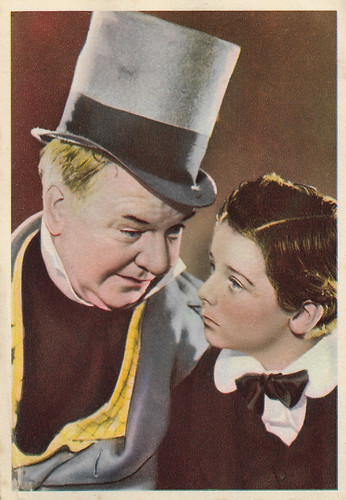
British postcard by De Reszke Cigarettes, no. 6. Photo: Metro-Goldwyn-Mayer (MGM). W.C. Fields and Freddie Bartholomew in David Copperfield (George Cukor, 1935). This George Cukor adaptation makes exceptional work of condensing the story down to just over two hours. Full of enthusiastic turns from 'big' actors, particularly W.C. Fields as Mr. Micawber.
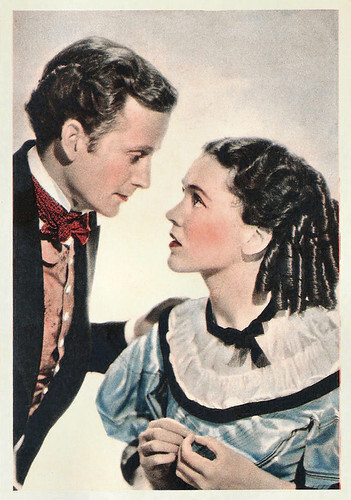
British postcard for Abdulla Cigarettes, no. 38. Photo: M.G.M. Frank Lawton and Maureen O'Sullivan in David Copperfield (George Cukor, 1935).

British postcard by Rotary Photo, London, no. F.S. 18. Caption: John Mills with his small daughter 'Bunch' (Juliet Mills) in the studio. The picture was taken during the shooting of Great Expectations (David Lean, 1946). At the time, Bunch must have been four years old.
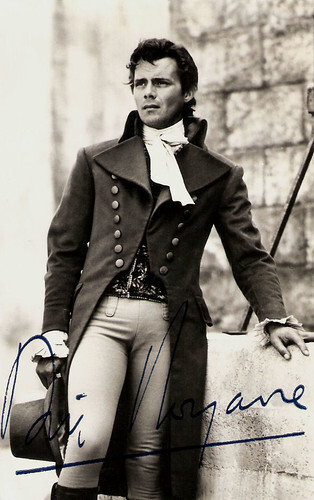
British postcard. Photo: Rank. Dirk Bogarde in A Tale of Two Cities (Ralph Thomas, 1958), set in London and Paris in the lead up to the French Revolution. The task of adapting this notoriously difficult story was given to T.E.B. Clarke, best remembered as a writer of Ealing comedies. The role of Sydney Carton, the drunken lawyer who becomes a self-sacrificing melodramatic hero, was played by Dirk Bogarde at the height of his matinee-idol fame.
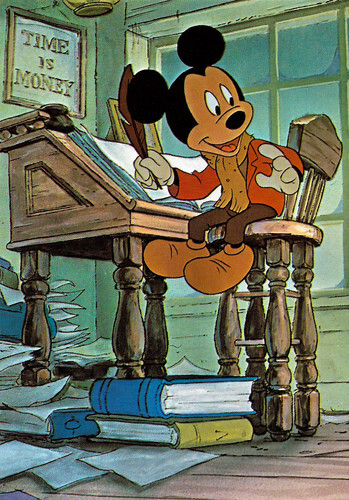
Italian postcard by Grafiche Biondetti srl, Verona, no. 133/4. Illustration: Walt Disney Productions. Film image of Mickey's Christmas Carol (Burny Mattinson, 1983). At 26 minutes Mickey's Christmas Carol is technically a short, but it was released in cinemas, so we're having it. Scrooge McDuck obviously takes the role of Ebeneezer Scrooge, with beloved Disney characters making up the rest of the cast. The animation is beautiful and the Disney humour marries well with Dickens' story.

French postcard by MB, Paris, no. D 640, 5/4. Image: Disney. Publicity still for Oliver & Co. (1988). Oliver & Company (George Scribner, 1988) is the twenty-seventh animated feature released in the Disney Canon. It was inspired by Charles Dickens's 'Oliver Twist' (1838).
Sources: Liz Cantrell and Adam Rathe (Town & Country), Wikipedia (Dutch), and .

British postcard presented with The Penny Magazine. Photo: First National. Jackie Coogan in Oliver Twist (Frank Lloyd, 1922).

British postcard by Beagles Postcards, no. 707 C. Photo: Ellis & Walery. British Actor-manager Sir John Martin Harvey (1863-1944) was one of the last great romantic actors of the English theatre. His most famous play was 'The Only Way' (1899), an adaptation of Charles Dickens' 'A Tale of Two Cities'. 25 years later, he also featured in the film version when he was a sprightly 62 year-old.

British postcard by the London Stereoscope Company. Photo: John Martin Harvey in The Only Way.

British postcard by J. Beagles & Co., London, no. 354. Photo: F.W. Burford. Herbert Beerbohm Tree as Fagin in 'Oliver Twist' by Charles Dickens.

British postcard by Rapid Photo co., London, no. 3122 Photo: R. Thiele & Co. Publicity still for a stage production of David Copperfield with Bransby Williams as Uriah Heep. Caption: "Curse him - how I hate him." British comic actor and writer Bransby Williams (1870-1961) was on stage from the 1890s and often worked as a monologist and impersonator. From 1911 on, he played roles in more than 20 films. He is best known for his portraying various Charles Dickens characters.

Italian postcard by Fotominio / G. B. Falci, Milano. Photo: Jackie Coogan in Oliver Twist (Frank Lloyd, 1922).

French postcard by Cinémagazine-Edition. Photo: Jackie Coogan in Oliver Twist (Frank Lloyd, 1922).

Finnish postcard, no. 433. The postcard carries a stamp from the Finnish film inspection office. Photo: Karina Bell as Little Dorrit and Gunnar Tolnaes as Arthur Clennam in the Charles Dickens adaptation Lille Dorritt/Little Dorrit (A.W. Sandberg, 1924), Dickens's rags-to-riches (and over again) story of a woman raised in a debtor's prison and her complex, fascinating life.

German postcard by Ross Verlag, no. 8717, 1933-1934. Photo: Ondra-Lamac-Film. Anny Ondra in Klein Dorrit/Little Dorrit (Carl Lamac, 1934).

British postcard by De Reszke Cigarettes, no. 6. Photo: Metro-Goldwyn-Mayer (MGM). W.C. Fields and Freddie Bartholomew in David Copperfield (George Cukor, 1935). This George Cukor adaptation makes exceptional work of condensing the story down to just over two hours. Full of enthusiastic turns from 'big' actors, particularly W.C. Fields as Mr. Micawber.

British postcard for Abdulla Cigarettes, no. 38. Photo: M.G.M. Frank Lawton and Maureen O'Sullivan in David Copperfield (George Cukor, 1935).

British postcard by Rotary Photo, London, no. F.S. 18. Caption: John Mills with his small daughter 'Bunch' (Juliet Mills) in the studio. The picture was taken during the shooting of Great Expectations (David Lean, 1946). At the time, Bunch must have been four years old.

British postcard. Photo: Rank. Dirk Bogarde in A Tale of Two Cities (Ralph Thomas, 1958), set in London and Paris in the lead up to the French Revolution. The task of adapting this notoriously difficult story was given to T.E.B. Clarke, best remembered as a writer of Ealing comedies. The role of Sydney Carton, the drunken lawyer who becomes a self-sacrificing melodramatic hero, was played by Dirk Bogarde at the height of his matinee-idol fame.

Italian postcard by Grafiche Biondetti srl, Verona, no. 133/4. Illustration: Walt Disney Productions. Film image of Mickey's Christmas Carol (Burny Mattinson, 1983). At 26 minutes Mickey's Christmas Carol is technically a short, but it was released in cinemas, so we're having it. Scrooge McDuck obviously takes the role of Ebeneezer Scrooge, with beloved Disney characters making up the rest of the cast. The animation is beautiful and the Disney humour marries well with Dickens' story.

French postcard by MB, Paris, no. D 640, 5/4. Image: Disney. Publicity still for Oliver & Co. (1988). Oliver & Company (George Scribner, 1988) is the twenty-seventh animated feature released in the Disney Canon. It was inspired by Charles Dickens's 'Oliver Twist' (1838).
Sources: Liz Cantrell and Adam Rathe (Town & Country), Wikipedia (Dutch), and .
Published on May 13, 2022 22:00
Paul van Yperen's Blog
- Paul van Yperen's profile
- 13 followers
Paul van Yperen isn't a Goodreads Author
(yet),
but they
do have a blog,
so here are some recent posts imported from
their feed.



